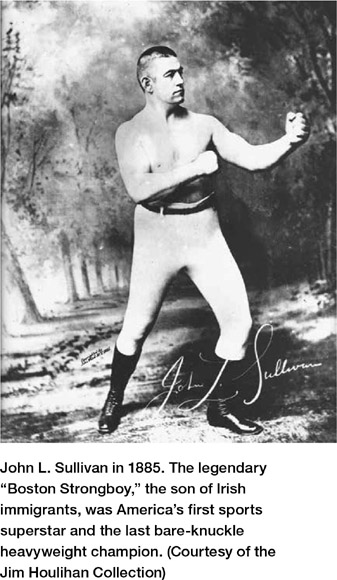
Benny Leonard moved with the grace of a ballet dancer and wore an air of arrogance that belonged to royalty.
—DAN PARKER, NEW YORK SPORTSWRITER1
Perhaps the most famous date in boxing history is September 7, 1892. In the first heavyweight championship fight conducted under Marquess of Queensberry rules, James J. “Gentleman Jim” Corbett knocked out defending champion John L. Sullivan (“The Boston Strong-boy”) in the 21st round of a fight to the finish. The historic event took place in New Orleans in front of 20,000 spectators. Both fighters wore five-ounce leather gloves.
Sullivan, the son of Irish immigrants, was the nation’s first sports superstar. He won the bareknuckle heavyweight championship in 1882 and held the title for 10 years. The powerfully built champion stood five feet, ten inches tall and weighed about 200 pounds in his prime. A man with a prodigious appetite for food and liquor, and the ego to match, Sullivan was famous for entering saloons and bellowing, “I can beat any sonofabitch in the house.” America loved him.
“Gentleman Jim” Corbett, a 26-year-old former bank clerk, stood a shade over six feet and tipped the scales at 180 pounds. A superb athlete and former amateur boxing star, he was the quintessential “Fancy Dan”–type boxer, relying heavily on speed, timing, accurate jabs, evasive footwork, and skillful counterpunching to wear down opponents.
Sullivan, 34 years old, had not defended his title in three years. Nevertheless, the hugely popular champion was still considered invincible. Corbett’s great victory over the legendary champion was a shocking upset that signaled the beginning of a new era for the sport. From that moment on virtually all boxing matches would be conducted using Marquess of Queensberry rules. The bare-knuckle era of prizefighting had officially come to an end.

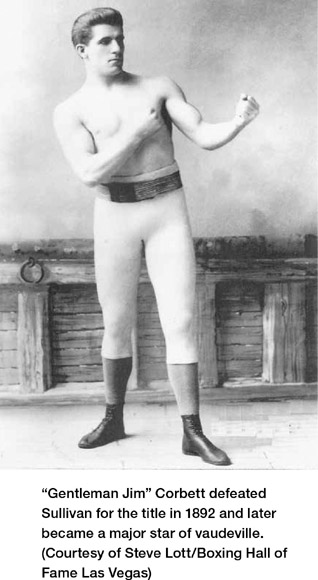
Unlike the brash, boisterous, and hard-drinking Sullivan, Corbett was an elegant and refined individual who helped to transform boxing into a respectable sport. With his matinee-idol looks Corbett parlayed the championship into a successful career in vaudeville, eventually becoming one of the highest-paid stage actors of his day.2
Corbett’s clever style of boxing influenced other fighters to adopt a more-cerebral approach to the game, and it is not inaccurate to label him the father of modern scientific boxing. But old traditions die hard. Many boxers continued to advance and retreat in a straight line while attempting to land hard singular punches. Another holdover from the bare-knuckle era was the “finish fight” that allowed a bout to continue indefinitely until one of the contestants was either knocked out or disqualified. Finish fights remained in vogue until the early 1900s. They were eventually phased out, but taking their place for a time were marathon contests scheduled for 25 or 45 rounds.
Boxers preparing for a marathon contest trained and fought with the distance in mind. Pacing was extremely important. There was always the danger of expending too much energy too soon. Marathon bouts followed a familiar pattern. After a few moments of sparring an attempt was made to land one or two quick punches, after which the fighters fell into a clinch and continued close-quarter infighting interspersed with a great deal of pushing, pulling, and tugging on the arms. At the referee’s discretion the boxers were separated and the process would begin again. The purpose of this strategy was to gradually wear down an opponent over the long haul. A fighter showing signs of fatigue would be the signal for his adversary to pick up the pace and try for a knockout.3
After 1910 boxing contests scheduled for more than 20 rounds were rare. For a while some cities and states went to the opposite extreme by limiting all professional bouts to not more than four or six rounds, as was the case in Philadelphia and California. As a result, the tempo of fights speeded up and boxing styles became more fluid and rhythmic. Mobile footwork took on added significance as fighters realized that constant movement was not only a good defensive strategy, but also presented more opportunities to set up a variety of combination punches. With the elimination of marathon bouts it was no longer necessary to “coast” for several rounds in order to conserve energy, as was the case in fights exceeding 20 rounds.
From an economic standpoint the shorter contests also made it easier for boxers to compete more often and earn additional paydays. Even die-hard bare-knuckle fans had to admit that boxing had become a faster, more interesting, and more enjoyable sport to watch.
As with any new art form—and make no mistake, Queensberry boxing had transformed the sport into a new art form—there is always a small group of pioneers who exhibit a singular genius for their craft and set the standard for later generations. Some of the greatest boxers who ever lived reached their primes during the first two decades of the twentieth century. “Sweet scientists”—boxers with especially skillful techniques—such as Joe Gans, Abe Attell, Sam Langford, Joe Walcott, Jack Johnson, Jack Blackburn, Owen Moran, Freddie Welsh, Jem Driscoll, Packey McFarland, Mike Gibbons, and Benny Leonard—were among a small group of brilliant innovators who would have stood out at any time. The few existing films of these early pioneers bear witness to their extraordinary boxing skills.
Boxing’s growing popularity in America during the early years of the last century did not deter government authorities and social reformers from attempting to outlaw the sport, primarily because of its association with gambling, and the view that public displays of violence were immoral.
Nevertheless, a total ban was difficult to enforce. Enterprising promoters skirted laws that banned boxing in their states or municipalities by staging sparring “exhibitions” for private club members. The price of admission made the purchaser a member of the club, albeit for one night only. The majority of these bouts were authentic boxing contests with each competitor doing his best to win.
Yet even in places where professional boxing was both legal and popular, the sport was never more than a scandal or two away from being banned. A compromise of sorts was reached with the creation of the so-called “no-decision” rule. The rule mandated that unless a bout ended in a knockout there would be no winner or loser declared. No-decision bouts were intended to discourage gambling and rid the sport of crooked referees, judges, and fixed fights.
At least a dozen states adhered to the no-decision rule from about 1910 to 1925. The policy was frustrating to both boxers and fans. A champion could be dominated by a worthy challenger yet still retain his title as long as he stayed on his feet to the final bell. Any fighter who realized he was overmatched or just didn’t feel like extending himself could stall, clinch, and backpedal to the final bell. By avoiding a knockout an official loss would not be posted to his record.
No-decision bouts (indicated by the letters “ND” in the record books) failed to curtail gambling. In order to satisfy bets gamblers agreed to abide by the opinions of a consensus of sports-writers as reported in the next day’s newspapers. Therefore the letters “ND” came to also stand for “newspaper decision.”
Over the past 20 years dedicated researchers affiliated with the International Boxing Research Organization (IBRO) have spent countless hours tracking down these newspaper reports in an effort to try and determine the actual winner of thousands of no-decision bouts that did not end in a knockout. The results are posted on the Boxrec.com Internet site. (Even though newspaper decisions cannot be considered “official,” and the opinions of the sportswriters not always reliable or accurate, I have decided to include the newspaper verdicts, when available, in the records of the boxers who appear in this book.)
Prior to 1921 a boxer’s contender status, or his designation as a world champion, was not dependent on a sanctioning organization. Rather, it was determined by his record against quality opponents with established reputations. In either case it was acceptance by the press and public that was key to a fighter’s recognition factor. Of course, imperfections existed. There was the problem of no-decision bouts and of some deserving fighters being denied the opportunity to challenge for a title despite their excellent records. The latter injustice applied especially to several great black boxers, most notably Sam Langford.
Yet, despite its flaws, the system worked to the extent that a boxer could not enter the golden circle of top contenders without first establishing legitimate credentials by defeating other quality boxers. Any claim to a title by a fighter whose accomplishments in the ring did not measure up to that standard would be ignored.
When boxing reached unprecedented levels of popularity in the 1920s, a more-formalized structure was called for. In 1921 the powerful New York State Athletic Commission and the newly formed National Boxing Association (a loose confederation of 23 state boxing commissions, soon to expand to 43) gave their imprimatur to boxers who they felt deserved the title of “world champion.”
Boxing has always been a difficult sport to regulate. Even during the best of times there were disparate claims and counterclaims of men purporting to be world champions. Nevertheless, from the 1890s to the 1960s the boxing establishment was able to maintain a semblance of order when it came to anointing legitimate world champions. Before boxing’s traditional organizational structure fell apart in the late 1970s— and became hopelessly Balkanized by a gaggle of competing quasi-official boxing authorities doling out scores of title belts—there was much less confusion as to who deserved the title of “world champion.” Prior to the 1970s a fighter who won a title recognized by either the National Boxing Association, New York State Athletic Commission, or the European Boxing Union, was considered a legitimate champion. More often than not, all of these organizations recognized the same world champion.
Beginning in 1914 large numbers of Southern blacks began to migrate north to escape racial violence and to seek greater opportunities for employment and a higher standard of living. The exodus continued into the 1920s and ’30s.
Eventually some two million (over 20 percent of the South’s black population) moved from the rural South to the industrial North. In Chicago the black population more than tripled in a decade.4 Like the first- and second-generation European immigrants, some chose to make their living as boxers to escape the ghetto and perhaps get rich. By the 1930s there were nearly 2,000 black professional boxers in the United States.5
Despite their hopes for a better way of life, most blacks in Northern cities continued to live at or below the poverty level. Buying a ticket to see a boxing show was a luxury few could afford. Without the support of a substantial fan base, African-American fighters had no economic leverage when attempting to obtain a title bout, since white audiences made up the majority of spectators. With the exception of a few crossover stars, there was no economic benefit for a promoter to risk a popular white champion’s title against a black fighter who, if he won, would not bring in the crowds.
Between 1890 and 1936 only 12 black fighters won a world title as compared to more than 100 white/Anglo fighters of several different nationalities.6 While it is true there were many more white prizefighters at the time, several highly ranked black contenders were denied the opportunity to fight for a championship, or, when granted the opportunity, were often the victims of wrongful decisions favoring a white opponent. Sometimes black fighters of the era had to agree in advance to take a dive or “carry” a good local boxer in order to get a payday or secure future bouts.
Heavyweight contenders had an especially tough time in the aftermath of the controversial reign of Jack Johnson, the first African-American heavyweight champion (1908–1915). Johnson, the son of ex-slaves, was the most famous black person of his day, and also the most controversial. He lived by his own rules and wanted nothing more than to be treated as an equal to any white man. But he antagonized much of white America by not only winning the world’s most prestigious sports title, but also by blatantly defying the Jim Crow conventions of his era. He was married twice to white women, lived extravagantly, was outspoken, and enjoyed taunting white challengers in the ring (all of whom could not lay a glove on him). During his tenure as heavyweight champion he famously hired a white chauffeur to drive him around.
Ironically, after winning the championship Johnson refused to risk it against two other great black boxers, Sam Langford and Joe Jeanette. Although he defeated both men prior to winning the championship, they were still considered his toughest challengers. Instead, Johnson preferred to defend his title—and earn more money—by facing a series of less-talented white challengers.
Johnson could not be defeated in the ring, but the courts were another matter. In 1912 the government accused him of violating the Mann Act (bringing a woman across state lines “for immoral purposes”). An all-white jury convicted Johnson on the trumped-up charges and he was sentenced to a year in prison. While out on bail pending an appeal, Johnson fled to Canada, and then to Europe. In 1915, while still in exile, he lost the title to “White Hope” Jess Willard in Havana, Cuba. More than two decades would pass before another black man would have the opportunity to fight for the heavyweight championship.
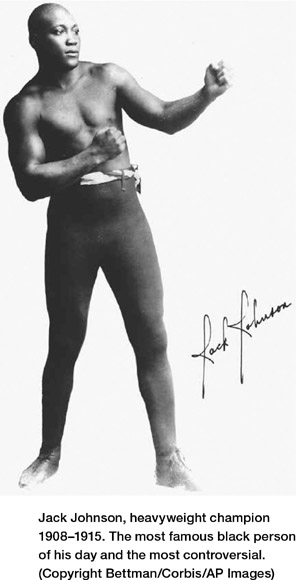
Johnson returned to the United States in 1920 and served out a one-year sentence in a federal prison.
In 2013, for the third time in less than a decade, a bipartisan group of US lawmakers sent a resolution to the president’s desk, urging him to grant Jack Johnson a posthumous pardon. If granted, the pardon would rectify a historical wrong and clear Johnson’s name for a criminal conviction that was obviously based on racism.
Even though it was impossible to completely bypass the blatant racism and elitist attitudes of the era, no other professional sport was more receptive to black athletes. Prior to 1947, when baseball finally allowed the great Jackie Robinson to integrate the major leagues, boxing was the only major professional sport that was open to African-American athletes, and was one of the few professions that gave black people access to the type of wealth and fame that would have been unthinkable a generation earlier. That fact in no way diminishes the humiliations and privations they suffered as second-class citizens. It should also be noted that not all white champions or top contenders avoided meeting highly rated black boxers. Jewish champions Benny Leonard and Maxie Rosenbloom were among those who unhesitatingly faced the finest black contenders both before and during their title reigns. It is a matter of record that Rosenbloom fought more black boxers (70) than any other white fighter of the 1930s.
During America’s participation in World War I (1917–1918), boxing was used to entertain and condition American soldiers and sailors. Famous boxers such as Benny Leonard, Johnny Kilbane, Freddie Welsh, Johnny Coulon, and Mike and Tommy Gibbons led mass exercise drills and participated in exhibition bouts on military bases.
The “War to End All Wars” came to an end on November 11, 1918, but it would be months before millions of Allied soldiers stationed in France could be sent home. An American Expeditionary Force (AEF) boxing tournament proved to be very popular with the doughboys and military brass. The army’s director of athletics suggested an even bigger Olympic-style sports tournament that would involve all the nations that had fought on the Allied side. The idea was to keep the doughboys and other Allied soldiers entertained, “to avoid the peace-time threat to the moral standards and conduct of idle troops waiting to be discharged.” Soldiers of the 29 nations who fought on the Allied side were invited to compete. Eighteen nations accepted the invitation. The tournament was open to both amateur and professional athletes.7
The French government welcomed the idea and authorized the building of a stadium in Paris with a seating capacity of 25,000. The structure was built by the US military in cooperation with the YMCA and was named Pershing Stadium, after the renowned general who led the American Expeditionary Force.8
Of the 14 Olympic events in the “Inter-Allied Games,” none was more popular than boxing. The huge number of preliminary bouts over the five months leading up to the finals drew thousands of competitors into the ring. Three of the seven weight-division championships were won by Americans.
The results of the boxing tournament were reported daily in the American press and proved to be a public relations bonanza for the sport. The success of the tournament was instrumental in helping to legalize boxing throughout the United States. As Jeffrey T. Sammons notes in Beyond the Ring: The Role of Boxing in American Society, the tournament “legitimated the martial arts and fused boxing with patriotism. . . . After the horrors of mustard gas, bombs, mortars and machine guns, boxing represented a more simple and noble past, with men in control of their destiny. Indeed, the barbarism of real war made boxing seem dignified, if not dainty.”9
Most of the boxers who appear in this chapter fought at weights ranging from 118 to 160 pounds. This is not surprising, since prior to 1920, most men, on average, weighed below 160 pounds. Although there was no shortage of heavyweights (over 175 pounds), there were far more boxers competing in the lighter-weight divisions.
Also evident are a high number of losses in many of the records. Those losses must be evaluated in the context of the era in which these men fought. Boxing was a full-time occupation. One could not depend on the occasional big payday to pay the bills, so it was desirable to fight as often as possible. Fights were spaced weeks or sometimes days apart. It was not uncommon for boxers to average 12 to 20 fights a year. (Today the average is about four fights a year.)
Out of necessity the old-timers often competed with bruised knuckles and facial cuts or contusions that had not fully healed. One could not be expected to perform at his very best each and every time under these circumstances. Sometimes the goal was just to fight cautiously and go the distance without getting too banged up. It would not make sense for a fighter to wear himself out or risk injury against a tough but mediocre opponent if he was committed to fight a more-important bout two or three weeks later. Another factor to keep in mind is that the best boxers often faced each other. A loss now and then was to be expected.
The intense level of activity looks almost unbelievable today. For some of these fighters the end result had dire physical and mental repercussions in later years, most often if they fought too long beyond their prime. The damage caused by repetitive head trauma often led to various stages of dementia in later life. Others were more fortunate; they were able to get on with their lives without the consequences of too much damage.
The fighters profiled in this chapter began their professional careers prior to 1915. Among them are some whose careers bridged the 1910s and ’20s. If a fighter’s prime extended into the second half of the 1920s, he is included in the next chapter.
Debates still rage as to how these early pioneers of gloved boxing compared to the best boxers in the decades that followed. But one conclusion is incontestable: The contenders and champions who fought from the 1890s to the late 1910s were as tough and determined a bunch of pugs as ever laced on a pair of boxing gloves— maybe the toughest.
Jake Abel
Abe Attell*
Monte Attell*
Soldier Bartfield
Charlie Beecher
Willie Beecher
Joe Bernstein
Phil Bloom
Phil Brock
Frankie Callahan
Joe Choynski
Johnny Clinton
Leach Cross
Joe Fox
Abe Friedman
Charley Goldman
Abe “Kid” Goodman
Harry Harris*
Kid Herman
Freddie Jacks
Willie Jackson
Young Joseph
Benny Kaufman
Benny Leonard*
Battling Levinsky*
Gussie Lewis
Harry Lewis*
Ted “Kid” Lewis*
Louisiana
Alf Mansfield
Blink McCloskey
Al McCoy
Eddie O’Keefe
Young Otto
Johnny Ray
Johnny Rosner
Yankee Schwartz
Jewey Smith
Sammy Smith
Sid Smith*
Harry Stone
Izzy Strauss
Joe Tiplitz
Matt Wells*
Charley White
Jackie “Kid” Wolfe
* world champion
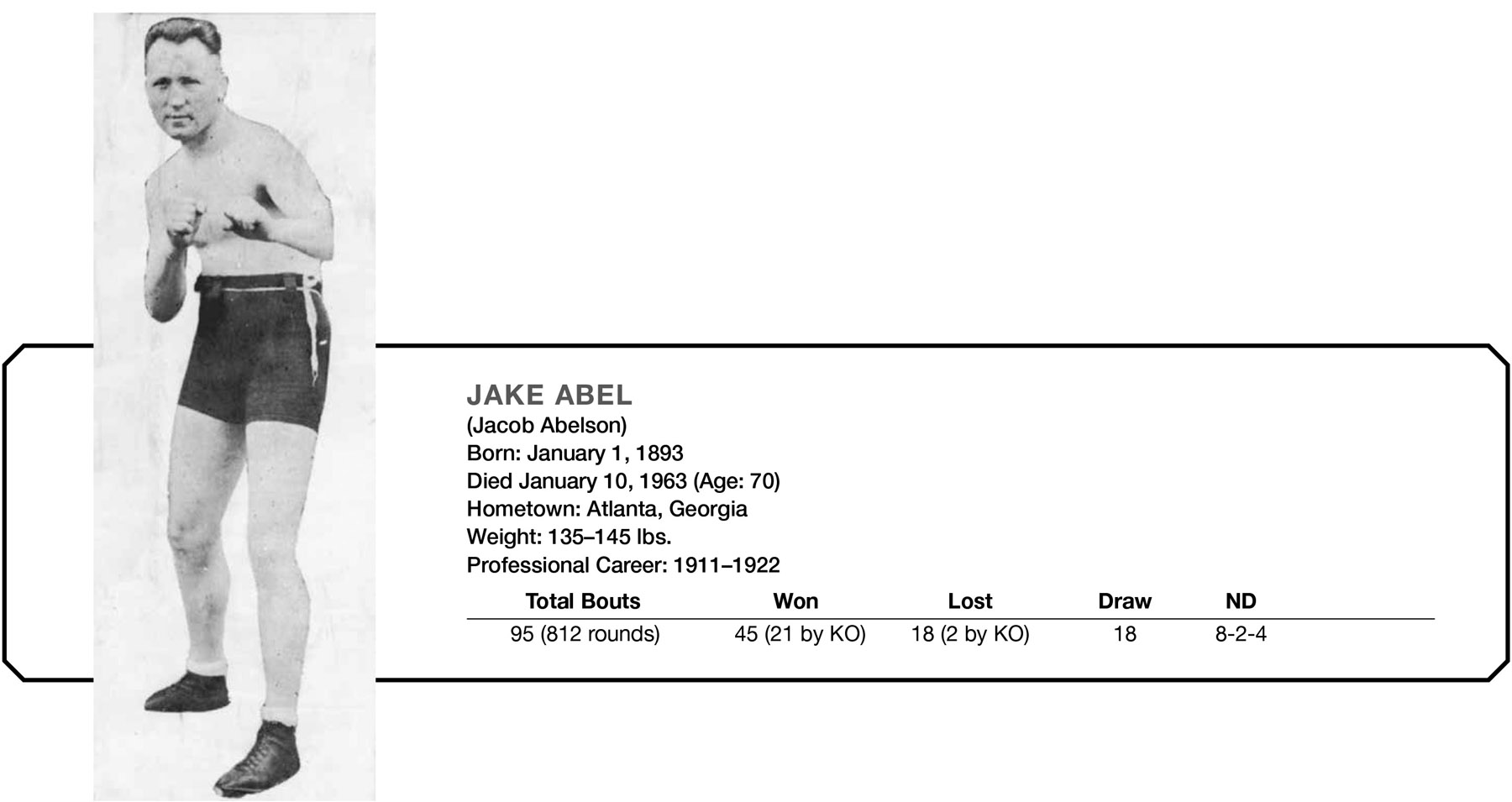
Russian-born Jake Abel lived most of his life in Atlanta, Georgia. He fought often in Georgia, Tennessee, and Florida, with an occasional foray into Cuba. Only three of his 95 documented bouts took place north of the Mason-Dixon Line.
During World War I Jake interrupted his career to enlist in the United States Army. Because of his boxing background the army assigned him to be a bayonet instructor. After the war Jake took part in the American Expeditionary Force boxing tournament (a precursor to the Inter-Allied Tournament) and won the lightweight championship. The finals were staged at the Cirque de Paris on April 26, 1919. General Pershing and other high-ranking officers were among a capacity crowd of 14,000. Abel was awarded a medal for sportsmanship by the Prince of Wales.
Jake was a highly skilled and durable ring technician who eagerly took on all comers, including such renowned fighters as Benny Leonard, Jack Britton, Ted “Kid” Lewis, Charley White, Knockout Brown, Eddie Hanlon, Joe Mandot, and Yankee Schwartz.
The $1,000 purse he received in 1919 for a 10-round no-decision bout (non-title) in Atlanta with the great lightweight champion Benny Leonard represented the largest purse of his career. The Associated Press reported that Leonard “gave an exhibition of speed and cleverness that outdid what Abel had to offer.”
Jake retired in 1922 at the age of 29. It was a smart move by a smart fighter. He was just past his prime, and continuing with his career would have made him a stepping-stone for younger fighters on the way up.
After hanging up his gloves Jake went into the hotel business, and for many years managed the Jefferson Hotel in downtown Atlanta. He was active in civic affairs throughout his life, and eventually became president of the Atlanta Hotel Association.
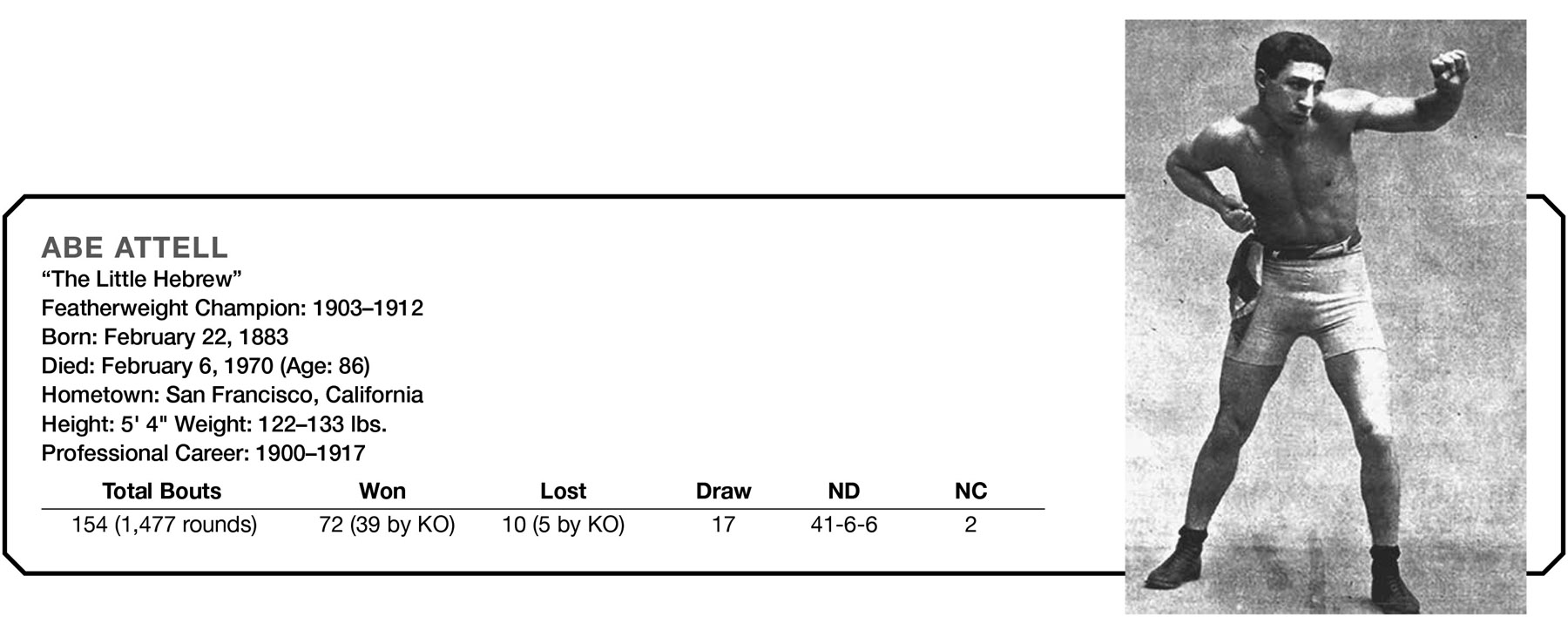
Abe Attell was the 13th of 16 children born to Russian immigrant parents. He grew up in an Irish neighborhood of San Francisco, so knowing how to fight became a matter of survival. Young Abe quickly established a reputation as a tough and tenacious street fighter. The young brawler turned pro at the age of 17, and within two years was competitive with the best featherweight boxers in the world.
In 1903 Abe won universal acclaim as featherweight champion, and over the next nine years successfully defended his title a record 23 times. While champion he also engaged in over 100 non-title bouts. Attell credited early ring scientists James J. Corbett and George Dixon for influencing his style of fighting. He rarely weighed more than 130 pounds, yet took on and defeated opponents outweighing him by 15 to 20 pounds.
Attell loved to gamble, and often bet on his own fights. In one famous incident he wagered his entire $5,000 purse that he would knock out challenger Harry Forbes inside five rounds. He won the bet. Another favorite gambit was to hold back his full arsenal against a hometown favorite to make it appear that he was having a rough time, but do just enough to win. The idea was to generate fan interest and anticipation for a return bout. The betting odds for the rematch would reflect the closeness of the first fight. After placing a hefty wager on himself, Attell would then proceed to take apart his surprised opponent. (He was not the only fighter to occasionally engage in this type of subterfuge.) Famous sports journalist Red Smith accurately described Attell as “a master boxer, dedicated gambler, and tireless schemer.”
Abe lost the featherweight title in 1912 when he was outpointed by Johnny Kilbane in a 20-round bout. His disappointment was somewhat assuaged by the $15,500 he received as his share of the gate—the largest purse of his career. Only two weeks after losing to Kilbane, Attell fought a bloody 20-round draw with lightweight contender “Harlem” Tommy Murphy.
Abe was 29 years old and a veteran of close to 200 fights. He fought for another year and then announced his retirement. Two years later there was the inevitable comeback, but after a few fights it was obvious to his fans that the old magic was gone.
After his ring career ended Abe dabbled in vaudeville and, in the time-honored tradition, opened a saloon. For the next few years not much was heard of Abe until his name suddenly appeared on the front page of every newspaper in America: Abe Attell had been linked to the infamous Black Sox baseball scandal of 1919.
The audacious plan to fix the 1919 World Series was rumored to have been hatched, or, at the very least, abetted by Attell’s close friend, the notorious gambler and racketeer Arnold Rothstein. Abe was alleged to have been the bagman for Rothstein, delivering the $10,000 payoffs to the eight Chicago White Sox players who agreed to throw the Series with Cincinnati. But before he could be subpoenaed, Attell fled to Canada. The self-imposed exile lasted a year. When he returned to face prosecution, a jury found him not guilty because of insufficient evidence.
In 1939 Abe married the former Mae O’Brien. (His first marriage had ended in divorce.) Together they managed a tavern on the East Side of Manhattan. He often attended the fights at Madison Square Garden. Even into his eighties he seemed not to suffer from the debilitating effects of his long career in the ring, unlike so many of his brothers-in-arms.
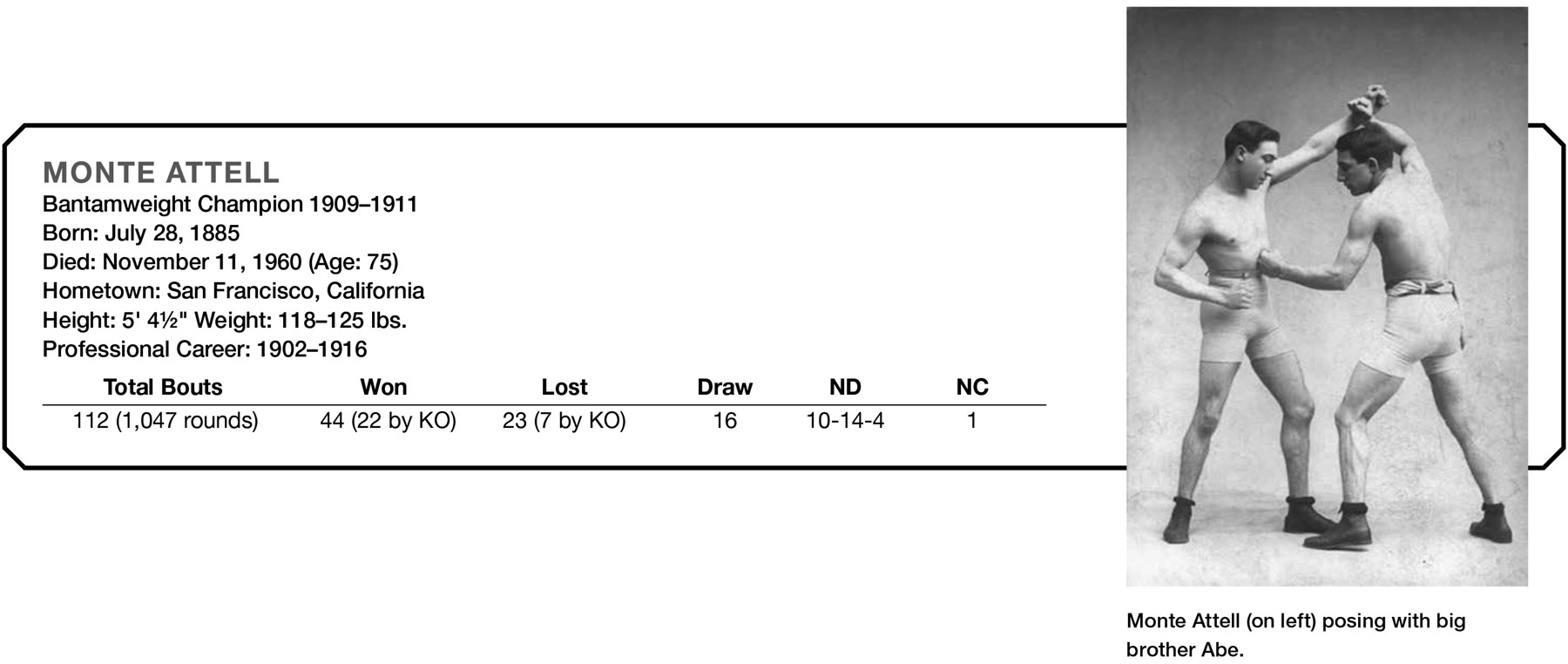
Monte Attell followed his older brothers Caesar and Abe into the prize ring. By the time Monte turned pro in 1902, big brother Abe had already claimed the world featherweight title. Monte’s rise was not nearly as meteoric as Abe’s. It took at least four years before he established his own credentials as a top bantamweight contender. During his prime (1906 to 1909), Monte lost only two of 34 documented fights.
On June 19, 1909, he knocked out Frankie Neil in the 18th round to win the world bantamweight title. It was a historic moment in that Monte and Abe became the first brothers to hold world titles.
After four successful defenses Monte lost the title to Frankie Conley (Francesco Conte) in the 42nd round of a 45-round marathon bout. Just 57 days later he was back in the ring for a 10-round no-decision with Joe Wagner.
In 1912 brother Abe lost his featherweight title to Johnny Kilbane. Ten months later Monte sought revenge and took on the new champion in a non-title bout. Monte was stopped in the eighth round.
Three years after his bout with Kilbane, Monte incurred an eye injury that became infected. The other eye had already been permanently damaged several years earlier in a 20-round bout with the great British boxer, Owen Moran. By 1920 Monte was legally blind.
The Great Depression and a failed business enterprise wiped out his savings. Blind and broke, the former champion took a job selling peanuts at the weekly fights in the Bay City. He was led around the arena by a little boy who would yell out, “World champion peanuts!” Thankfully, when former heavyweight champion Jack Dempsey heard about Monte’s plight, he came to the rescue and financed a cigar stand in San Francisco that provided the old champ with a decent living for many years.
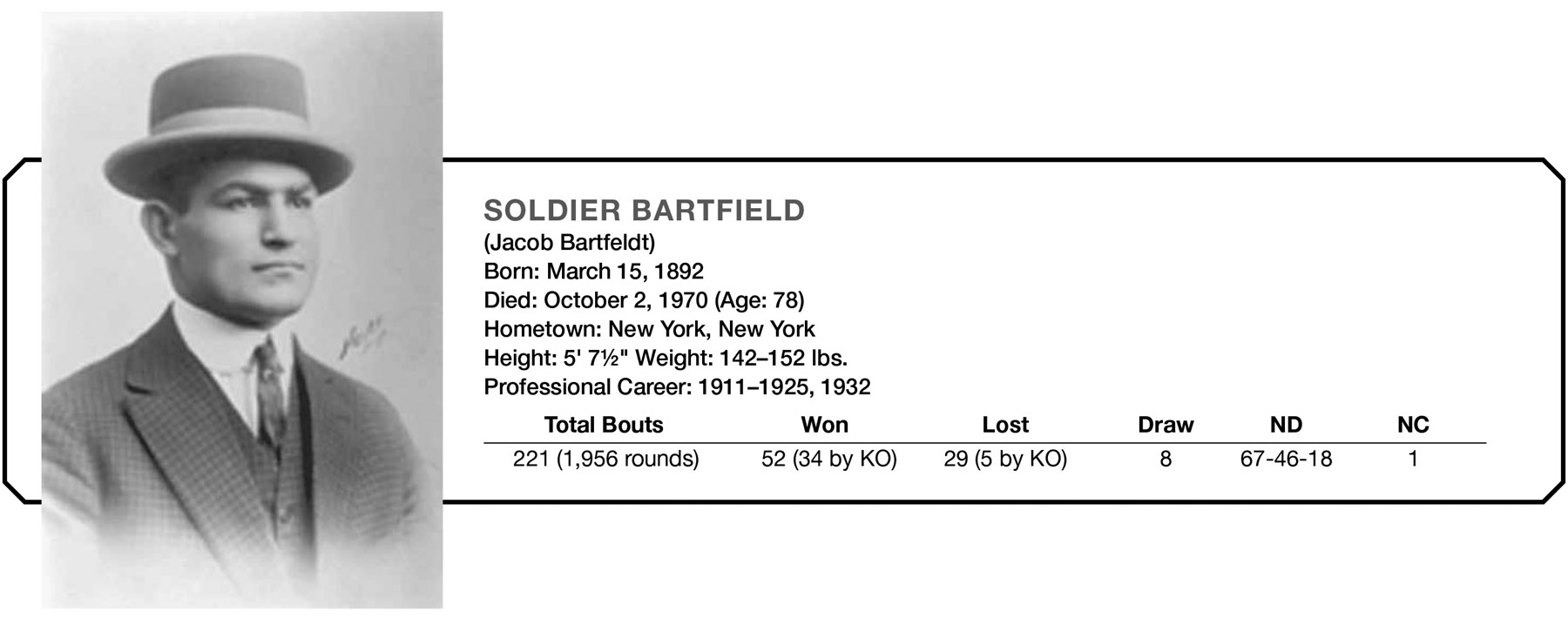
Austrian-born Jacob “Soldier” Bartfield came to America at the age of 16. Jake acquired his nickname after service with the US Army’s 11th Infantry. His division was assigned to the Mexican border in the days of the Pancho Villa raids. “We had a good outfit,” he told boxing journalist Lester Bromberg in 1967, “and those bandits knew it. Soon as we turned up, they ran like hell.”
The converted southpaw’s boxing record reads like a Hall of Fame roster. Opponents included world champions Benny Leonard, Jack Britton, Ted “Kid” Lewis, Harry Greb, Mickey Walker, Mike Gibbons, Billy Papke, Jock Malone, Mike O’Dowd, Jimmy Slattery, Johnny Wilson, and Bryan Downey.
Of all the great boxers that he fought, Soldier said that Harry Greb gave him the toughest fight of his career. He fought Greb six times, and is one of only a handful of boxers to win a newspaper decision over the great “Pittsburgh Windmill.” Two of the bouts (ten and 15 rounds) occurred just nine days apart.
In 14 years this iron man fought over 1,900 rounds, encompassing 221 recorded fights (although it is believed the actual number of fights is closer to 300). He faced scores of top-rated contenders, and traded punches with 13 world champions, 45 times. In 1918 he boxed the great Ted “Kid” Lewis six times, with three of the bouts occurring within 32 days of each other. Nearing the end of his career he took on future champion Mickey Walker three times in six weeks, the last one a 12-rounder.
THE EDUCATIONAL ALLIANCE
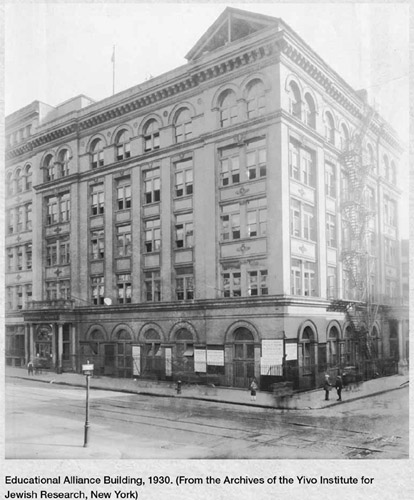
In 1889 several leading Jewish philanthropists raised funds for the construction of a neighborhood settlement house on New York’s Lower East Side. Most of the money was donated by educated Jews who came to America from Germany in the 1840s and ’50s in the first wave of Jewish immigration. Several had become wealthy in merchandising (mostly manufacturing and distribution of clothing) or in investment banking firms they founded. They took it upon themselves to establish social agencies for the large number of mostly uneducated and poverty-stricken East European Jews coming to America.
At the beginning this was not always a comfortable arrangement, as they regarded their East European “coreligionists” as socially and culturally inferior. As pointed out by Arthur Hertzberg, in their view these new arrivals “were underscoring the foreignness of Jews in America. Their very first concern was thus to try to limit immigration, but, if not, at least to ‘Americanize’ the new immigrants as quickly as possible. On the surface this meant to teach them English and Western manners, but much more than that was soon attempted.” Their concern was not entirely self-serving. Genuine compassion for their poor East European cousins (most of whom came from Russia and Poland) motivated their actions as well.10
The Educational Alliance Settlement House officially opened in 1891. Its purpose was to help growing numbers of poor East European Jewish immigrants, who were arriving in downtown New York by the thousands every month, to adapt to American society. The staff conducted English classes, gave lectures on how to be a good American citizen, provided free legal aid, and operated a summer camp for children, which was located in upstate New York. It also housed an art school and a theater. In 1895 banker and philanthropist Jacob Schiff purchased another building on the Lower East Side to house the Henry Street Settlement, a social and health service agency. Eight years later the Hebrew Institute of Chicago was established. Like the Educational Alliance, it played a key role in the Americanization of Chicago’s Eastern European immigrant population.
For Jewish boys the icing on the cake of these wonderful institutions was their first-class athletic facilities. Both had fully equipped gymnasiums that included basketball and handball courts, exercise apparatus, a regulation boxing ring, and punching bags. Danny Goodman, one of Chicago’s first Jewish boxing stars, was an instructor at the Hebrew Institute.
In New York City thousands of Jewish boys received their first exposure to boxing in the Educational Alliance’s gymnasium. Famous alumni include Leach Cross, Willie Jackson, Charley Beecher, Sid Terris, Ruby Goldstein, Sammy Dorfman, Lew Kirsch, and world champions Dave Rosenberg, Abe Goldstein, Ben Jeby, and Bob Olin.
By 1910 over 100 settlement houses and community centers, catering to a mostly Jewish clientele, had opened in virtually every major urban center of the United States.11 The boxing programs were not intended to prepare future professional boxers. Their goal was to promote fitness and self-confidence. Nevertheless, knowing how to box was a useful skill that could come in handy, especially for Jewish boys living in poor immigrant neighborhoods.
Today, the Educational Alliance is still housed in its seven-story flagship building at 197 East Broadway. In addition, there are several other sites affiliated with the Alliance that offer a variety of services, including residential and outpatient drug treatment centers, counseling, after-school programs in New York City Public Schools, senior citizen residential facilities, and other programs serving the community.
Bartfield was most proud of his 1915 no-decision bout against the famed “St. Paul Phantom,” Mike Gibbons, at Brooklyn’s Ebbets Field. He entered the ring a 10–1 underdog. But Gibbons, one of the finest scientific boxers of his era, could not cope with the Soldier’s special brand of pressure and incessant body punching. (Bartfield broke three of Gibbons’s ribs.) All four newspapers covering the bout scored it for Bartfield. He received $25,000 for the bout—the largest purse of his career.
Soldier retired in 1925 (although there was a brief two-bout comeback in 1932). He worked for 18 years in the Brooklyn Navy Yard as a ship fitter. In retirement he split his time between a 50-acre farm he owned near Hunter, New York, and a home in Canarsie, Brooklyn.
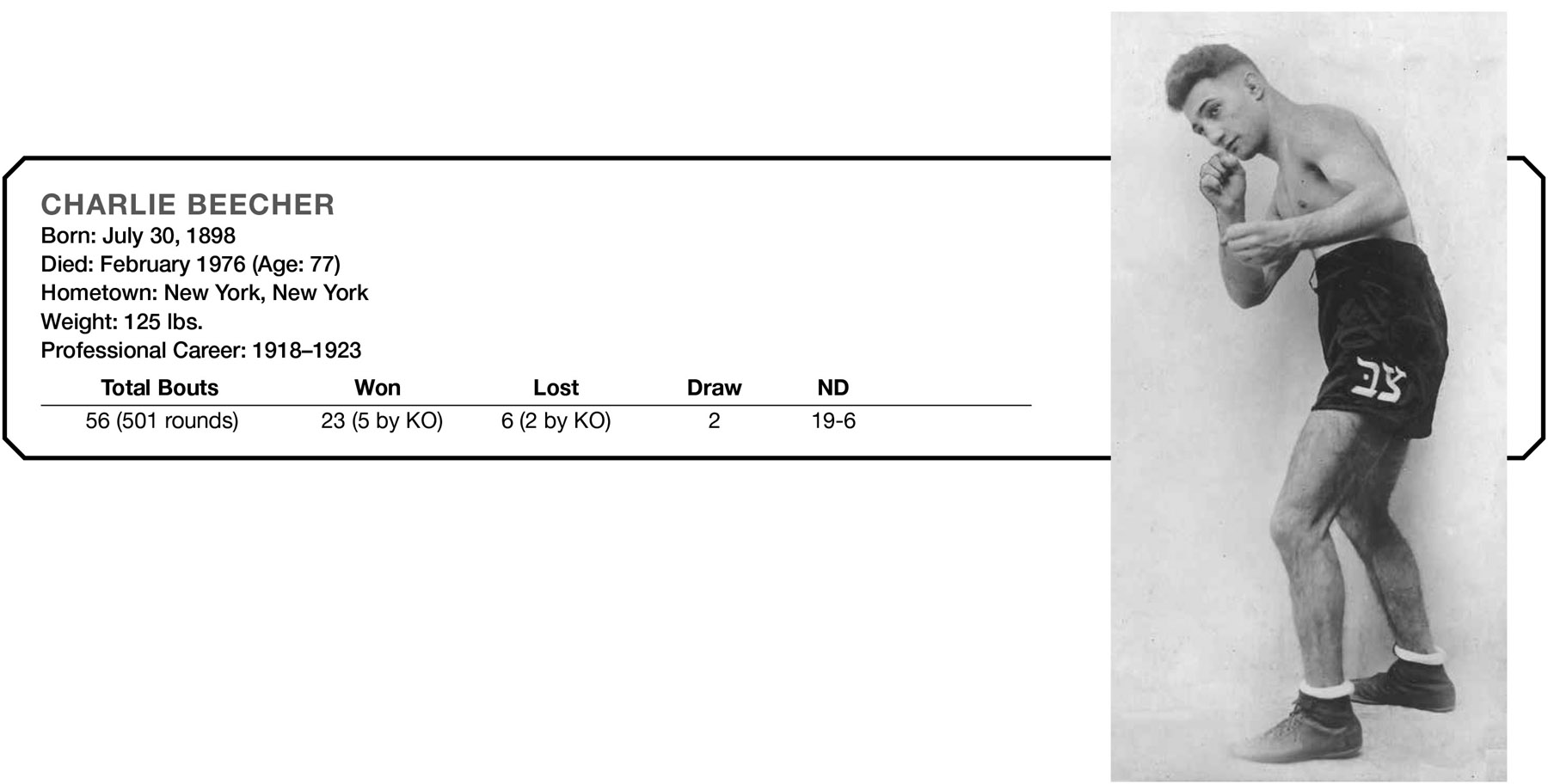
Charlie Beecher was 16 years old when he took his first boxing lesson at the famous Educational Alliance Settlement House in New York’s Lower East Side. Three years later he won the New York State amateur bantamweight championship. For most of his brief but successful professional career (1918–1923), Charlie was rated among the top featherweight contenders. He proved his mettle against the likes of Red Chapman, Jackie “Kid” Wolfe, Andy Chaney, Freddie Jacks, Benny Gould, Johnny Brown, Frankie Garcia, Dick Loadman, and Frankie Burns.
In the late 1920s Charlie opened “Beecher’s Gym” in the back of a pool hall he owned in Brownsville, Brooklyn. The gym became a popular training site and an active part of the New York boxing scene for the next quarter of a century.
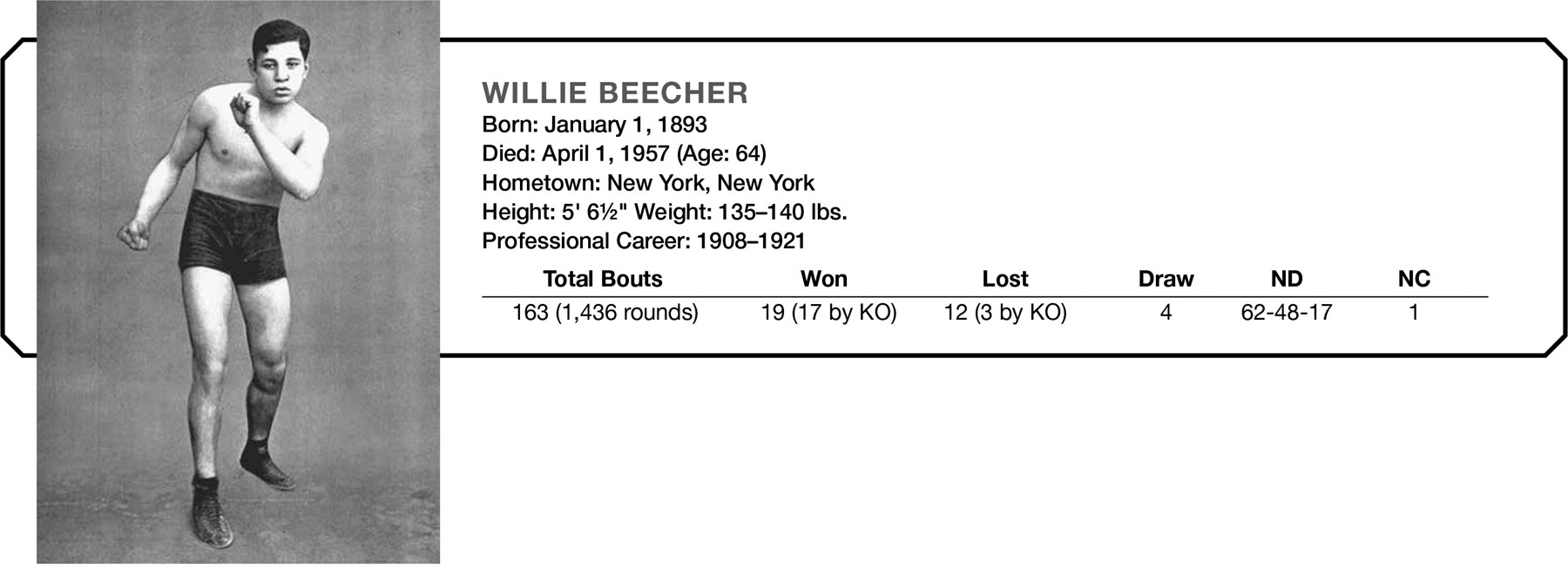
Willie Beecher is the older brother of featherweight contender Charlie Beecher. During his 13-year career Willie met virtually every outstanding lightweight contender and recorded memorable no-decision bouts against world champions Abe Attell, Ted “Kid” Lewis, and Jack Britton. The rugged 140-pounder was stopped only three times in 163 fights, with all three losses occurring either early or late in his career.
In 1914 Beecher lost a 20-round decision to lightweight contender Mexican Joe Rivers. Just three weeks later he fought a 20-round draw with future featherweight champion Johnny Dundee. His next bout was a non-title 10-rounder against lightweight champion Freddie Welsh at Madison Square Garden. According to newspaper accounts the brilliant Welshman easily outpointed Beecher.
From 1917 to 1919 Willie served in the United States Marine Corps. He launched a brief comeback in 1920, but retired the following year.
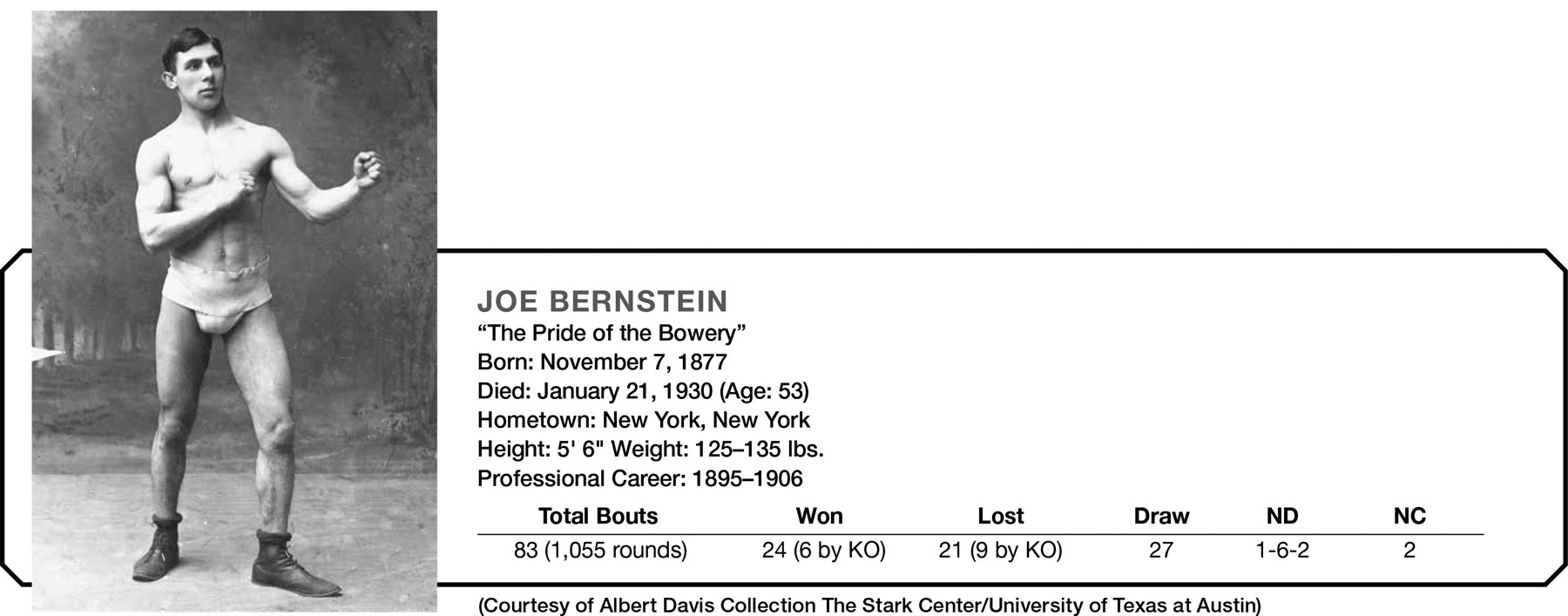
The first Jewish boxer from New York City to achieve a measure of notoriety at the turn of the last century was Dolly Lyons. Not much is known about Lyons. Only about a dozen contests have been documented, although it is assumed he fought many clandestine bouts at a time when the sport was illegal in New York. After losing a 20-round decision to Joe Bernstein in 1899, Lyons faded from the scene.
Within months of defeating Lyons, Joe Bernstein’s name was known to every boxing fan in America when he lost a close 25-round decision to the top-ranked bantamweight contender, Terry McGovern. Just one month later, in another 25-round bout, he challenged the great featherweight champion, George Dixon. Dixon, a Canadian, was the first black world champion in any weight class. Joe put up stubborn resistance but lost the decision. Ten weeks after his defeat by Dixon, Bernstein knocked out former champion Solly Smith in the 13th round.
“The Pride of the Bowery” failed in two subsequent attempts to capture the featherweight title, losing to both McGovern and Young Corbett II. On the plus side he scored important victories over Tommy White, Eddie Santry, and Young Griffo. Three 25-round draws with the formidable Dave Sullivan solidified Bernstein’s status as one of the world’s top featherweight contenders.
Joe’s pro career lasted 12 fruitful years. He retired in 1908 after a fourth round TKO loss to Leach Cross.
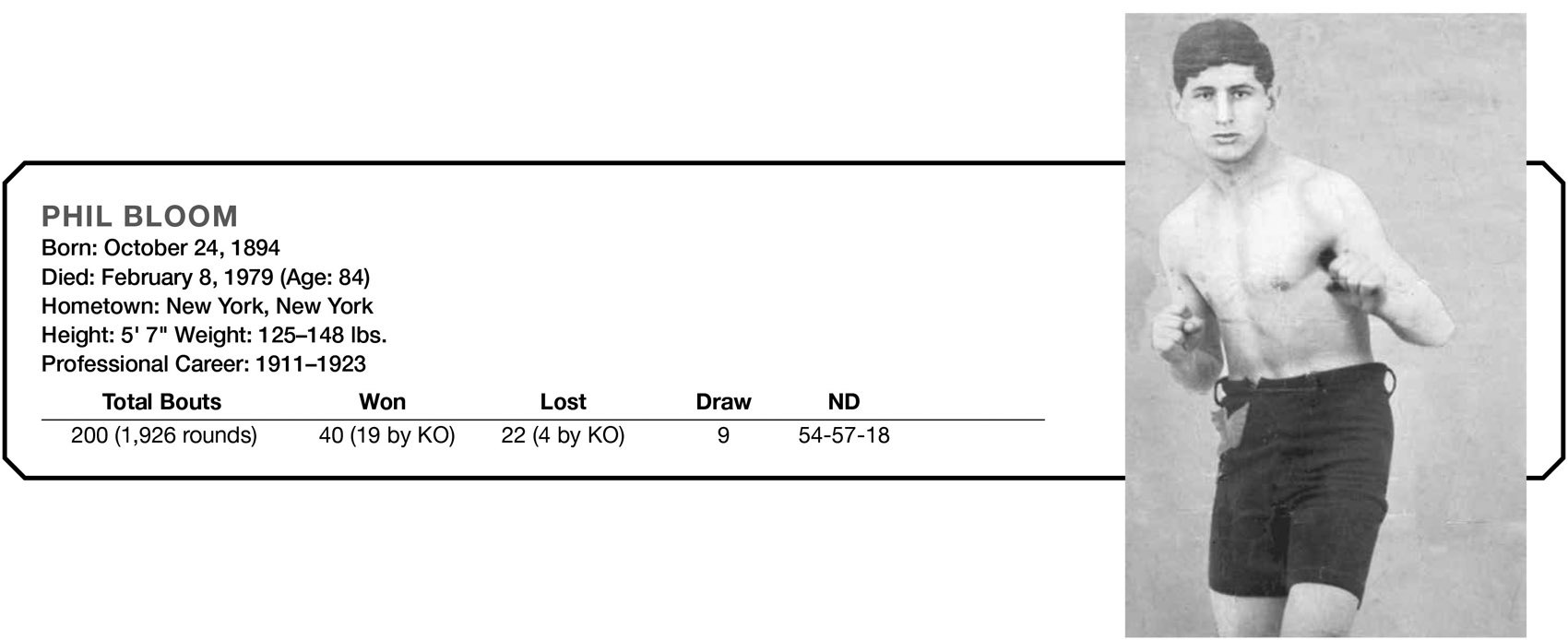
Phil Bloom was born in the Whitechapel district of London’s East End, home to most of England’s great Jewish boxers. In 1911 Bloom’s father, a tailor, took his wife and eight children to America. The family settled in Williamsburg, Brooklyn. Phil had boxed as an amateur in England and decided to turn pro that same year. The high points of his 201-bout career were eight encounters with the great lightweight champion, Benny Leonard. Bloom was KO’d twice by Leonard but finished on his feet the other times.
In addition to Leonard, Bloom fought five other world champions—Jack Britton, Ted “Kid” Lewis, Johnny Dundee, Rocky Kansas, and Dave Rosenberg.
Even in an era of iron men, Bloom stood out as a remarkably durable fighter. On December 2, 1916, he boxed 20 rounds with perennial contender Irish Patsy Cline in Brooklyn. Four days later he was in Detroit where he went 10 rounds with tough veteran Stanley Yoakum. After one day’s rest Bloom hustled back to New Haven, Connecticut, where he dropped a 15-round decision to top lightweight contender Joe Welling. Seventeen days after losing to Welling he was back in Brooklyn for a 10-rounder against Chuck Simler.
In 1920 Bloom returned to London and won a 20-round decision over former welterweight champion Matt Wells. Eight days later he fought another 20-rounder, outpointing Danny Arthurs. Bloom finally hung up his well-worn boxing gloves in 1923. He moved to Los Angeles in the late 1920s, where he became an extra and bit player in many Hollywood movies.
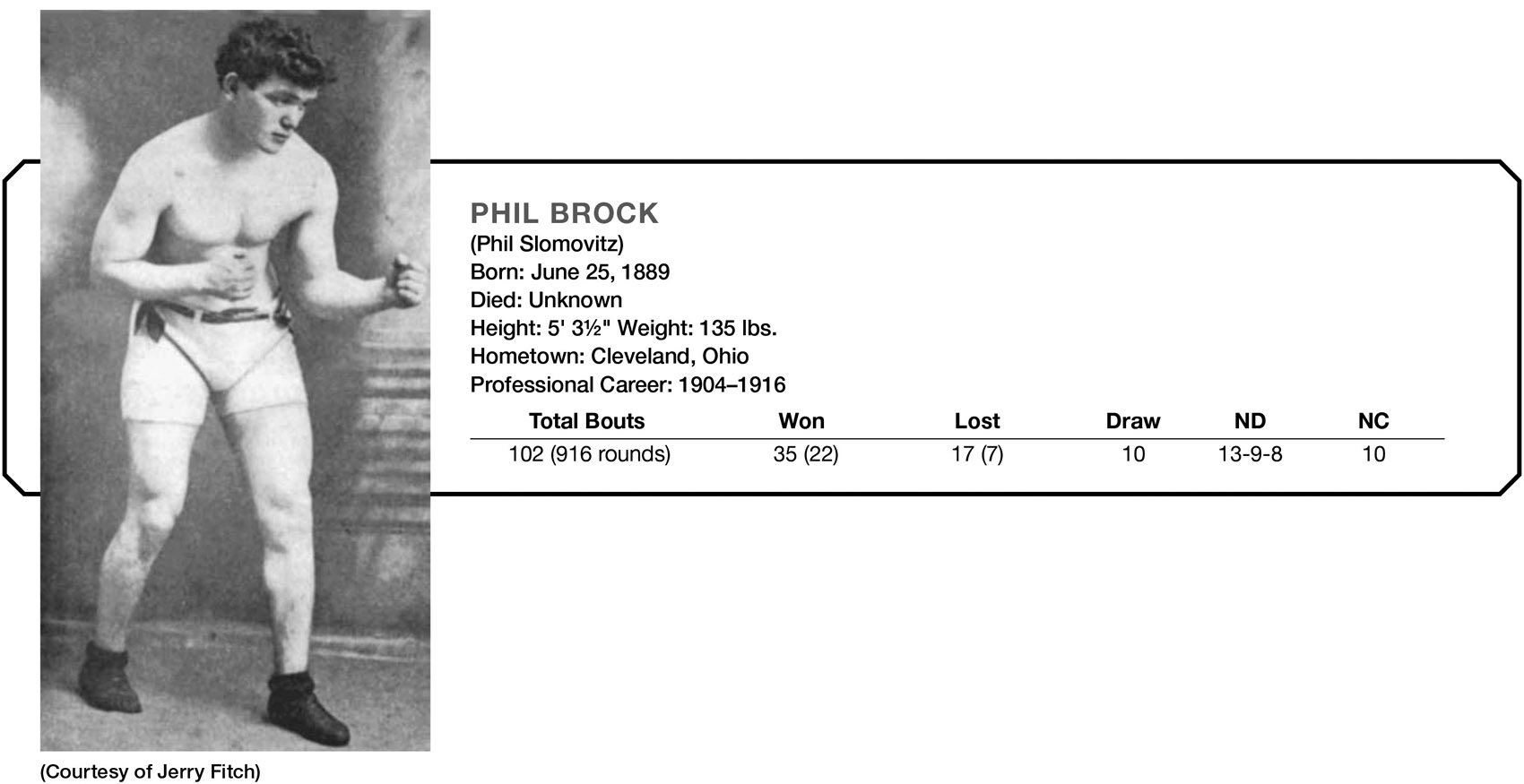
Phil Brock and his younger brother Matt were Cleveland, Ohio’s, first Jewish boxing stars. Both were lightweights. Matt was the harder puncher, but Phil was considered the better boxer.
Phil turned pro in 1904, and within six years was competitive with the world’s finest lightweight boxers. Among his victims were Philadelphia Pal Moore, Fighting Dick Hyland, Jack Redmond, and Matty Baldwin. He also had draw decisions with Harlem Tommy Murphy, former featherweight champion Young Corbett II, and future lightweight champion Willie Ritchie. Losses to Owen Moran, Packey McFarland, and Freddie Welsh did not tarnish Phil’s reputation, as they were rated among the greatest fighters of their era.
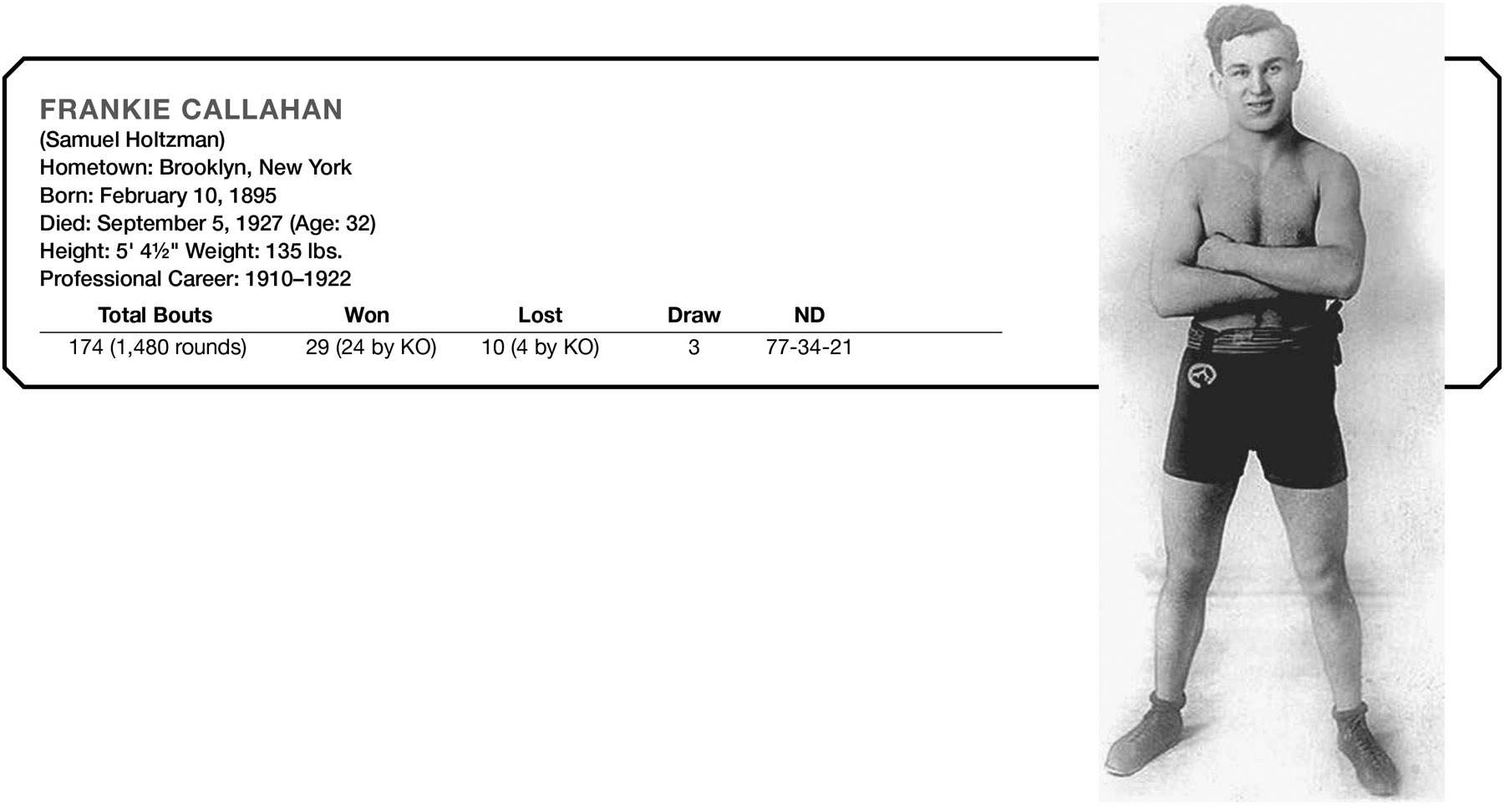
Brooklyn’s Sam Holtzman adopted the very Irish name “Frankie Callahan” to keep his parents from finding out he was a boxer.* Before hanging up his gloves in 1922, he fought 175 documented professional bouts. His opponents included five world champions and most of the top lightweights of his era, including Pete Hartley, Charley White, George KO Chaney, Willie Jackson, Phil Bloom, Pal Moore, and future champion Rocky Kansas.
The highlight of his career occurred in 1917 when two of three newspapers awarded Callahan the unofficial victory in a 10-round no-decision bout with a near-prime Benny Leonard. Three months later Leonard won the lightweight title. Previous to his bout with Leonard, Callahan had won a newspaper verdict over future featherweight champion Johnny Dundee.
Nineteen days after his bout with Leonard, Callahan fought another no-decision bout against Dundee. Two newspapers favored Callahan and two others called it a draw. Five weeks later the 22-year-old faux Irishman knocked out lightweight contender Jimmy Hanlon in the 19th round.
The one fighter that Callahan could not solve was Lew Tendler. He lost three newspaper decisions to Tendler and, nearing the end of his career, was stopped twice by the great Philadelphia southpaw.
An obituary in the New York Times reported that Callahan passed away after contracting pneumonia. He was 32 years old.

San Francisco’s Joe Choynski (pronounced Co-IN-sky) was the first Jewish athlete to achieve international prominence. Joe had an interesting pedigree. He was one of the few professional boxers not born into poverty. His father, Isadore, the son of a rabbi, had attended Yale College, where he earned a teaching degree. After moving to San Francisco Isadore became a dealer in rare books, and was the West Coast correspondent for The American Israelite newspaper for 20 years. The elder Choynski also published his own periodical called Public Opinion, which he used as a vehicle for exposing municipal corruption and anti-Semitism.12
While his father traveled in intellectual circles (he counted Mark Twain among his friends), Joe danced to a different drummer. Although he was highly intelligent and articulate, formal education did not interest him. After dropping out of high school he found work as a blacksmith and then as a candy puller in San Francisco’s notorious Barbary Coast. Both of these physically rigorous jobs proved to be excellent preparation for boxing.
Choynski was five-foot-11 and weighed around 170 pounds. Before 1903 there was no light-heavyweight division for fighters who weighed between 160 and 175 pounds. As a result, over the course of his 83-bout career, Joe often took on opponents who outweighed him by 20 to 60 pounds. Fortunately for Joe, he was not only a superb boxer, but also one of the sport’s deadliest punchers.
On May 30, 1889, 19 months after his pro debut, Choynski was matched with San Francisco rival and future heavyweight champion James J. Corbett. Their fight was halted by the police after the fourth round (professional boxing was outlawed in San Francisco), and a rematch was scheduled one week later. In order to avoid police interference, the fight took place on a barge anchored in San Francisco Bay, near the town of Benicia.
Several hundred people crowded onto the barge to witness one of boxing’s legendary fights. In a brutal seesaw battle that saw both men come back from the brink of defeat, Corbett knocked out Choynski in the 27th round. The bout, fought under Queensberry rules (three-minute rounds separated by one minute of rest), had lasted just under two hours.
During his illustrious 16-year career Joe Choynski took on three past or future heavyweight champions. Outweighed by 40 pounds, he fought a 20-round draw with James J. Jeffries, was stopped in five by Bob Fitzsimmons, and knocked out Jack Johnson in three rounds. Other legendary opponents included Tom Sharkey, Philadelphia Jack O’Brien, Kid McCoy, and Barbados Joe Walcott.
Choynski always considered his 1901 knockout of future heavyweight champion Jack Johnson the most significant victory of his career. (Seven years after their fight, Johnson would become the first black heavyweight champion.) At 32 years of age Joe was 10 years older and 25 pounds lighter than Johnson. Most people expected the veteran to lose. The fight took place in Johnson’s hometown of Galveston, Texas.
In the third round Choynski landed a tremendous left hook that knocked Johnson cold. As soon as the referee completed the 10-count, five Texas Rangers stormed into the ring and arrested both fighters for violating a local ordinance against professional boxing contests.
Johnson and Choynski shared the same prison cell for two weeks but were treated more like celebrities than outlaws. They were even allowed to leave the prison in the evenings— Choynski to his hotel, and Johnson to his home—but had to return the following morning. Both fighters staged sparring exhibitions for the warden and his staff while state politicians used the jail sentence to score points as protectors of public decency.
During their confinement Johnson asked his cellmate to teach him the tricks of an old pro. In his autobiography Johnson credited Choynski with helping to refine his boxing style. “Every day we would box in the jail yard, surrounded by police officers and guests,” wrote Johnson. “Joe had great affection for me, and to prove it, he gave me lessons, showing me the best punches anyone has ever seen in a jail yard. I learned more in those two weeks than I had learned in my entire existence up to that point.”13 Jack Johnson is still rated by many experts to be among the top five heavyweights of all time.
Choynski continued to box for three more years, finally retiring in 1904, at the age of 36, after having fought 83 professional fights. He had a brief fling as an actor, costarring in a touring stage production of Uncle Tom’s Cabin with the great Australian heavyweight, Peter Jackson (the first prominent black fighter of the gloved era). The show’s climax was a sparring session between the stars. After the sparring session an announcement was made offering $500 to anyone in the audience who could last three minutes with either fighter. It is not known if anyone took up the challenge.
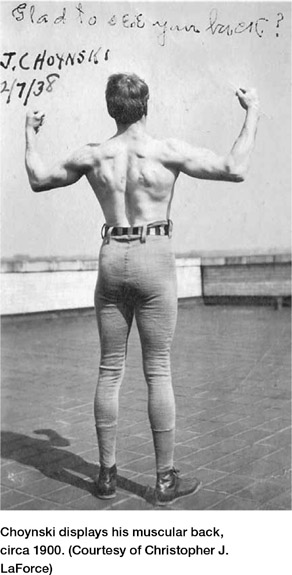
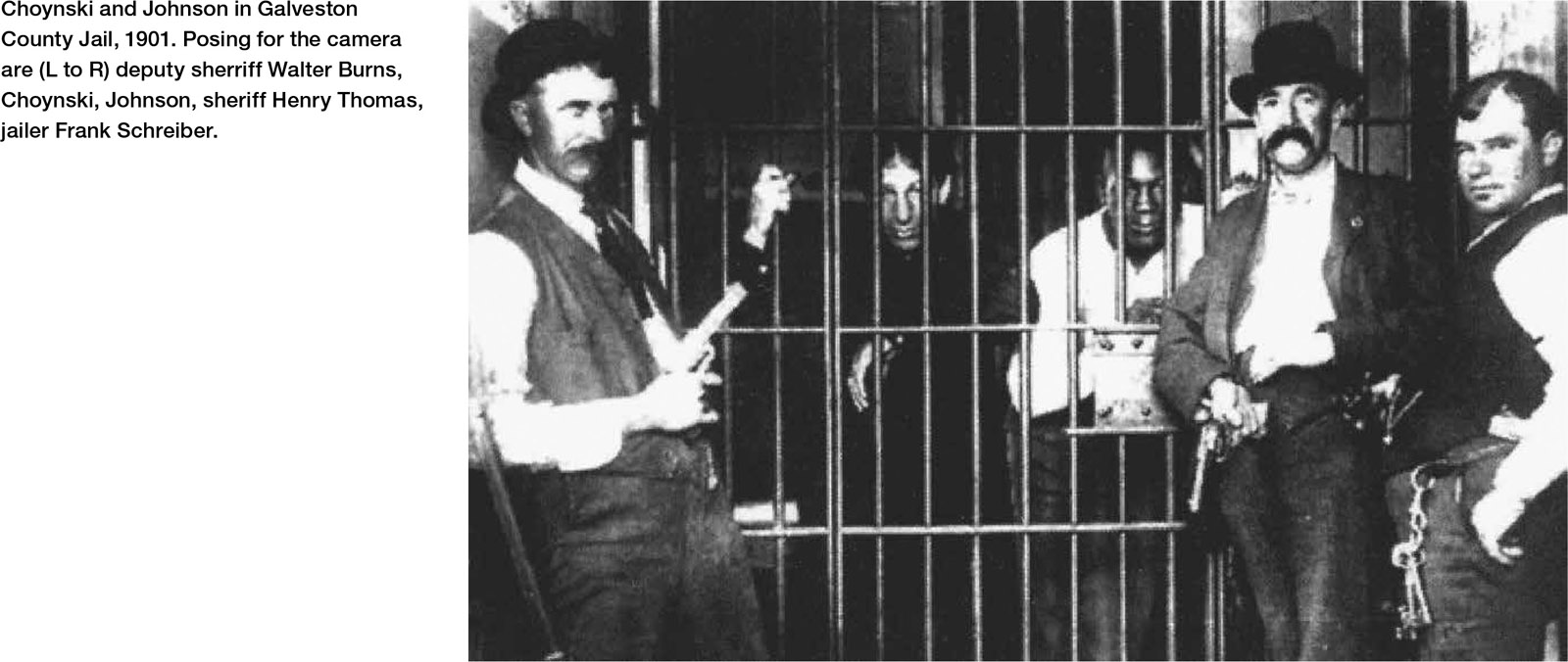
Joe eventually moved to Chicago and entered the insurance business. In 1942, shortly before he passed away at the age of 74, he was hired as technical consultant for the movie Gentleman Jim, starring Errol Flynn as Corbett. The legendary 1889 barge fight was re-created for the film. A bit of poetic license was taken, as the Hollywood version shows Corbett getting knocked off the barge and splashing into San Francisco Bay and then climbing back to resume the battle. (The Raoul Walsh–directed film is a classic, and the author’s personal favorite.)
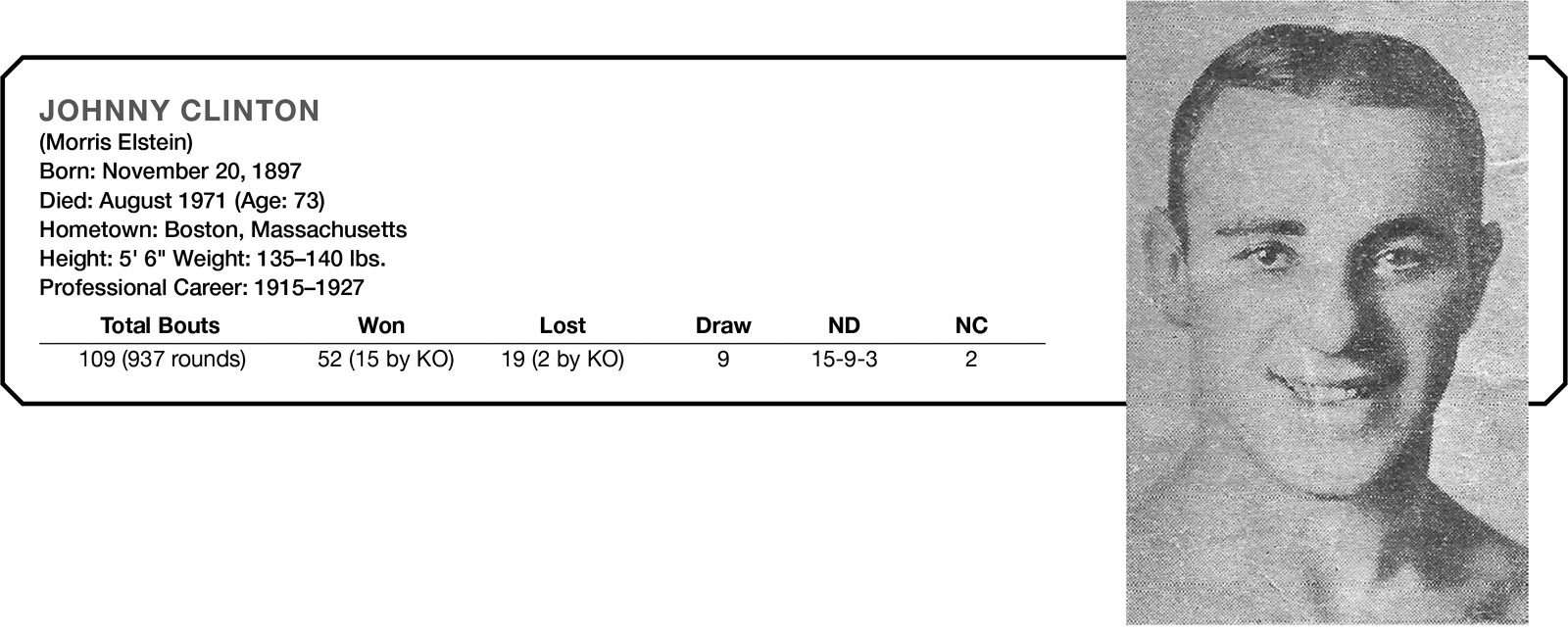
The Boston Irish would have been proud to call Johnny Clinton one of their own. He always put forth a 100 percent effort, gave no quarter, and asked for none in return. But he was Irish in name only. Johnny Clinton was a Jew from Boston’s West End whose real name was Morris Elstein.
This faux Irishman had already fought some of the best lightweight boxers in the world before his 21st birthday, including multiple bouts with Mel Coogan, Frankie Conifrey, Joe Welling, Lou Bogash, Frankie Schoell, and Johnny Shugrue. But his proudest moments in the ring were his two no-decision bouts with the incomparable lightweight champion Benny Leonard. They met twice—the first time in 1919, and in a rematch two and a half years later. Both fights went the full 10 rounds. There was no doubt about Leonard’s superiority, but Clinton was no pushover, and the champion had to perform at his best each time.
Even at the tail end of his busy career, Clinton was still meeting top contenders. In 1923 he lost a 10-rounder to Sailor Friedman, but rebounded less than three months later with a 12-round nod over England’s Harry Mason. As his career wound down Clinton lost decisions to Pete August, Young Harry Wills, and future middleweight champion Joe Dundee. Shortly after his thirtieth birthday Clinton announced his retirement. Potential opponents, both Irish and Jewish, breathed a sigh of relief.
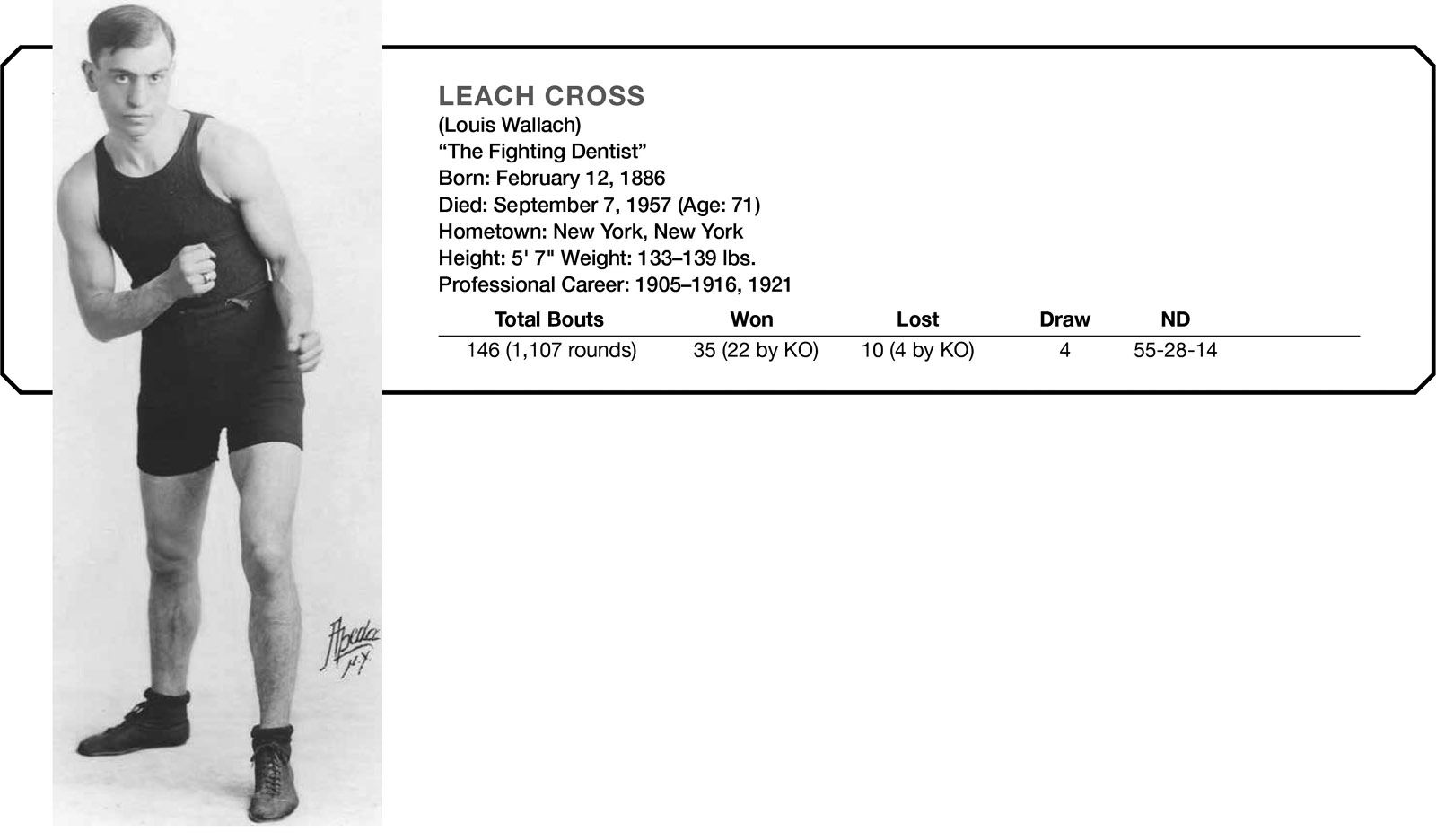
Until the rise of Benny Leonard a decade later, Leach Cross was the most popular fighter to ever come out of New York’s Lower East Side neighborhood. The son of Austrian immigrants, Leach’s actual birth name was Louis Charles Wallach. The name change was an attempt to hide his fistic activities from his father. “Leach” was a derivation of his childhood nickname, “Lachey.” Three of his younger brothers, Phil, Dave, and Marty, also became pro boxers, with varying degrees of success.
Before he embarked on his busy pro career, Leach Cross began studying dentistry at New York University. He graduated in 1907 and went to work at the office of a dentist friend. Leach practiced dentistry by day while boxing at night— hence, his nickname, “The Fighting Dentist.”
By 1908 Leach was earning $15 a week as a dentist. That same year his first main event paid him $35. Leach temporarily suspended his dental practice to devote full-time to his more lucrative pugilistic endeavors.
Two years into his pro career, the dentist/fighter became a ghetto sensation when he stopped the much-admired Joe Bernstein in four rounds. By then he had earned enough money to open his own dental practice on the East Side. The establishment soon had enough patients to keep two assistants busy, but Leach’s main source of income still came from boxing. His earnings in the ring were estimated at from $1,500 to $3,000 a month.14
From 1909 to 1916, “Leachie,” as he was called by friends, had 89 bouts. Among his opponents were boxing legends Freddie Welsh, Jack Britton, Johnny Dundee, Jem Driscoll, Packey McFarland, Charley White, Matt Wells, and Ad Wolgast.
“The Fighting Dentist” knew all the tricks of the trade. He fought out of a low crouch, which made him difficult to hit. His right uppercut and right cross were his most effective weapons. One of his favorite maneuvers was to feign grogginess in order to draw an opponent into making a careless mistake. When his opponent lunged forward, Leach timed the punch, slipped it, and countered. Opponents eventually caught on to the trick, but they never knew for sure if Leach was really hurt or just faking. Neither did the fans, who came out in droves to watch the colorful and exciting fighter in action.
The most memorable fight of his career was a 1909 encounter with Fighting Dick Hyland in Colma, California. The bout was a marathon contest scheduled for 45 rounds. After more than two hours of fighting Leach was knocked out in the 41st round. Bad weather had kept attendance down. He was paid only $350 for the toughest and most punishing fight of his career.
During the day Leach attended to his dental practice, while at night he could often be found topping a card at one of New York City’s many fight clubs. In his last bout of 1911, Leach was matched against the dangerous lightweight contender Knockout Brown. The bout took place in Manhattan’s Empire Athletic Club. Both fighters were seasoned campaigners with more than 80 bouts apiece. Knockout Brown, whose real first name was Valentine, packed the heavier wallop. Over a dozen of his opponents had not made it past the first round.
On the day of the fight a standing-room-only crowd was on hand to see the highly anticipated match. The 10-round bout was a closely contested, action-packed battle. Brown kept boring into Leach, pressuring him throughout the fight, but it was Leach who was more accurate with his punches and who did most of the scoring.
During the fight Brown had a couple of his teeth loosened. The following day his manager took him to a dentist’s office to have them checked. Brown was dumbfounded when he saw who the dentist was. Standing in front of him, dressed in a white medical smock, was none other than Dr. Louis C. Wallach, alias Leach Cross.15
Leach finally hung up his gloves in 1916. His good friend, the singer Al Jolson, suggested he move to California. With his nest egg of $46,000 Leach built a house in Hollywood, and later opened up a gymnasium that became very popular with movie stars and businessmen. He counted Rudolph Valentino, Douglas Fairbanks, Mary Pickford, and Charlie Chaplin among his close friends.
Eventually bad investments and a costly divorce wiped out his savings, driving him into bankruptcy. Leach decided to leave California and return to New York City, where he reopened his dental practice in Union Square.
In his early sixties, Leach began to suffer the effects of his lengthy boxing career. Failing eyesight and increasing dementia forced him to close his office. He passed away in 1957 at the age of 71.
BOXING TRADING CARDS
The popularity of the charismatic heavyweight champion John L. Sullivan led to an active market for boxing collectibles, most notably trading cards. In the 1880s American tobacco companies began to insert pictures of Sullivan and other famous boxers into cigarette packs as a way to promote their products. (A pack of 10 cigarettes usually sold for five cents.) Other inserts might include pictures of baseball players, actresses, Indian chiefs, frontier heroes, kings, police chiefs, billiard players, birds, and ships.

In 1910 the American cigarette industry introduced several Turkish brands named Hasson, Mecca, Fatima, and Turkish Whiffs. Each included a series of colorful boxing inserts. A full set (usually numbering around 50) is considered a valuable collector’s item today.
England, with its rich boxing history, was also a major producer of boxing trading cards. The two most popular sets of cards were those produced in the 1930s and ’40s by the W. A. & A. C. Churchman Cigarette Company of London and Knock-Out Razor Blades of Sheffield.

Beginning in 1921 the Exhibit Supply Company of Chicago began selling postcard-size photos of contemporary boxing stars from vending machines for a penny each. The boxer’s record appeared on the opposite side of the card. A new series of cards was printed in 1928, but did not include the fighter’s record. The Exhibit Supply cards featured champions and contenders from the past and present.
The first post–World War II set of boxing cards was issued by two major chewing gum companies, Topps and Leaf, although their brilliantly colored cards did not meet the standards of workmanship displayed in the cigarette-pack inserts of a generation earlier.
A final set of Exhibit Supply cards was issued in the early 1960s. They were sold in amusement parks and penny arcades for five cents each. Today, depending on the fighter pictured, collectors pay between $20 and $150 per card
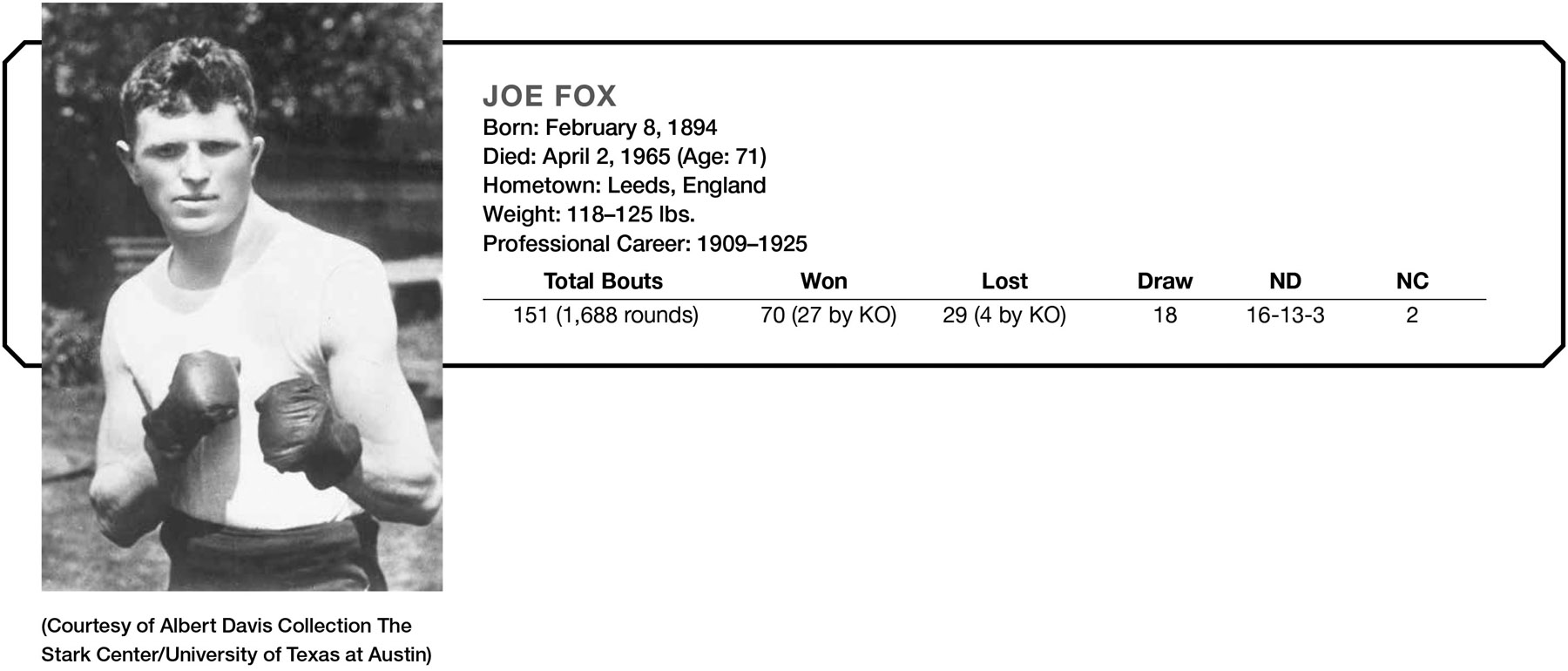
Joe Fox fought in the classic stand-up style popular with British boxers. For most of his 16-year professional career, he ranked among the world’s best bantamweights and featherweights. Fox was awarded the prestigious Lonsdale Belt after winning British titles in both divisions. (The Lonsdale Belt, named after the first president of London’s National Sporting Club, is awarded to all British champions). He made two trips to America, in 1913 and 1919, where he crossed gloves with such outstanding ring men as Joe Tiplitz, Babe Herman, Al Shubert, Benny Valgar, and future champions Joe Lynch, Sammy Mandell, and Eugène Criqui. In 1919 he lost a six-round newspaper decision (non-title) to world featherweight champion Johnny Kilbane.
One year after he retired, Fox married and settled down. He opened a candy shop where he proudly displayed his Lonsdale Belt in a framed cabinet above the counter.

Abe Friedman was never knocked out in 122 professional fights, despite facing virtually every top bantamweight and featherweight in the 1910s and early 1920s. That was no small accomplishment considering the extraordinary depth of talent in those divisions. His opponents included the likes of Pete Herman, Kid Williams, Pancho Villa, Joe Lynch, Young Montreal, Danny Kramer, Joe Burman, Johnny Ertle, and Roy Moore. He also fought two no-decision bouts with Charley Goldman, who later gained fame as the trainer of heavyweight champion Rocky Marciano.
Friedman served in the US Army during World War I. He resumed his career in 1919, fighting mostly in the Boston area. In the last few years of his career he was plagued by failing vision. On May 4, 1925, Friedman lost an eight-round decision to Rosey Stoy and announced his retirement. Tragically, three months later, while crossing a street near his home, Friedman was hit by a truck and killed.
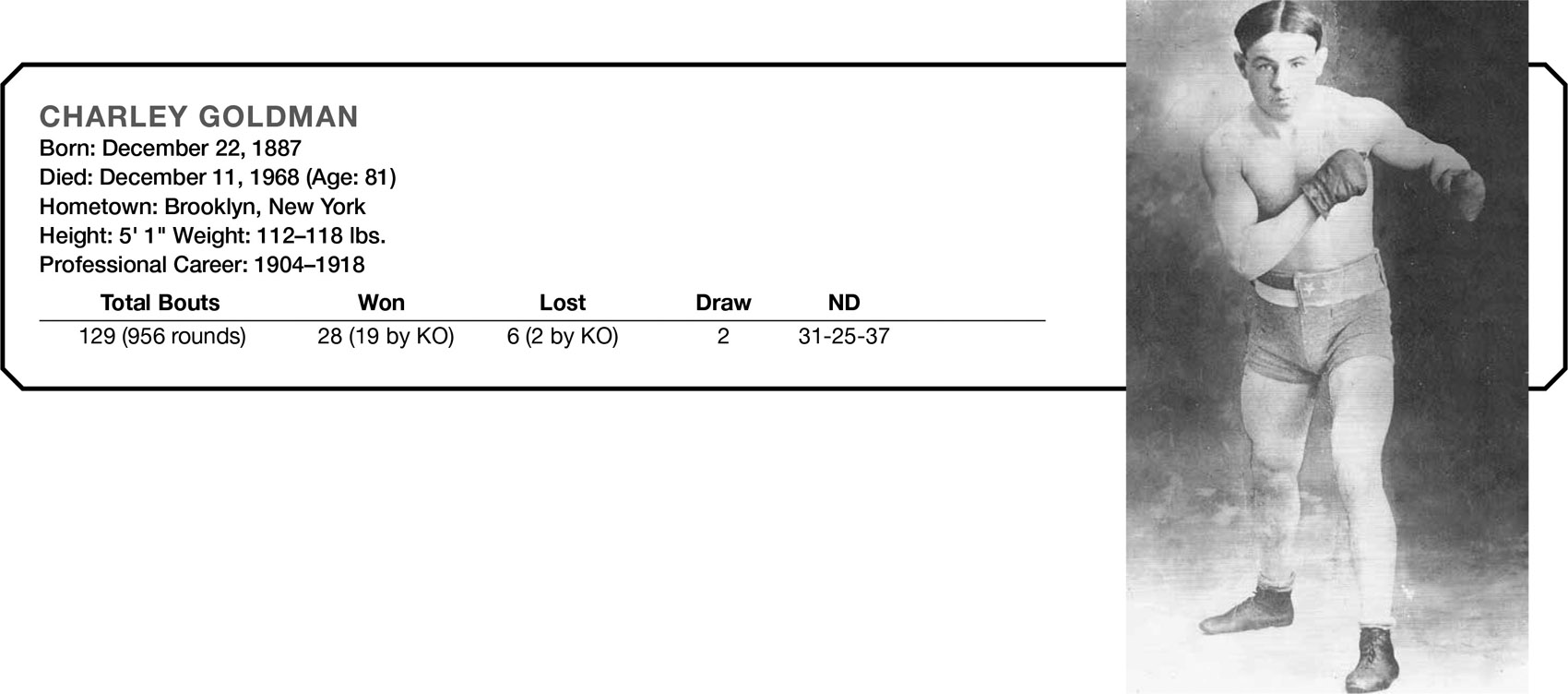
Before Charley Goldman gained recognition as one of boxing’s all-time great trainers, he was a serious contender for the bantamweight championship of the world.
Growing up in Brooklyn’s tough Red Hook section at the turn of the last century, young Charley idolized his neighbor, the great featherweight champion “Terrible” Terry McGovern. He was thrilled when the champ gave him the honor of carrying his gym bag to workouts. In imitation of his hero Goldman began parting his hair in the middle, and for his entire life always wore a derby, just like McGovern.
Charley claimed to have had over 400 bouts, but only 129 have been documented. His earliest recorded pro fight was a 42-round draw with Young Gardner in 1904. Since boxing was illegal in New York, the bout took place in the back of a saloon in Manhattan’s Bowery neighborhood.
The highlight of Charley’s career was a 1912 non-title fight against the great bantamweight champion Johnny Coulon. Two newspapers scored the 10-round no-decision bout for Coulon, while two others scored it a draw.
In 1913 Charley began training middleweight contender Al McCoy (Albert Rudolph). After McCoy won the title Goldman decided to devote himself full-time to training fighters. In 1924 he formed a partnership with manager Al Weill that continued for the next 32 years. Goldman trained scores of boxers for Weill and was also outsourced to train fighters for other managers. Charley trained four world champions for Weill: Lou Ambers (lightweight), Joey Archibald (featherweight), Marty Servo (welterweight), and his most famous pupil, Rocky Marciano, the only heavyweight champion to retire undefeated.

Abe “Kid” Goodman was the first Jewish boxing star from Boston. He turned pro in 1899, and over the next four years lost only seven of 95 fights. Highlights of Goodman’s career include decisions over top lightweight contender Aurelio Herrera, future welterweight champion Harry Lewis, and draw decisions with featherweight champion Abe Attell (nontitle) and former champion Young Corbett II. Other notable opponents were Benny Yanger, Matty Baldwin, Harlem Tommy Murphy, Packey McFarland, Dick Hyland, and Cyclone Johnny Thompson.
By 1910 it was obvious Goodman had passed his peak, but he continued to fight for another six years, losing to fighters he could have easily beaten in his prime. After he retired Goodman became a deputy sheriff in Boston.
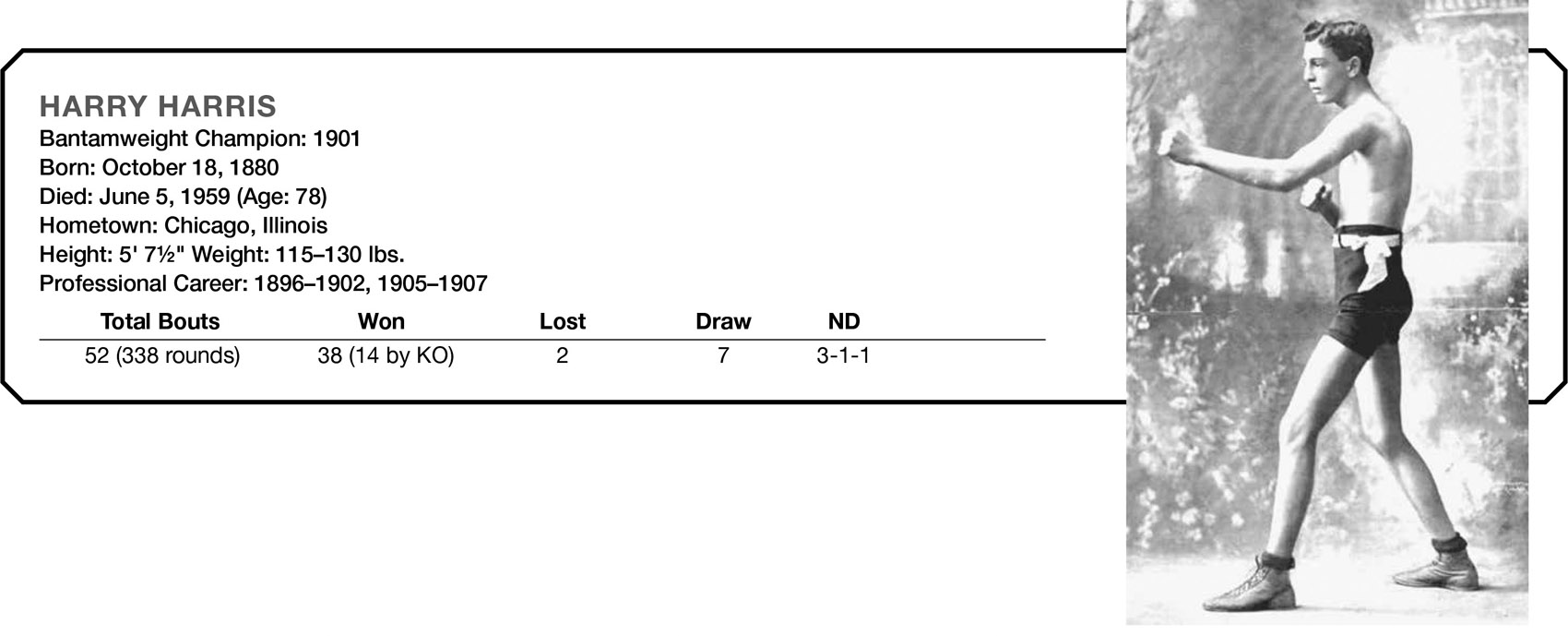
Harry Harris was the first Jewish world champion of the twentieth century. At five-foot-eight and 115 pounds, he was one of the tallest bantamweight champions in the history of the division. He was also one of the most accomplished boxers of his era. As a teenager he was mentored by the famous Kid McCoy, who taught him the tricks of the trade, including his signature “corkscrew punch.”
In 1901 Harry won the bantamweight championship of the world by outpointing England’s Pedlar Palmer in 15 rounds. He fought only three more times before announcing his retirement.
The decision to retire while still in his prime was prompted by a fortuitous meeting with theatrical impresario E. A. Erlanger. Impressed by Harry’s intelligence and engaging personality, Erlanger offered him a job managing the New Amsterdam Theatre in New York City. While working at his new profession Harry met his future wife, the actress Desiree Lazard, while she was costarring at the New Amsterdam with George M. Cohan in his hit musical, 45 Minutes from Broadway.
Harry liked the theater world and enjoyed his work, but he missed being center stage as the star of his own show. In 1905, three years after his last fight, Harry launched a brief comeback and engaged in six contests before returning to his job as a theater manager.
A man of many interests and talents, Harry became fascinated by the world of finance. In 1919, at the age of 39, he purchased a seat on the New York Curb (forerunner of the American Stock Exchange). He remained a Wall Street broker for the next 30 years, specializing in international securities.
BOXING SUFFRAGETTES
In America, prior to the 1920s, boxing had been off limits to women spectators. It was not considered “proper behavior” for a woman to attend a prizefight, and although no official ban existed, they were usually barred from entering an arena. That attitude began to change with the arrival of Tex Rickard, the great visionary promoter of the early 1900s. Not that Tex was a champion of egalitarianism; his motives had more to do with expanding his bottom line than expanding women’s rights. Tex believed the sport’s low-class image would improve if he could attract significant numbers of women to attend his boxing shows.
Rickard’s first attempt to integrate the all-male enclave occurred in 1906, the year he promoted his first “fight of the century”—an interracial title bout featuring the great African-American lightweight champion Joe Gans defending his title against Oscar “Battling” Nelson (aka, “The Durable Dane”) in the gold-mining boomtown of Goldfield, Nevada. Rickard announced to the press that he would allow women to attend the event. In an article published 11 days before the bout, Tex told a reporter he expected 250 to 300 women to witness the contest. He further explained that special preparations were being made to accommodate the female spectators.
“The arena will be filled by specially sworn-in officers who will see that nothing offensive is said or done,” said Tex. “No one under the influence of liquor will be allowed within the gates, and the officers will be instructed to eject any man who in any way transgresses the rules laid down by the club for the protection and comfort of the women.”16
Tex’s pronouncement was condemned by the local clergy. The pastor of the First Presbyterian Church of Goldfield, Reverend James Byers, warned his female congregants: “I will expel any woman who attends any prize fight from my flock.”17 Rickard could care less what the keepers of public decency had to say. He reveled in the pre-fight publicity the controversy aroused.
The Gans vs. Nelson title bout lived up to expectations. The grueling contest between “The Old Master” and “The Durable Dane” lasted an incredible 42 rounds under the broiling Nevada sun, until an exhausted “Battling” Nelson was disqualified for landing a deliberate low blow. How many women attended the bout was difficult to determine, as they disappeared into the crowd of more than 18,000 fans. But no matter the actual number, Rickard had irrevocably shattered a boxing taboo.
A decade and a half later, in the midst of the freewheeling Roaring Twenties, the presence of women at prizefights, especially for important contests, was by then a common occurrence. Tex Rickard, now ensconced in New York City, kept to his strategy of providing an atmosphere conducive to attracting the fairer sex. Under Rickard’s management, major boxing matches had become glamorous and exciting happenings. When the new Madison Square Garden opened in 1925, more than 17,000 thousand fans filled the arena for its first title fight, including a large segment of showbiz royalty and New York high society. They were all there to see and be seen. They filled the ringside section dressed in their evening clothes, the women among them “conspicuous in attendance and draped in elegant attire and wearing fine jewelry.”18
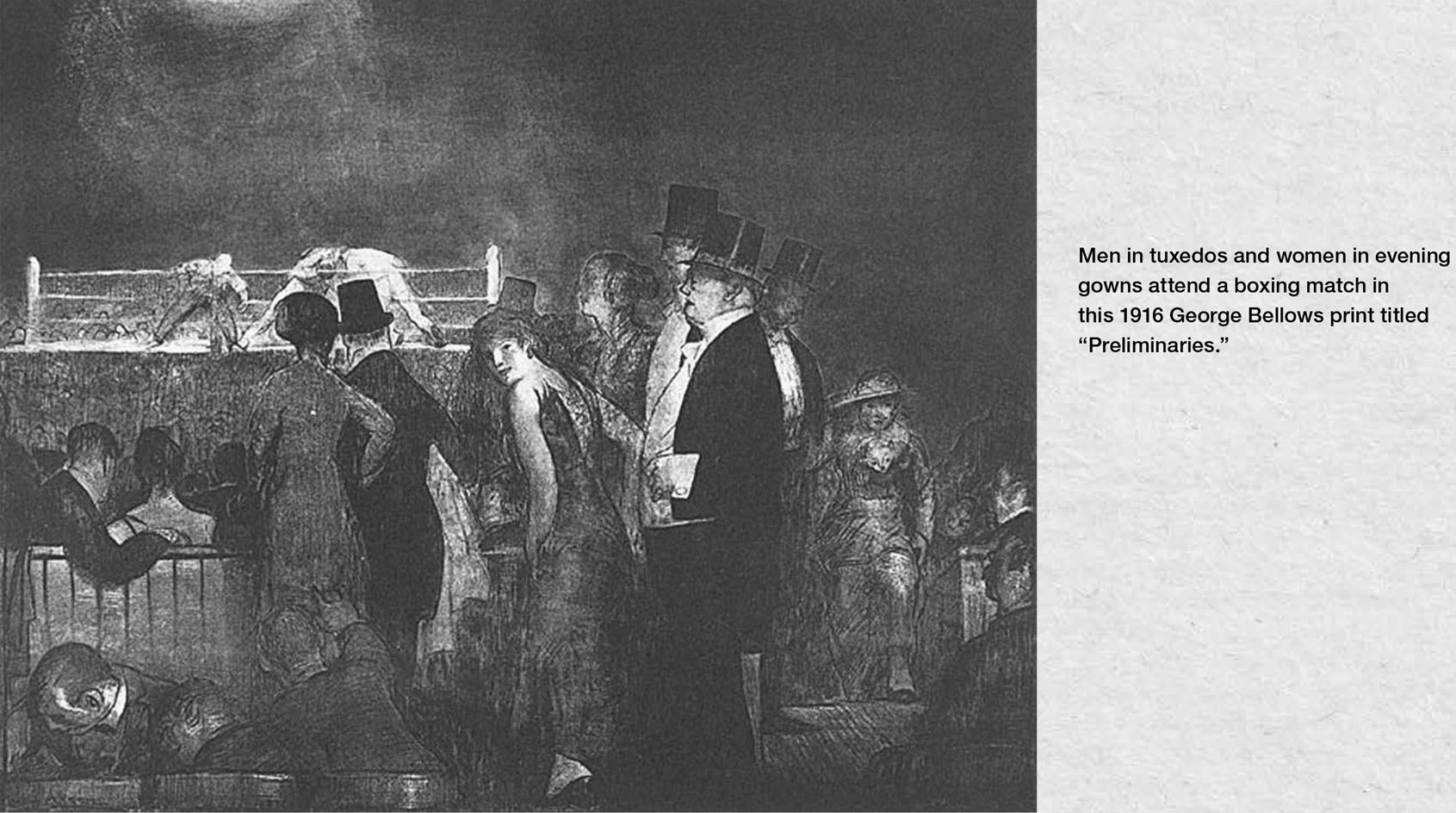
While it’s doubtful the presence of women at prizefights in the early years of the twentieth century contributed significantly to the women’s suffrage movement and the 19th Amendment, ratified in 1920, I wouldn’t dismiss the idea entirely. Sometimes it’s the accumulation of many small and seemingly insignificant advances that contribute to the larger victory. I like to think that Tex and those gutsy women who first entered the all-male world of the boxing arena did their part.
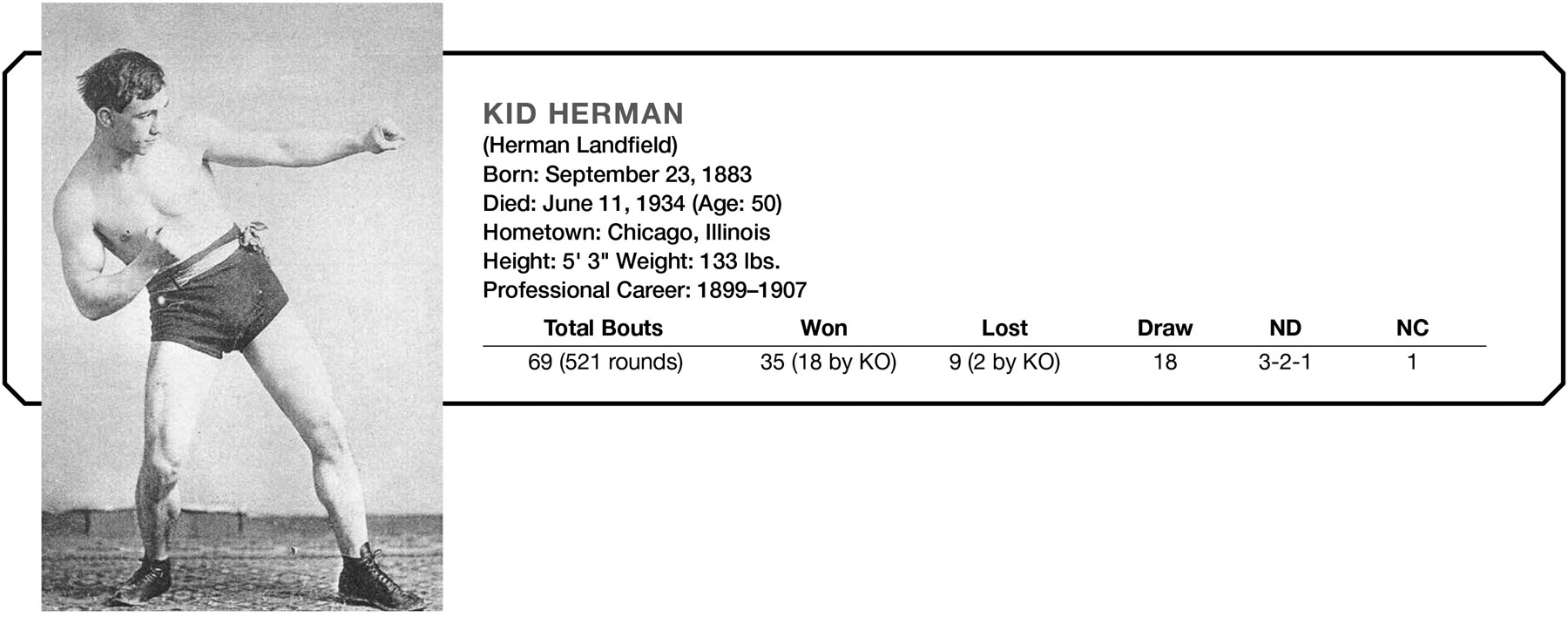
Kid Herman was born in Montreal, Canada, but moved to Chicago at an early age (not to be confused with another “Kid Herman,” who fought out of New York several years later). In his prime, Chicago’s Kid Herman fought draw decisions against the likes of Abe Attell, Aurelio Herrera, and Harry Lewis.
In 1907 Herman won a 10-round decision over highly rated lightweight contender Benny Yanger. That victory earned him a title bout with the brilliant lightweight champion Joe Gans, nicknamed “The Old Master” because of his artistic boxing skills. (Gans was the first black American to win a world boxing title, and is still considered one of the greatest boxers of all time.)
Herman made a good showing for seven rounds but was in over his head. Gans bided his time and knocked him out with a picture-perfect right cross in the eighth round. (A film of the fight exists and is available for viewing on YouTube.) Eleven months later he was badly beaten by Packey McFarland and retired. Kid Herman was killed in an auto accident in 1934.
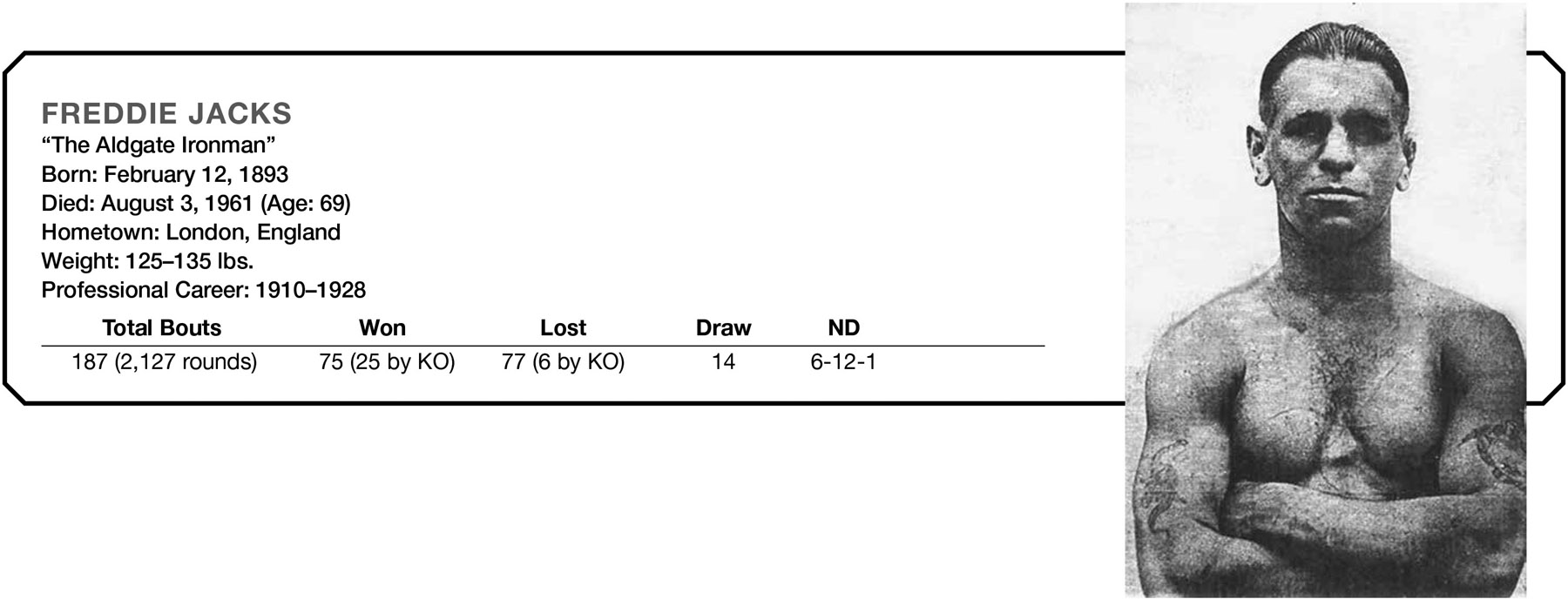
The boxing world used to stand on the shoulders of such men as England’s Freddie Jacks. A “have gloves, will travel” type, Jacks was a tough and seasoned journeyman who would fight anyone, anywhere. His services were always in demand because win or lose, he always put up stiff resistance and was rarely stopped. In his heyday Jacks was known as “The Aldgate Ironman.”
Jacks fought under several different names early in his career. His official record lists 175 fights, but the actual number is believed to exceed 200. Top opponents included world champions Johnny Kilbane, Rocky Kansas, Louis “Kid” Kaplan, Joe Dundee, and Jimmy Goodrich. Toward the end of 1922, Freddie traveled to Australia and had five 20-rounders in four months. He was also very popular in America, where he stayed for five years while participating in over 80 contests.
On June 25, 1923, in his only shot at a world title, Freddie was stopped in the fifth round by the great junior lightweight champion, Jack Bernstein.

There was no mistaking Willie Jackson’s profession: his flattened nose and heavily scarred eyebrows provided mute testimony to the countless punches he absorbed in 144 professional fights. Famed boxing journalist Dan Parker wrote that Jackson “was possibly the best club fighter of this or any other century.”*
Willie Jackson began his career as a “stick and move” speedster, scoring only six knockouts in his first 39 bouts. But on January 15, 1917, he shocked the boxing world (and himself) with a first-round knockout of the number-one featherweight contender, Johnny Dundee.
One of Dundee’s signature moves was to rebound off the ropes to gain extra momentum in his punches. But this time the great fighter miscalculated. As he caromed off the ropes his chin ran smack into Jackson’s right cross and he was counted out. (Not until 14 years later was another fighter able to stop the great Dundee, well past his peak and in his 328th professional bout.) Jackson and Dundee fought nine more times (a total of 105 rounds). All of their bouts were competitive, but Jackson was unable to duplicate his KO victory.
Jackson’s sensational upset of Dundee skyrocketed him to national prominence overnight. Convinced that he possessed knockout power in his right fist, Jackson abruptly altered his style, transforming himself into an aggressive pressure fighter who was willing to take a punch to land one. But the speed of his impressive windmill attack rarely allowed him time to set down on his punches, which accounted for his low KO percentage. Nevertheless, it was a style that was pleasing to the fans and earned him lucrative purses.
Other formidable opponents include Lew Tendler, Frankie Callahan, Leo Johnson, Pete Hartley, Jimmy Hanlon, Frankie Britt, Matt Brock, and future champion Rocky Kansas.
Jackson was past his prime when he suffered a brutal beating by lightweight contender Charley White while losing a 15-round decision at Madison Square Garden in 1922. Less than a year later Joe Shugrue stopped him in the 10th round. It was only the third stoppage he’d suffered in 147 pro bouts.
Jackson retired in 1924 and became a paper and twine salesman in New York City. But his long and punishing career as a boxer eventually took its toll. He was forced to retire in his late fifties, no longer able to work due to progressive dementia caused by the countless punches he’d absorbed in the ring.
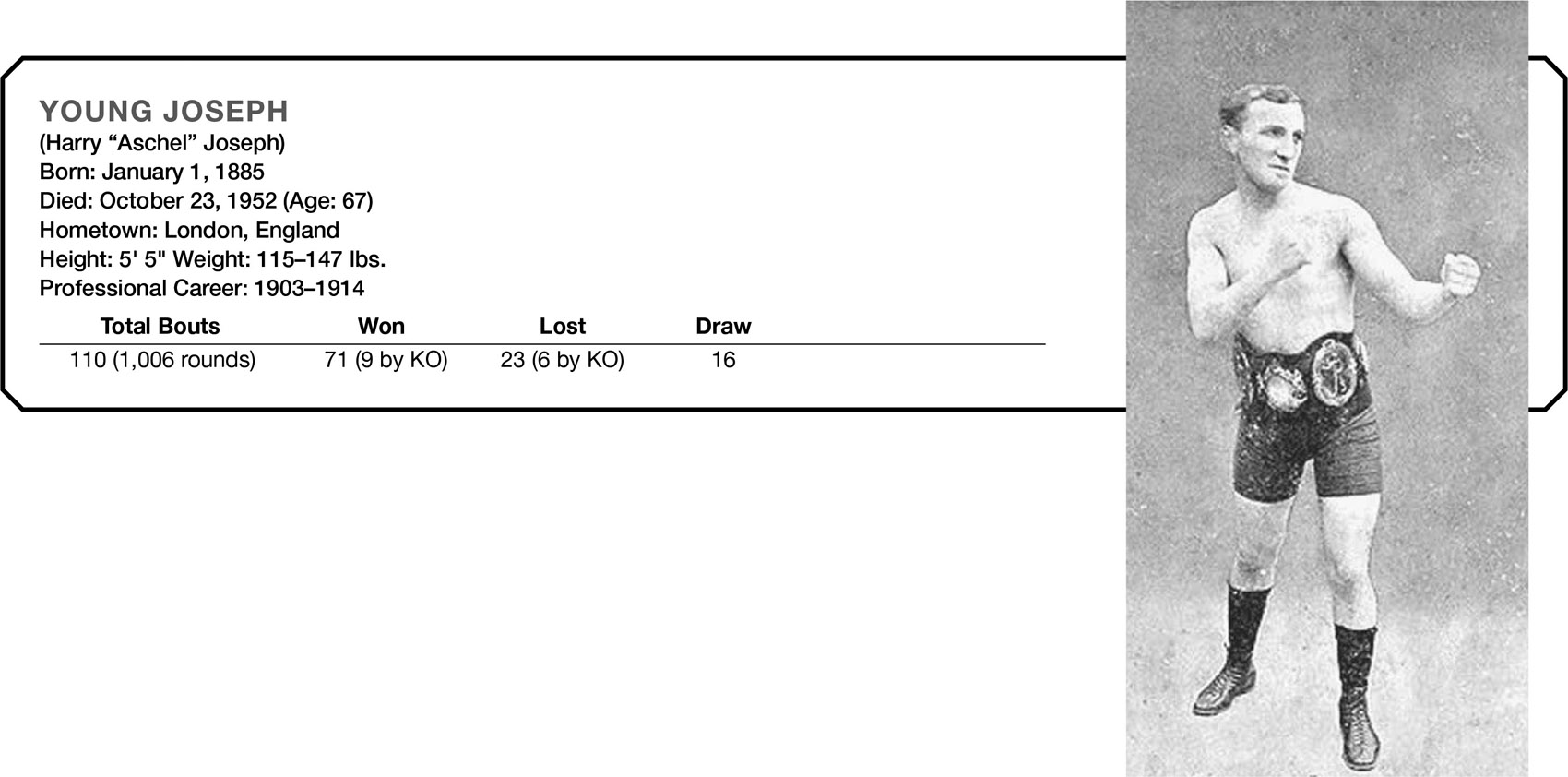
Young Joseph was one of England’s first Jewish boxing stars of the twentieth century and a role model to such boxers as Ted “Kid” Lewis and Jackie “Kid” Berg. He first attracted attention in 1903 after a series of victories at the legendary Wonderland Arena, a 2,000-seat emporium located on Whitechapel Road in London’s East End. The popular 18-year-old boxer did not pack much of a punch, instead relying on speed and cleverness to defeat his opponents. It was a style appreciated by knowledgeable English boxing fans. Joseph weighed about 120 pounds at the beginning of his career. The young boxer would eventually grow into a 145-pound welterweight.
In 1907 Joseph advanced his career by winning two 20-round decisions (two-minute rounds) over former British lightweight champion Jack Goldswain. Over the next three years he acquired both the British and European welterweight titles. Joseph traded punches with the likes of Johnny Summers, Young Otto, Rudy Unholz, Owen Moran, and future lightweight champion Freddie Welsh.
After his victory over Otto in 1909 Joseph claimed the world welterweight title. The claim was generally ignored by most boxing fans and authorities. The following year Joseph challenged the recognized welterweight champion of the world, Harry Lewis, and was stopped in the seventh round. In 1911 he lost his European welterweight title to France’s future light-heavyweight king Georges Carpentier via a 10th-round knockout. After hanging up his gloves Joseph stayed active in boxing as a manager and promoter.
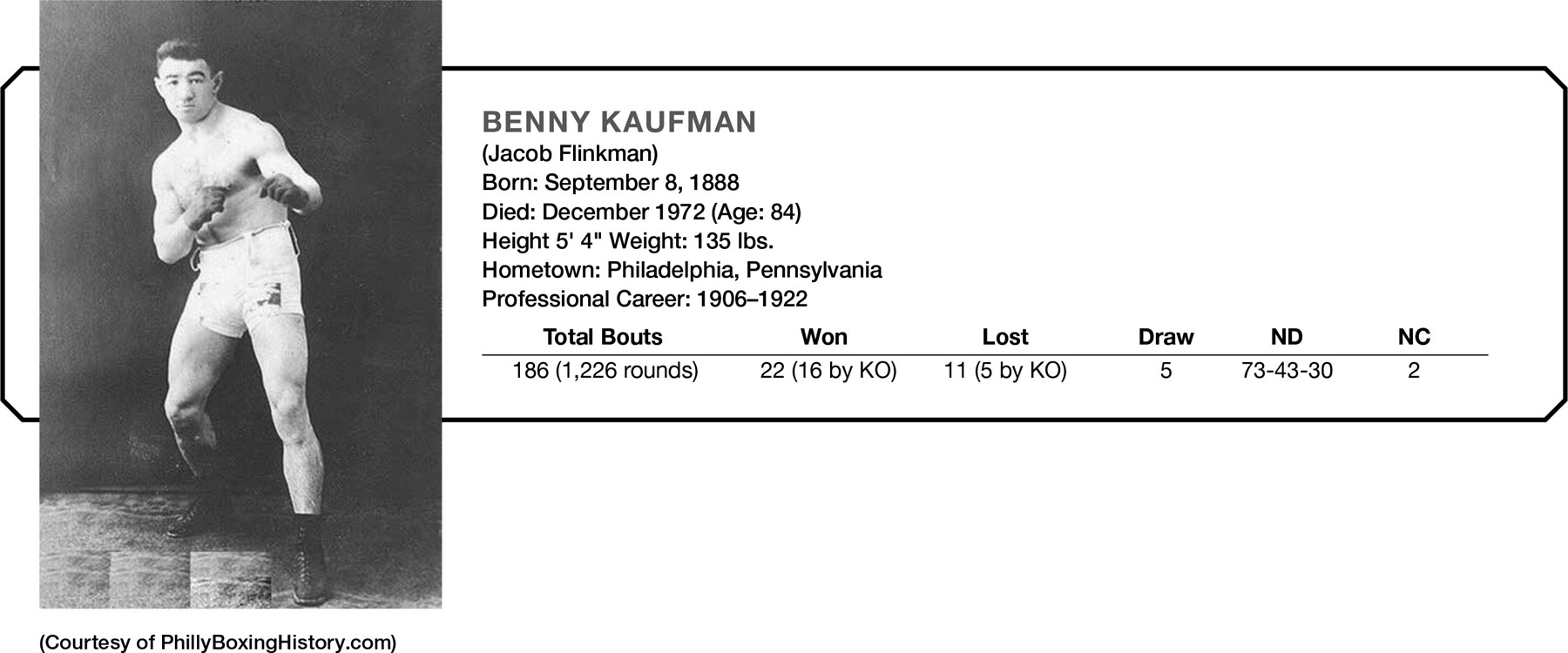
Russian-born Jacob Flinkman came to Philadelphia with his parents as a young boy in 1895. He began boxing in local amateur clubs at age 16. Two years later he turned professional as “Battling Flink,” but soon settled on the ring name of Benny Kaufman.
Kaufman was a five-foot-four, 135-pound block of granite. He plowed through 102 opponents in his first five years as a pro. Among his best performances was a 12-round draw with the great Charley White, along with newspaper verdicts over lightweight contenders Patsy Brannigan and Frankie Conley. In officially scored contests he lost decisions to highly rated lightweights Dutch Brandt and Al Shubert.
Other great opponents included Johnny Kilbane, Willie Jackson, Lew Tendler, George KO Chaney, Frankie Burns, former bantamweight champion Kid Williams, and a host of other long-forgotten featherweight and lightweight contenders. No-decision matches accounted for 136 of his 183 career bouts.
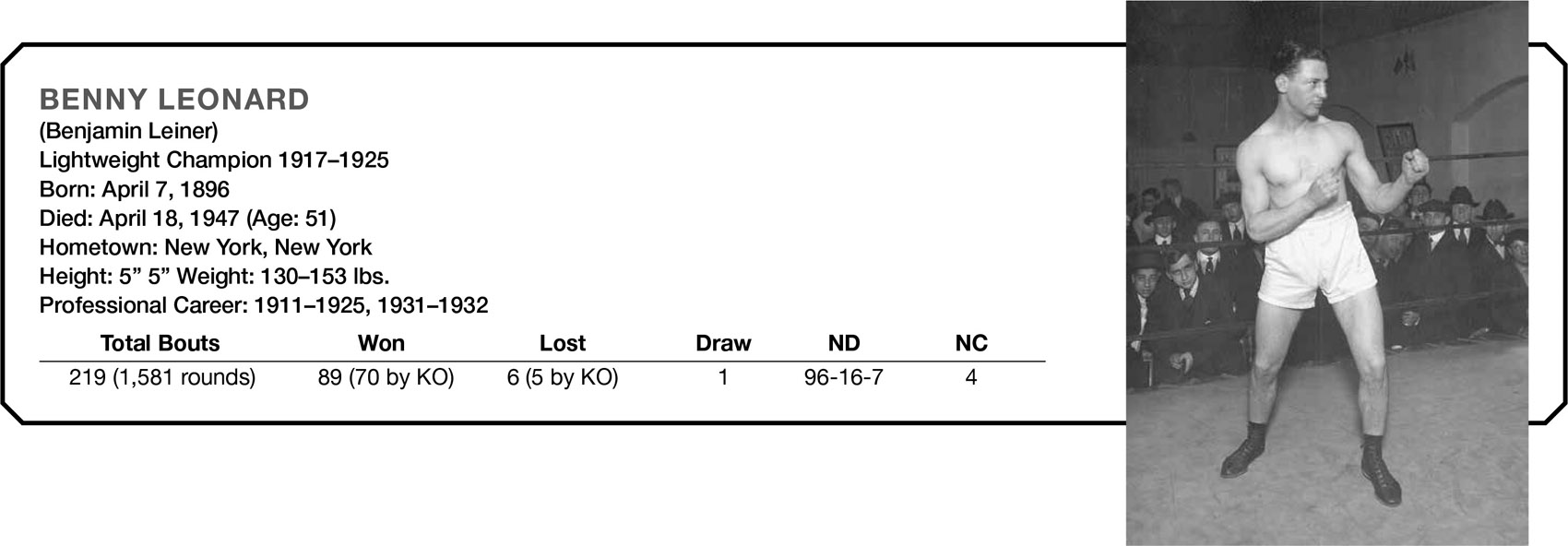
No decade produced more Jewish boxers than the 1920s—and the person most responsible for inspiring the flood of Jewish talent was Benny Leonard, who ruled the lightweight division from 1917 until his retirement as undefeated champion eight years later, in 1925. The greatest compliment any Jewish boxer could receive was to be called “the next Benny Leonard.”
It is not surprising that a fighter who considered his brain the most important weapon in his formidable arsenal would view boxing as a physical game of chess. And like a master chessman, Benny Leonard set subtle traps and ambushes without ever “telegraphing” his intentions. His goal as a boxer was to quickly determine an opponent’s habits, his strengths and his weaknesses, disrupt his game plan, and then do what was necessary to win. He developed his superb jab and defensive maneuvers during his early teen years when he was a slightly built 115-pound bantamweight who could not afford to mix it up with stronger opponents. As his frame filled out and he grew stronger and heavier, Leonard added a powerful right-hand punch to his repertoire.
In his prime Leonard was far superior to most of his opponents, but he never sought to humiliate them. “I don’t want to hurt the other guy,” said Leonard. “I want to stop him. But that does not mean I am eager to cut him up and murder his self-respect. The credo of the professional ring is to win with speed and your best means of execution. As for that ‘killer instinct,’ I never had it as a kid when bringing home the pay was very important, and I never had it as champion.”19
Oftentimes Leonard would be content just to outbox an opponent and sharpen his reflexes while getting a good workout. But every now and then he would decide to deviate from the plan. “Many a night I would be in there just looking for a workout with no idea of knocking my man out,” Leonard said after his retirement. “But there’d always be a loudmouth who’d start yelling, ‘Leonard, you’re a freaking bum,’ or worse. He’d keep it up and I’d get sore and quite a few guys got flattened that wouldn’t have been hurt otherwise, just because some dope in the crowd wouldn’t keep his mouth shut.”20
In his all-consuming desire to understand and master the art of boxing, Leonard set about to deconstruct and analyze every aspect of the sport. Leonard was a brilliant boxer, but he also had the heart of a warrior, and was not averse—when the situation called for it—to throw caution to the wind and mix it up. But always that nimble brain would be working overtime as he sought openings for his devastating right-hand counterpunch. He did not start out as a puncher, but after several years developed knockout power by perfecting the right combination of timing, distance, leverage, and speed, and began to score knockouts over some of the toughest lightweights who ever lived. Leonard had taken the science of pugilism to a level not seen before. Historians consistently rank him among the 10 greatest fighters, pound for pound, of all time.
Who was this man who brought a balletlike grace to the sport? He didn’t even look like a fighter. His face was unmarked, and his body, not particularly muscular. He was really a nice Jewish boy with an extraordinary talent and a driving ambition to be the best at his craft. If you didn’t know his true profession you’d think he was an accountant, perhaps a teacher or businessman—the type you could bring home to dinner and introduce to your sister.
Leonard was well-spoken (he once challenged the noted philosopher Bertrand Russell to a debate as to the merits of boxing). He took his responsibility as a representative of the Jewish people seriously, often donating his services to both Jewish and Catholic charitable causes. As noted by author Franklin Foer, Leonard’s conduct, in and out of the ring, and his impeccable public image “stood as the refutation of the immigrants’ anxiety that boxing would suck their children into a criminal underworld or somehow undermine the very rationale for fleeing to the Golden Land. Benny Leonard legitimized boxing as an acceptable Jewish pursuit—and even more than that, he helped make sports a perfectly kosher fixation.”21
Like all great artists Leonard constantly strove for perfection but was never satisfied. When asked by legendary trainer Ray Arcel why he studied four-round preliminary fighters sparring in the gym, Leonard replied, “You can never tell when one of those kids might do something by accident that I can use.”22
When it was time for his own workout to begin, every fighter in the gym stopped to watch this “professor of pugilism” shadowbox or spar. To sharpen his alertness he would sometimes spar with two boxers at the same time. The day after a fight he’d be back in the gym, talking over tactical mistakes.
“The coordination of mind and muscle was just outstanding,” recalled Arcel. “Leonard would feint you into knots. If you were a rough tough fellow he would back you up. If you were a very clever fellow and laid back waiting to counterpunch, he would draw you in, make you lead, and then have you fall short with your punches and counter. Leonard was a student of the human body. He was a place puncher who knew just where to hit you. A left hook to the liver was his favorite punch. He moved with terrific speed, in and out, in and out, side to side, and if you weren’t in perfect condition you’d be pretty tired after that first round and he would be just starting in.”
Benjamin Leiner was born on April 7, 1896, in a tenement on New York’s Lower East Side. His parents, Minnie and Gershon Leiner, were recent immigrants from Russia. Gershon struggled to support a wife and eight children by working 12- to 14-hour days in a garment-trade sweatshop for $20 a week. It was a hardscrabble life.
Benny began his professional boxing career in 1911 at the age of 15. Six years and 116 fights later he won the lightweight championship of the world via a ninth-round TKO of Freddie Welsh. It was the only time Welsh was ever stopped in 168 fights.
Less than two months after defeating Welsh, Leonard knocked out the great featherweight champion, Johnny Kilbane, in the third round. It was only the second KO loss in 122 bouts for Kilbane, who would continue to rule the featherweight division for another six years.
Leonard boasted that no fighter could muss his hair in a fight. (It helped that he plastered down his “patent-leather locks” with an industrial-strength gel that would have held up in a wind tunnel.) When Leo Johnson, the country’s outstanding black lightweight contender, attempted to unnerve him by mussing up his hair during a clinch, Leonard responded by knocking Leo out in less than two minutes of the first round. (It was only the second time in some 150 bouts that Leo Johnson was stopped; his other knockout loss had occurred six years earlier against the great Abe Attell.)
During Leonard’s tenure as champion his toughest challenger was the great Philadelphia southpaw, Lew Tendler. Their first bout took place in Jersey City. Over 50,000 fans were on hand to witness an intense and dramatic 12-round seesaw battle.
In the eighth round Tendler connected with a right to the body and left hook to the head that caused the champion’s knees to sag. Although hurt, Leonard’s hair-trigger brain came to the rescue. As Tendler closed in for the kill Leonard spoke to him. It has come down the pike as either “Keep your punches up, Lew,” or the same words (or some variation) addressed to Lew in Yiddish. Whatever was said, in whatever language, it was enough to cause Tendler to hesitate for the few seconds Leonard needed to clear his head and recover his equilibrium. The 12-round bout was “no-decision,” so there was no official winner or loser. A majority of newspapers covering the match had Leonard winning a close 12-round decision. Several others either named Tendler the winner or scored it a draw.
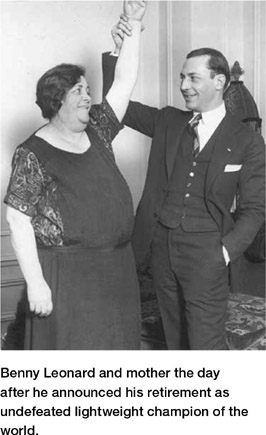
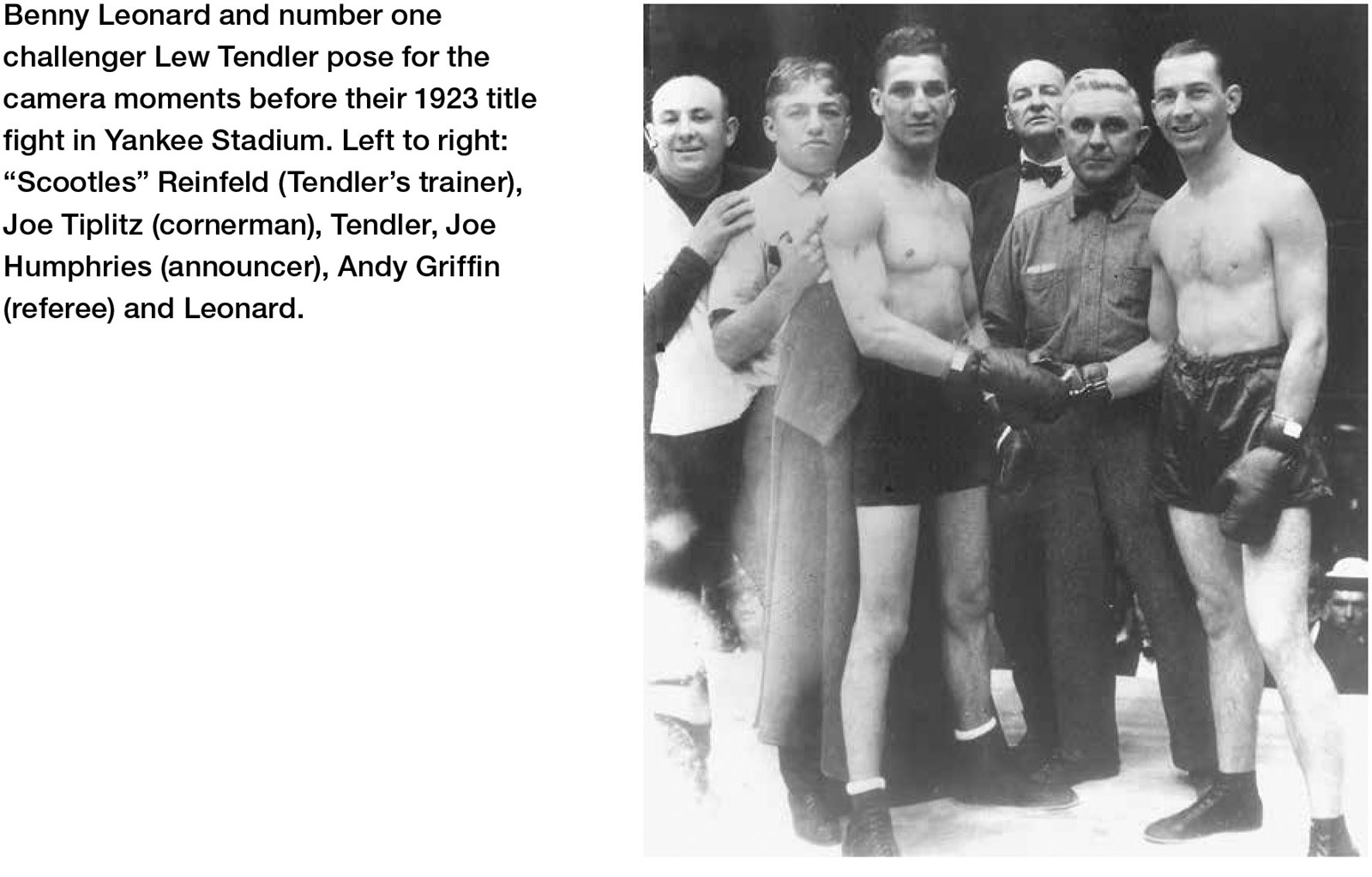
The highly anticipated rematch took place on July 22, 1923, in Yankee Stadium, one year after their first meeting. Sixty-three thousand fans witnessed the two great Jewish boxers fight it out for the lightweight championship of the world.
Leonard’s exquisite performance that hot July evening was nothing short of astonishing. In their first fight Tendler’s awkward southpaw style had disrupted Leonard’s rhythm. That was no longer a problem. No matter what the challenger tried—and to his credit, he tried incessantly— he could not land a solid punch on the elusive champion, who seemed to anticipate Tendler’s every move. In the last few rounds he absorbed a tremendous pounding but would not go down. Leonard won a unanimous 15-round decision.
Eighteen months later, on January 15, 1925, Leonard announced his retirement as undefeated champion. He was only 28 years old, but had been a pro for 13 years. Despite having engaged in almost 200 professional fights, his intellect was intact, and he was financially set for life.
True to his public image Leonard told the press that his mother had wanted him to retire, and it was concern for her health that had prompted him to hang up his gloves. A headline in the New York Times the following day read, “Leonard Quits Ring on Mother’s Plea.” Leonard is quoted as saying: “I am retiring from boxing for the love of my mother, who has begged me not to fight again.” Photos of Leonard and his mother appeared in newspapers across America with the caption, “Benny Leonard’s Ma announces his retirement.”
A few days after the announcement, Arthur Brisbane, a nationally syndicated columnist for the Hearst newspaper chain (the largest newspaper chain in the country), wrote a column stating that Benny’s reputation as champion and his numerous charitable contributions “did more to conquer anti-Semitism than 1,000 textbooks . . . and has done more to evoke the respect of the non-Jew for the Jew than all the brilliant Jewish writers combined.”23 Whether one agrees with those words or not, they accurately reflect the importance of boxing to the popular culture at that time.
After he retired Leonard kept busy with vaudeville engagements, appearing in plays or acts that combined elements of dancing, sparring exhibitions, and comedy. He also starred in a silent-film serial. Leonard invested some of his ring earnings in commercial enterprises, such as a dry-cleaning business, real estate properties, and a professional hockey team. In the late 1920s he was partner in a summer camp in New York’s Catskill Mountains named Camp Hakoah (in Hebrew, “strength”) that taught young Jewish boys self-defense.
But everything went sour in 1929 with the collapse of the financial markets and the beginning of the Great Depression. Millions of people lost their life savings, including Leonard, whose personal fortune, heavily invested in stocks and estimated at close to a million dollars, was wiped out.
The former ring great was in dire financial straits. Boxing offered the best opportunity for him to recoup some of his losses. So two years after the market crash, the greatest Jewish boxer who ever lived was back in the ring at the age of 35, sporting an uncharacteristic paunch and a receding hairline. He’d been out of boxing for almost seven years.
From 1931 to 1932 Leonard won 19 fights against handpicked opponents unlikely to derail his comeback. His speed, timing, and coordination began to improve to the point where he would, on occasion, show flashes of his old form. What he was hoping for was one big payday against a name opponent.
The opportunity materialized on October 7, 1932, at Madison Square Garden, almost a year to the day from the start of Leonard’s comeback. His opponent was a tartar—the number-one welterweight contender, Jimmy McLarnin, one of the deadliest punchers in the division.
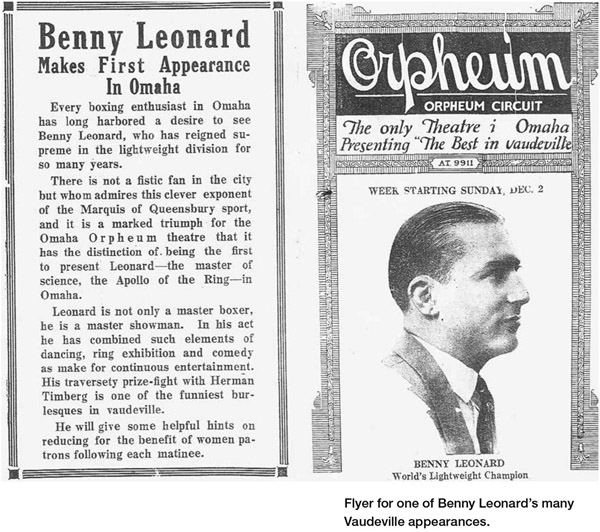
Leonard vs. McLarnin generated tremendous excitement, because Irish Jimmy had already knocked out half a dozen outstanding Jewish fighters. If Leonard could defeat McLarnin he would accomplish the dual goals of payback and payday. A few newspapermen and many fans—thinking more with their hearts than their heads—were of the opinion that the aging ex-champion stood a good chance to outbox McLarnin. Of course, this was wishful thinking. McLarnin was a great fighter in his prime, and only seven months later he would win the welterweight championship of the world with a first-round knockout.
The Garden was packed to the rafters with 19,000 fans, many of them Jewish, who were hoping and praying for a miracle.
Less than two minutes into the fight Leonard’s right hand struck “like a serpent’s tongue” and made contact with McLarnin’s chin. The punch and its setup was vintage Leonard. Stunned momentarily by the punch, McLarnin’s knees brushed the canvas. The crowd was in a frenzy. McLarnin was hurt and forced to retreat and clinch. But Leonard at age 36 was too slow to follow up his brief advantage. McLarnin quickly recovered, and by the end of the round had taken charge. He dropped Leonard in the second round and from then on retained the initiative. Only Leonard’s superb defensive skills kept him in the fight for the next three rounds.
In the sixth round a series of damaging punches dazed Leonard and had him hanging on. In an act of mercy that no one in the arena objected to, referee Arthur Donovan halted the fight to save Leonard from further punishment. The old champ protested, saying he had not been floored, but Donovan had made the right call.
The $15,000 Leonard received for the McLarnin fight helped to ease his financial problems. The following year he married his longtime secretary, Jacqueline Stern, and settled into married life. In his post-retirement years Benny, an entertaining storyteller, was in great demand as a lecturer and after-dinner speaker. In the mid- 1930s he was briefly employed by the City College of New York, where he taught boxing in their physical education department. When the United States entered World War II he enlisted in the Maritime Service and was placed in charge of the physical training of nearly 100,000 men. (He had served in a similar capacity in the army during World War I.) Before his three years of service ended, he rose to the rank of lieutenant commander.
Benny always stayed close to his beloved sport. He was a licensed referee and often officiated in New York and Philadelphia. On April 18, 1947, he was assigned by the New York State Athletic Commission to referee an entire fight card at the St. Nicholas Arena in New York City. During the first round of the last fight of the night, he suddenly collapsed in the ring. The ringside physician, Dr. Vincent Nardiello, attempted to revive him, but to no avail. Benny Leonard had suffered a fatal massive heart attack. He was 51 years old.
For as long as the sport of boxing survives, Benny Leonard will always remain the Gold Standard to which all other Jewish boxers are compared.
NEWSIES
At the turn of the last century most people in America read a daily newspaper if they wanted to know what was going on in the world. Every major city had at least five or more dailies for sale. Newsboys, some as young as five or six, could earn change by hawking the papers on street corners. Old movies often featured a realistic scene of a newsboy shouting “Extra, extra, read all about it!” Most of the “newsies,” as they were called, were school truants, and all were born into poverty. Times were tough, but so were the street urchins who sold their employer’s newspapers. Bullies looking to take over a smaller boy’s “territory” were a constant threat. Knowing how to fight was a useful survival tool. Thousands of future professional boxers first put up their dukes in defense of their prized street corners. No wonder many of them sported the nickname “Newsboy.”
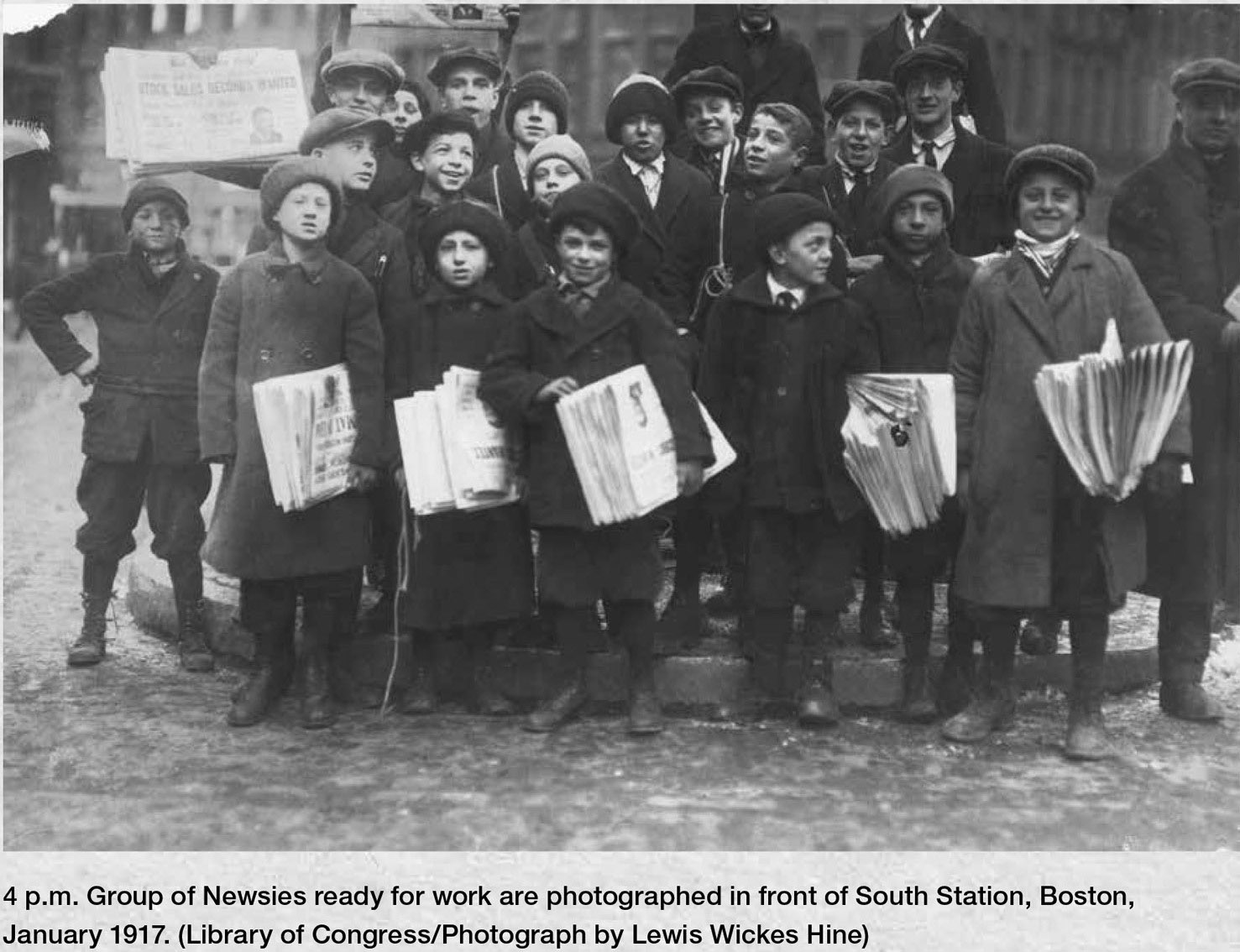
Competition among newspapers in the same city was intense. Owners were known to hire “sluggers” (aka, “head breakers”) armed with blackjacks to take over the most lucrative corners from the competition. Older boys banded together and stood their ground against the sluggers, fighting back with fists, bricks, and whatever else was at hand.
Around 1905 someone got the idea to stage an amateur boxing tournament featuring the best of the newsboy fighters. The newsboy tournaments became an annual event in several cities, and lasted into the 1920s. In Philadelphia the bouts were usually the opening act at burlesque houses and were very popular with audiences. The newsies were paid just pennies for their efforts.
The first New York City tournament culminated in the crowning of an “American Newsboy Champion.” Future Jewish lightweight contenders Harry Stone and Lew Tendler were among the first tournament winners.24
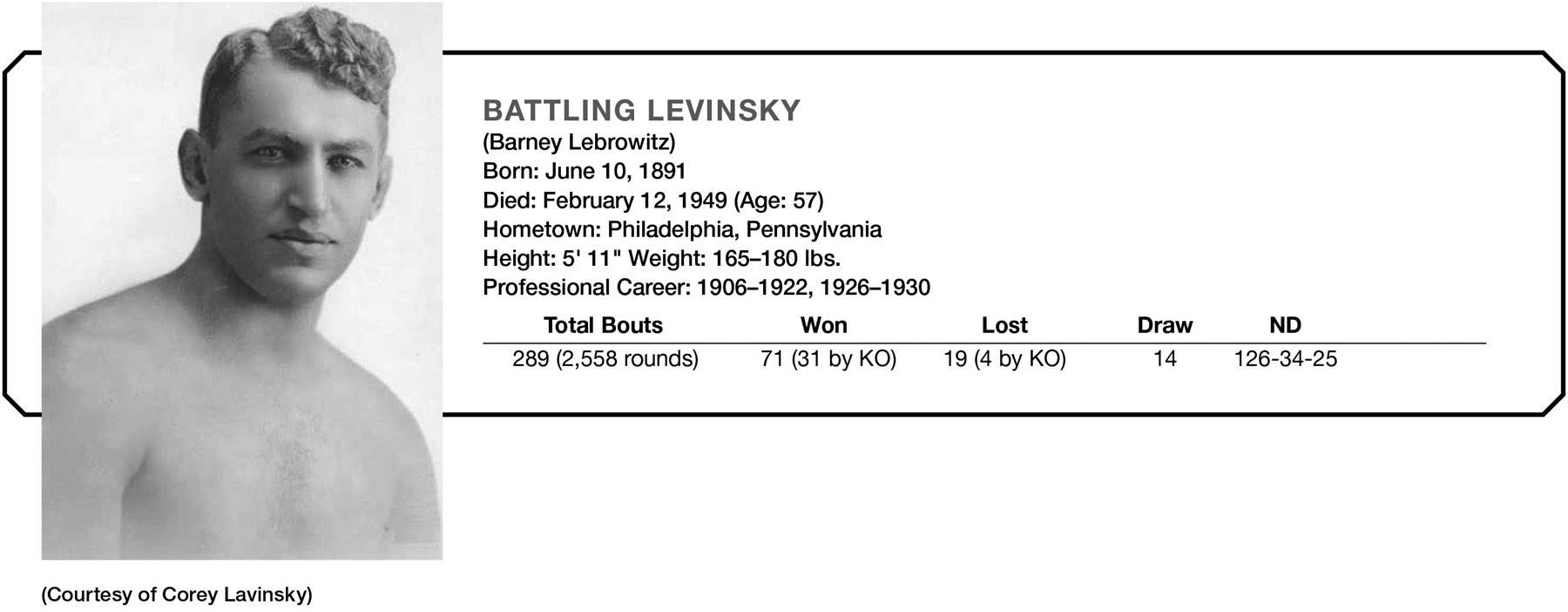
Barney Lebrowitz’s all-consuming desire to become a professional fighter was tempered by the knowledge that his Russian-born immigrant parents would be greatly distressed if they knew of his career choice. So when Barney turned pro in 1906, at the age of 15, he adopted the name “Barney Williams.”
Barney knew that if he came home with a black eye or broken nose his parents might suspect the worst, so he made it his business to perfect his defense. He spent countless hours in Philadelphia gyms studying the defensive maneuvers of master boxers Jack Blackburn, Harry Lewis, and Philadelphia Jack O’Brien.
With these great fighters as his mentors, Barney learned how to use his footwork for both offense and defense. He also learned how to smother an opponent’s punches by maneuvering inside or to blunt an assault with a viselike clinch. The young fighter became adept at “riding” with punches to lessen their full effect. Barney eventually mastered the finer points of his art as few have, and developed into a very clever but unexciting boxer.
Seven years into his career Barney acquired a new manager, the very capable “Dumb” Dan Morgan. The dapper manager was anything but dumb. In fact, he was one of the shrewdest managers in the business. Aside from his sharp negotiating skills, Morgan was a master publicist. The ink was barely dry on their contract when he insisted that his new meal ticket change his fighting name to the more colorful “Battling Levinsky.” Morgan then sent out press releases to hundreds of newspapers challenging every Irish contender east of the Mississippi to step into the ring with his Jewish tiger.
The strategy worked. Offers began flooding Morgan’s office. Within a very short time Levinsky became one of the world’s busiest fighters. His official record lists a total of 288 fights, but a more-accurate number would fall somewhere between 300 and 400 contests.
One story in particular captures the unique quality of Levinsky’s over-the-top ring activity. On a rare night off, the Battler decided to attend a Broadway show with a date. Just as the curtain was about to go up, his manager appeared and told him he was needed over at St. Nick’s arena, a few blocks from the theater, to sub for another fighter who failed to show. After telling the young lady he would be right back and not to worry, he dashed over to St. Nick’s, changed into his ring togs, and proceeded to flatten his opponent in the second round. The second act of the show was still in progress when he arrived back at the theater to take his seat.25
Although he was a light heavyweight who rarely tipped the scales over 180 pounds, he often crossed gloves with the top heavyweight contenders. He more than held his own with Gunboat Smith (six times), Bill Brennan (four times), Fireman Jim Flynn, and Billy Miske. Levinsky’s superlative defensive skills made him almost impossible to knock out.
The highlight of his long career occurred in Boston on October 24, 1916, when the 25-year-old boxer won the light-heavyweight championship of the world by outpointing Jack Dillon over 12 rounds. Levinsky was already quite familiar with Dillon’s style—it was their 10th meeting! Levinsky remained champion for the next four years. The shrewd Morgan would only have him risk his title in no-decision fights, so the only way he could be dethroned was by knockout. His toughest bouts were six no-decision encounters with the famed “Pittsburgh Windmill” Harry Greb.
In November 1918 Levinsky was knocked out in the third round by future heavyweight champion Jack Dempsey. It was the first knockout defeat suffered by Levinsky in over 250 fights. Three weeks later the Battler was back in the ring, outpointing middleweight contender Leo Houck in a six-round bout.
Levinsky lost the light-heavyweight title in 1920 to France’s Georges Carpentier via a fourth-round KO. The quick ending was so unexpected that many people thought the fight had to have been fixed, but the allegations were never substantiated.
The Battler’s last major fight was a 12-round decision loss to future heavyweight champion Gene Tunney in 1922. The 31-year-old Levinsky could not match the speed and accuracy of his much younger opponent. The loss convinced him it was time to retire.
Several business reversals forced Levinsky back to the ring four years after his loss to Tunney. He had 40 additional fights, mostly against second-rate opposition. Unfortunately, most of his savings and investments were wiped out in the 1929 stock market crash. Too old to make another comeback, he struggled to support his wife and two young children by working as a real estate agent and as the owner of a boxing gym. During World War II he was a steelworker in a Philadelphia shipyard.
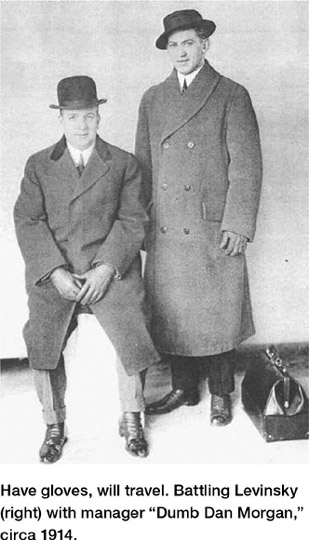
In January 1945 the old Battler received a blow that he never recovered from: His 22-year-old son, Stanley, a private in the United States Army, was killed in the Battle of the Bulge. Barney Lebrowitz, aka, Battling Levinsky, passed away four years later after contracting pneumonia. He was 57 years old.
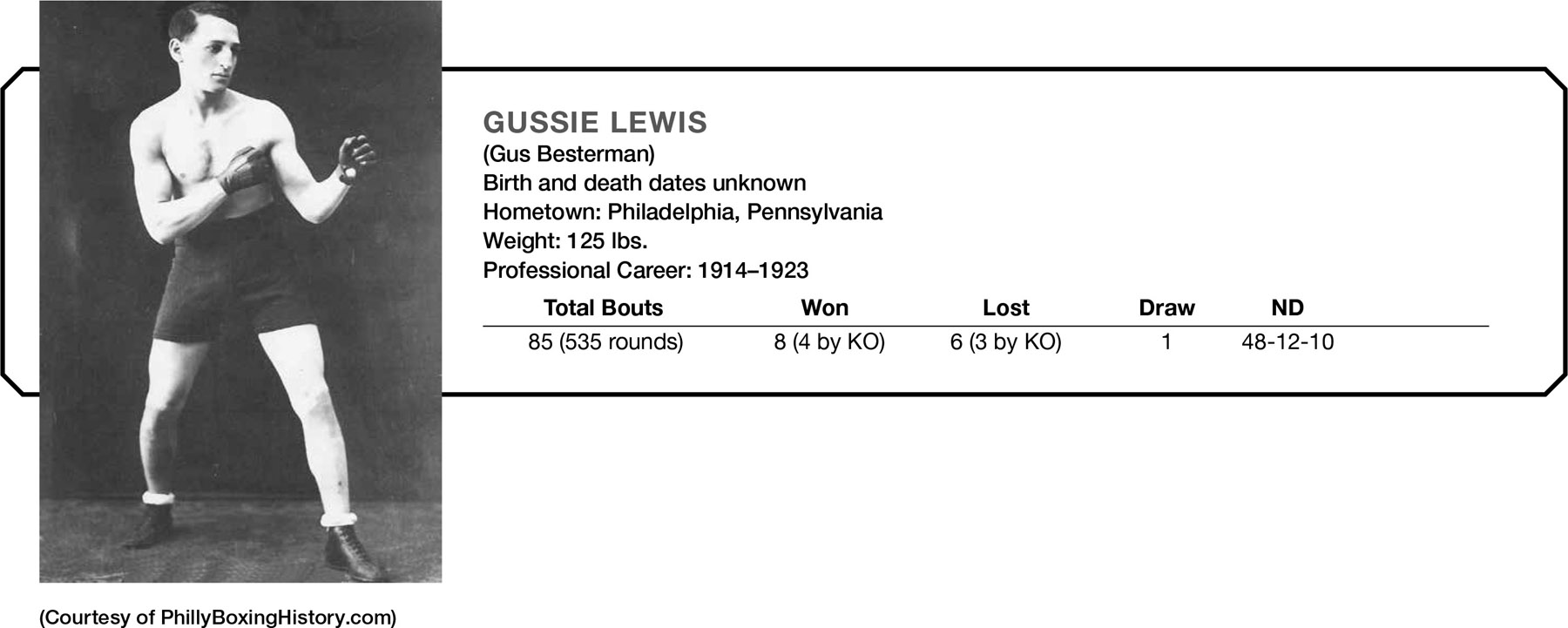
Gussie Lewis is the younger brother of the great welterweight champion Harry Lewis. He was an outstanding bantamweight contender during the second decade of the twentieth century. Most of his bouts took place in Philadelphia at a time when local law required all prizefights not to exceed six rounds. Only 11 of Lewis’s 85 documented bouts were scheduled beyond six rounds. Over the short route he outhustled the likes of Benny Valgar, Dutch Brandt, Joe Tiplitz, Benny Kaufman, and future champion Steve “Kid” Sullivan. Although not a heavy puncher, Gussie was extremely fast and difficult to hit. He retired after a knockout loss to Benny Valgar in 1919, but returned four years later for one more bout.
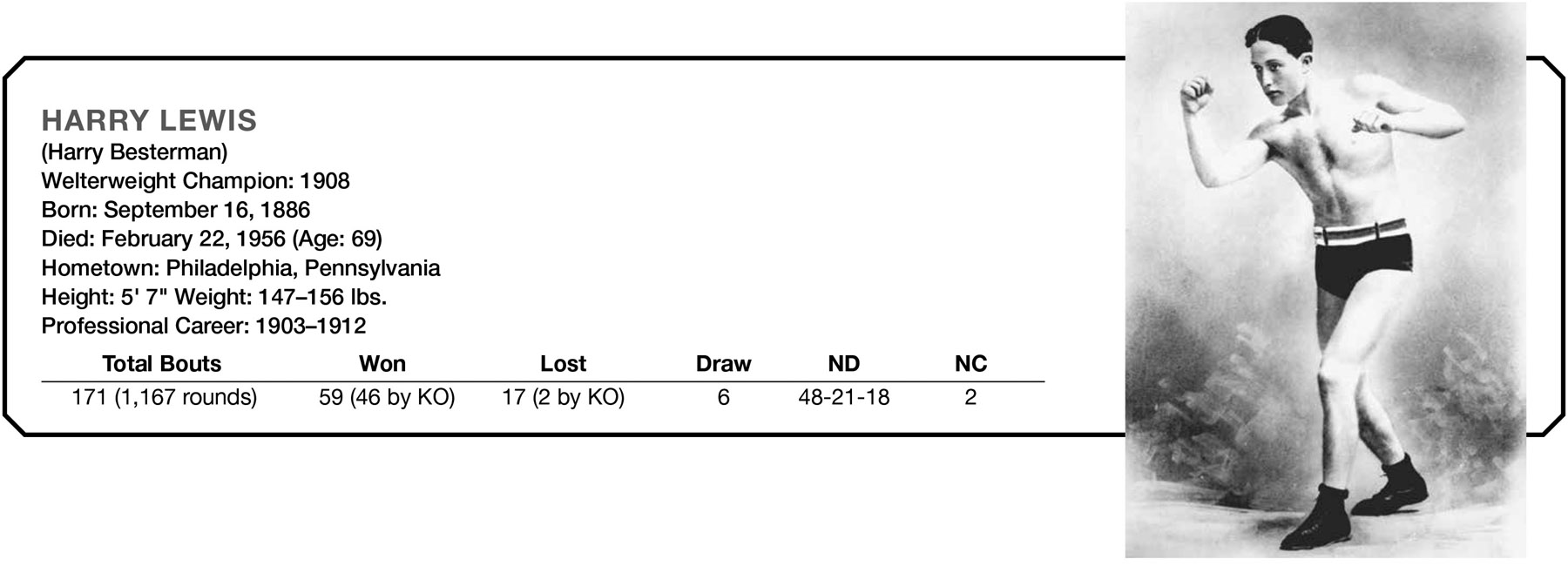
At age 21, Harry Lewis was already a veteran of 100 professional fights. He claimed the welterweight title in 1908 after knocking out Frank Mantell in three rounds. Three months later he solidified his claim with a fourth-round knockout of former champion Honey Mellody.
During his drive to the title Harry encountered the best fighters of his era, including future lightweight champion Joe Gans and top contenders Jack Blackburn, Aurelio Herrera, Young Erne, Jimmy Gardner, and Benny Yanger. Unfortunately, one of his earlier fights ended in tragedy when his opponent, Mike Ward, died of a brain injury after being knocked out in the ninth round.
In 1910 Harry traveled to Paris for a fight with New York’s welterweight contender Willie Lewis (no relation). Both contests ended in 25-round draws. The Parisians loved the elegant boxing style of the handsome American redhead. In all, Harry fought 13 times in Paris. He also crossed the English Channel a dozen times to display his talent for British boxing fans. Harry’s first fight in London was against another Jewish fighter, the very popular English welterweight champion “Young” Joseph. Harry won by a seventh-round knockout. In his last fight in Paris, Harry was outpointed by future light-heavyweight champion Georges Carpentier.
Harry gave up the welterweight title in 1911 when he could no longer make the 147-pound weight limit. For the next two years he campaigned as a middleweight.
Six months before facing Philadelphia middleweight contender Joe Borrell, Harry was badly injured in an automobile accident. Perhaps his collapse in the ring before the start of the sixth round of his bout with Borrell was related to the accident, and compounded by his opponent’s punches.
Harry was rushed to a hospital where doctors diagnosed a blood clot on his brain. He regained consciousness but remained partially paralyzed on his left side. Eventually he recovered enough to obtain a job as a security guard for Gimbels department store in New York City.
Although he is one of the lesser-known Jewish world champions, Harry Lewis was held in very high esteem by his contemporaries. In 1958 boxing historian Nat Fleischer, founder and publisher of The Ring magazine, rated him the sixth-greatest welterweight.
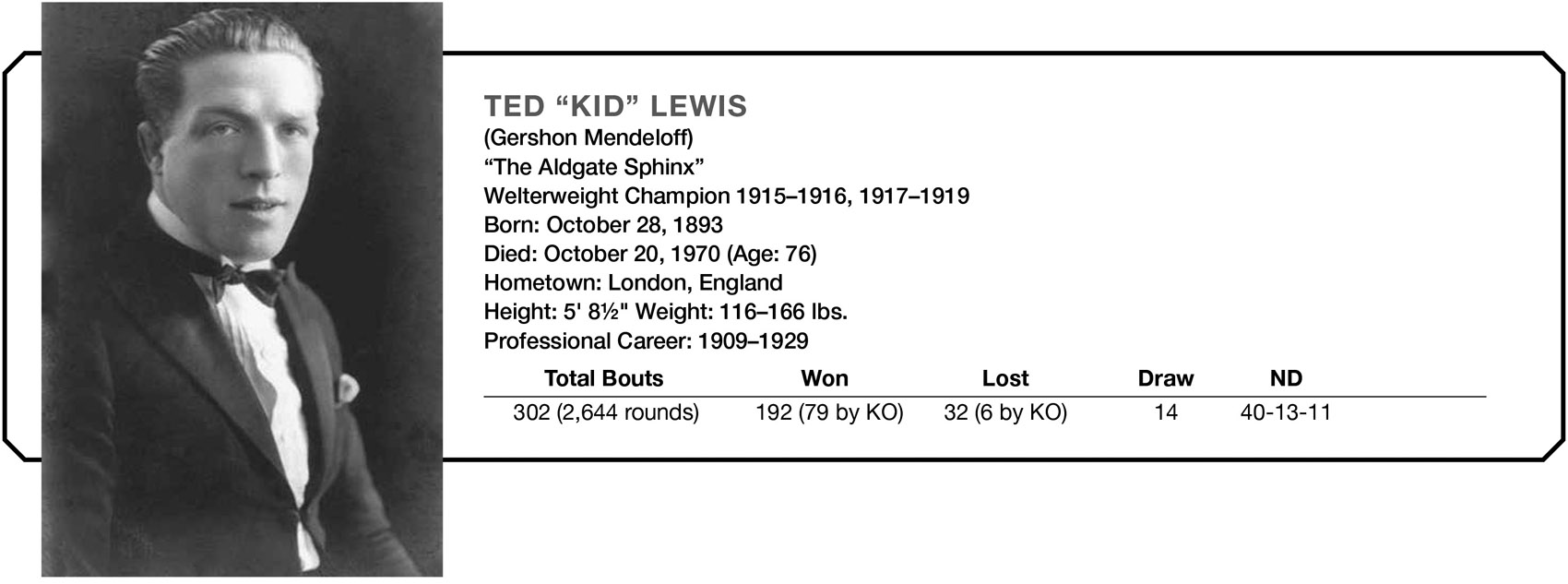
Ted “Kid” Lewis established one of the most remarkable records in the annals of the prize ring. Even in an era when many boxers fought two or three times a month, Lewis’s schedule of activity was off the charts. He belongs to that small group of iron men who fought over 300 professional bouts. Lewis also holds another distinction: In 1913 he became the first professional fighter to wear a dentist-designed rubber mouthguard (or gumshield). Lewis’s action encouraged the acceptance of the mouthguard for all boxing matches throughout the world.
Born Gershon Mendeloff in the Aldgate section of London’s East End, the future ring great was one of eight children of an immigrant cabinetmaker. He began his boxing career as a member of the Judean Athletic Club. Inspired by the success of American Jewish welterweight champion Harry Lewis (who appeared over a dozen times in London rings), Gershon decided that Ted “Kid” Lewis would be a better nom de box than Gershon “Kid” Mendeloff.
Lewis entered the punch for pay ranks in 1909 at the age of 14, weighing all of 116 pounds. That year he won 16 of 23 fights. The following year he increased his output to 58 professional fights. Over the next two years 72 fights were added to his résumé, for a grand total of 153 fights in just four years! This incredible pace would continue for the balance of his career.
His nickname, “The Aldgate Sphinx,” referred to his tough London neighborhood and, in the words of boxing historian Mike Casey, “the quite terrifyingly impassive expression he carried into battle. Like the eyes of the shark, those menacing peepers of Ted’s were emotionally dead yet vibrantly alive in their scope and intelligence.”
Five years after turning pro Lewis traveled to America, where he began taking on the best fighters in both the lightweight and welterweight divisions. He was a tireless, extremely aggressive perpetual punching machine whose exciting style and engaging personality endeared him to American boxing fans. The British papers called him “The Smashing, Dashing, Crashing Kid”—which pretty much sums up the way he fought.
On August 31, 1915, in Boston, Lewis became the first British boxer to win a world title in America when he outpointed the great Jack Britton in 12 rounds to capture the welterweight championship. Lewis was two months shy of his twentieth birthday but was already a veteran of 150 professional fights.
His first tenure as champion lasted just four months. In a rematch at the same Boston venue Britton outpointed Lewis over 20 rounds and won back the title. Over the next two years they fought over a dozen times. All of the bouts were no-decision. On June 25, 1917, in Dayton, Ohio, Lewis regained the title with a 20-round decision. (Ohio did not adhere to the no-decision rule.) It was their fourth meeting in five weeks. Promoters across the country were now advertising the series as English/Jewish (Lewis) vs. Irish/ Catholic (Britton). The rivalry was accentuated when Britton labeled Lewis a dirty fighter and refused to shake his hand before the opening bell.
Jack Britton and Ted “Kid” Lewis are forever paired in boxing lore. The two great champions met a total of 20 times over six years. They fought so many times the Englishman’s corner could no longer yell out advice in Yiddish, since Britton had learned all the phrases!26
Every one of their bouts was a crowd-pleaser. Britton was a classic stand-up boxer. His educated left jab and superb defensive maneuvers earned him a reputation as one of the finest boxers of his era. Oddly enough it was a style that was more English than American. Ted, on the other hand, fought in a style that was more American than English, as he emphasized an aggressive nonstop offense that endeared him to stateside fans.
The Britton vs. Lewis series reached its climax on March 17, 1919. In the only one of their fights to end in a knockout, Britton stopped Lewis in the ninth round and regained the title. The result puzzled many aficionados. Britton was a light puncher, and it was Lewis who had scored the only knockdowns in their previous bouts. It was later revealed that Lewis was still recovering from a flu-type illness and was in a weakened state when he fought Britton. The final tally had Britton winning four, Lewis three, with 12 nodecisions and one draw.
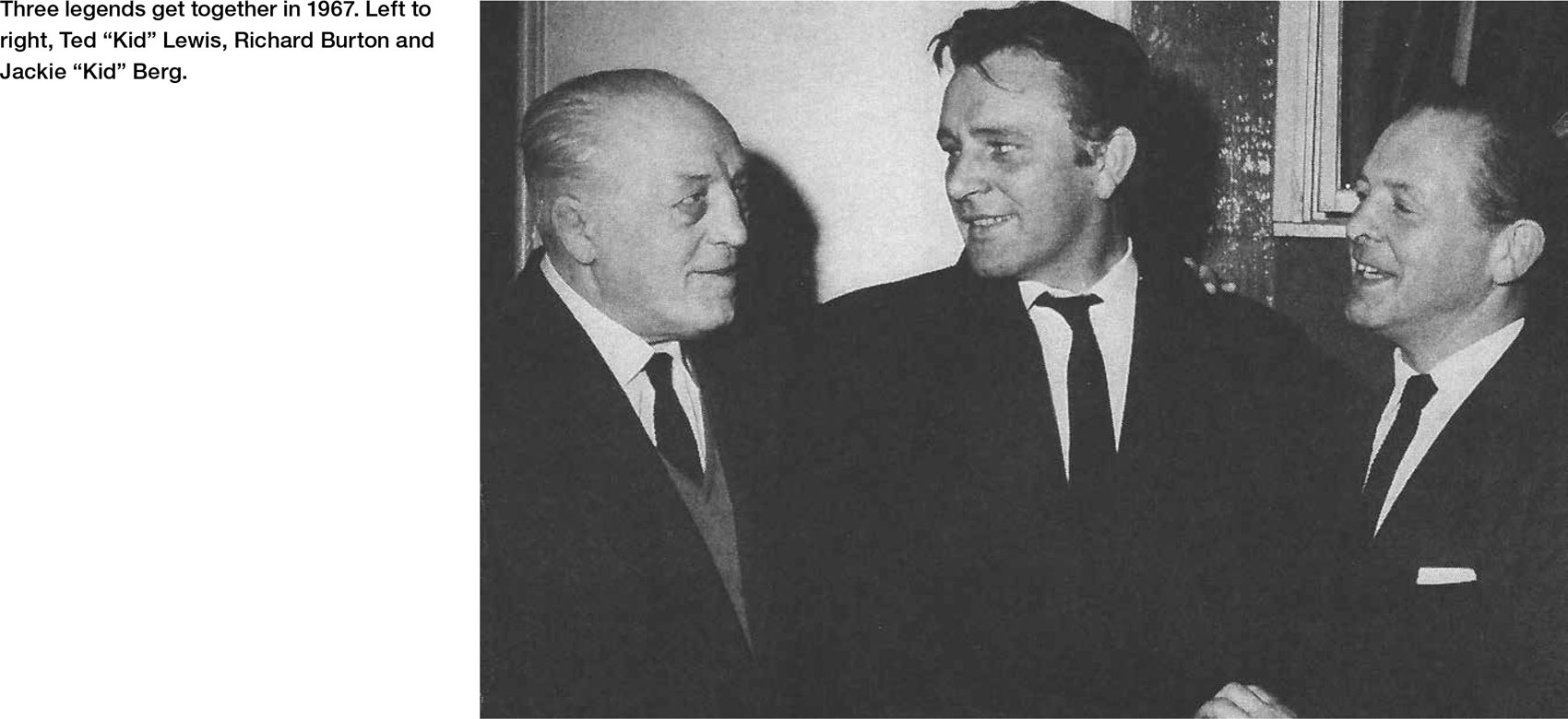
Aside from his world welterweight title Lewis won nine British and European championships from featherweight to light heavyweight. At one point he held the British welterweight, middleweight, and light-heavyweight titles simultaneously despite rarely weighing more than 145 pounds. He thought nothing of conceding 20 or more pounds or venturing into an opponent’s home turf. In addition to Jack Britton, his top opponents included Benny Leonard, Willie Ritchie, Mike O’Dowd, Soldier Bartfield, Brian Downey, Mike Gibbons, Joe Mandot, Italian Joe Gans, Tommy Robson, Georges Carpentier, and “Slapsie Maxie” Rosenbloom.
The indefatigable boxer was well past his prime when he finally decided to retire in 1929 at the age of 35. But he ended his career on a winning note by knocking out old rival Johnny Basham in the third round. The win was just icing on the cake. Lewis had long since earned a reputation as one of the greatest fighters of all time, and in the opinion of many experts, he is the best fighter the British Isles have ever produced.
MARATHON MEN
Of the tens of thousands of professional boxers from 1892 to the present, only 120 of them fought more than 200 times.27 This remarkable group of athletes includes 11 Jewish boxers, eight of whom turned pro prior to 1920. Harry Stone (222 bouts) and Benny Valgar (215 bouts) are the only two boxers in the history of the sport with more than 200 bouts to have never been knocked out or stopped.
Only 16 fighters have ever fought an astounding 300 or more documented professional fights. England’s Ted “Kid” Lewis is the one Jewish fighter in that exclusive club, with “Slapsie Maxie” Rosenbloom just missing, with 297 fights. (The names of Jewish fighters with more than 200 bouts appear in the appendix.)
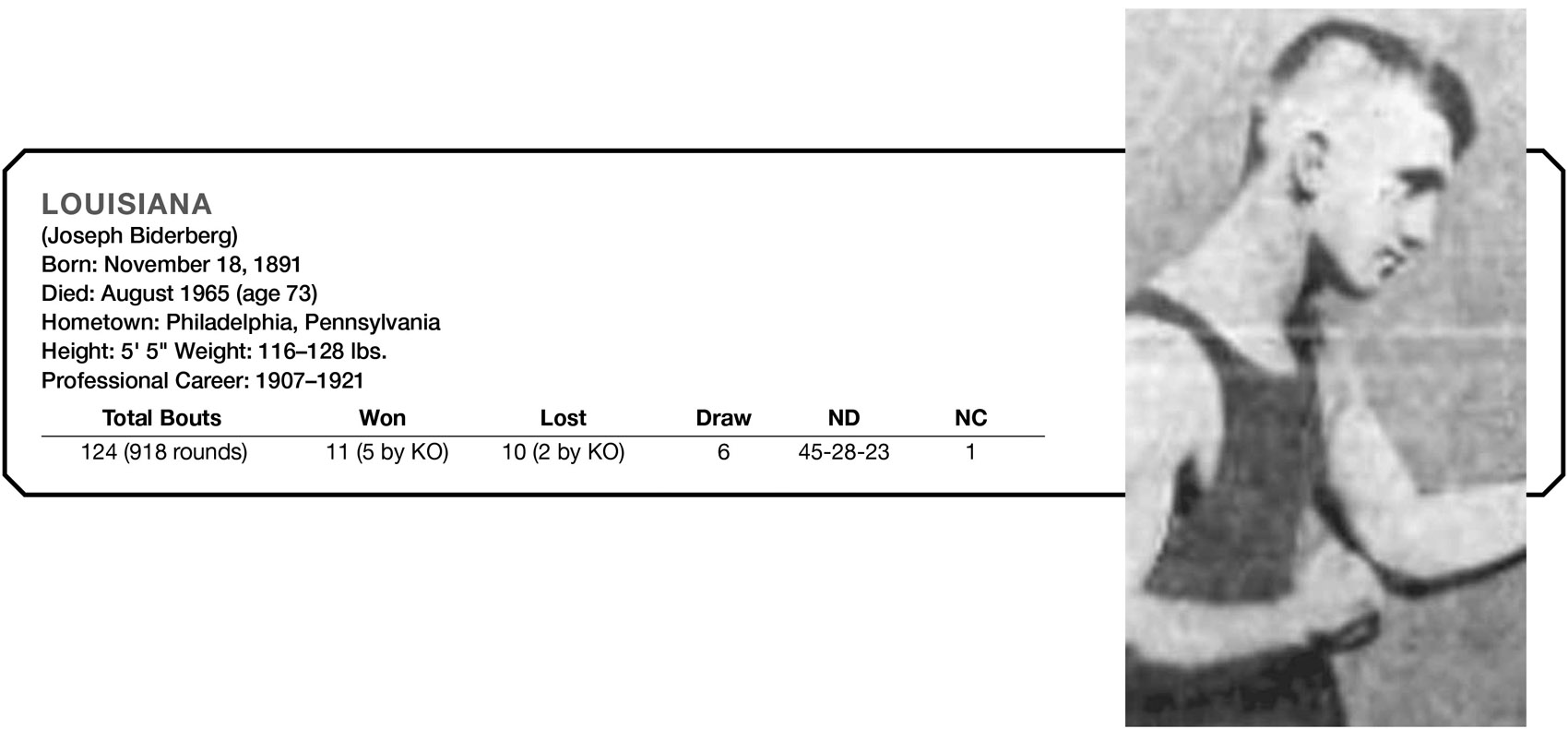
Why a Jewish fighter who was born and bred in Philadelphia would take as his fighting name the state of Louisiana remains a mystery. But aside from his odd but colorful nom de box, Joseph Biderberg, aka, “Louisiana,” was a legitimate world-class boxer. Within three years of turning pro he was competing on even terms with future bantamweight champions Kid Williams, Joe Lynch, Pete Herman, and Monte Attell. Louisiana was fast, clever, and extremely durable. He was stopped just twice in 124 professional bouts. Over the next 11 years, until his retirement in 1921, he added 95 additional fights to his résumé, and was never knocked out. He constantly took on the toughest featherweight and lightweight fighters of his era, and in his prime crossed gloves with such outstanding ring men as Lew Tendler, Willie Jackson, Eddie O’Keefe, Dutch Brandt, Frankie Burns, Eddie Campi, and Sid Smith. Louisiana appeared in the state for which he was named just three times. In one of those fights he lost a 20-round decision to New Orleans’s favorite son, Pete Herman, considered by experts to be one of the greatest bantamweight champions of all time.
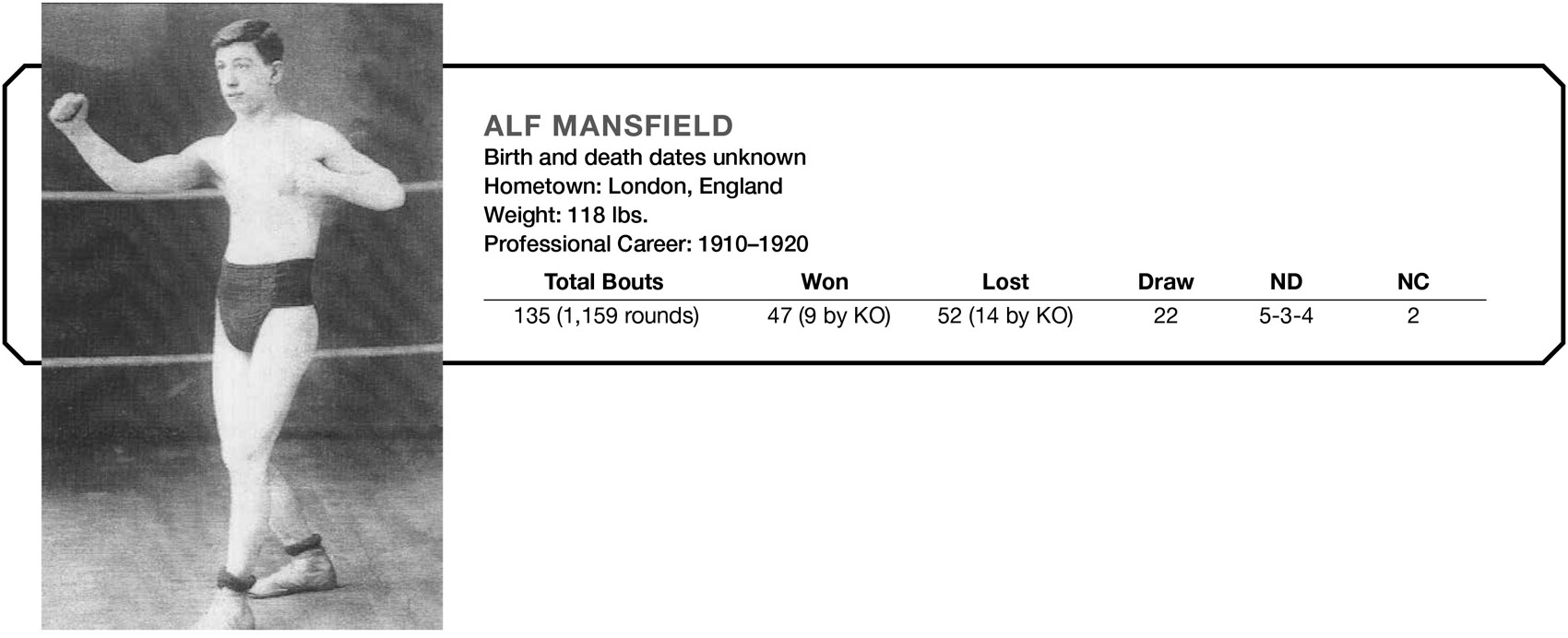
Bantamweight Alf Mansfield crammed 135 bouts into a 10-year boxing career. During his prime he fought competitively against some of the best flyweights and bantamweights in England and America. He lasted the 15-round limit in two bouts with the great flyweight champion Jimmy Wilde, considered by most historians to be the hardest puncher the division has ever known.
In 1916 Alf traveled to America where he crossed gloves with ace featherweight contenders Abe Friedman, Johnny Ertle, Gussie Lewis, Young Diggins, and bantamweight champion Kid Williams (non-title). One year before he retired Alf met flyweight champion Jimmy Wilde for the third time (non-title), and was stopped by “The Mighty Atom” in the 13th round.
Mansfield was forced to hang up his gloves due to failing vision. The condition worsened and he eventually went blind. After he retired Mansfield earned a living by selling embrocation (ointments and salves) to arthritis sufferers.
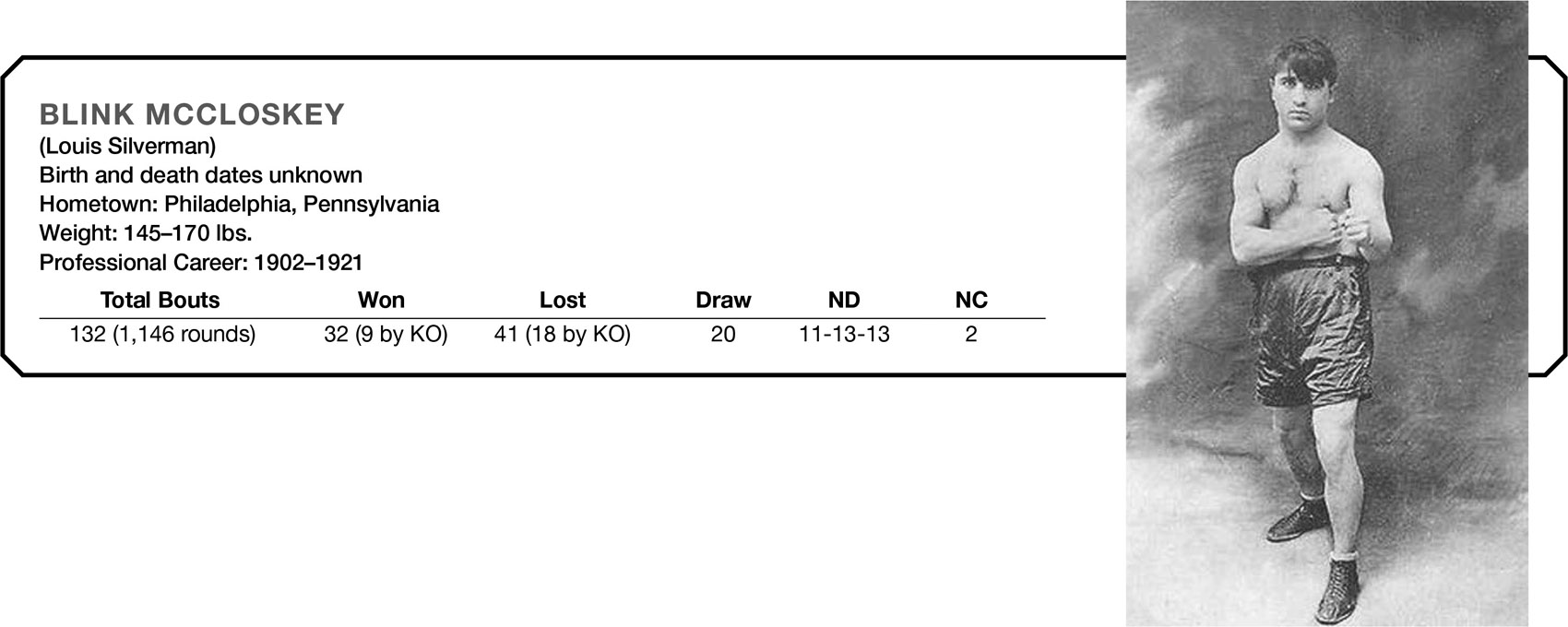
Blink McCloskey’s career is one of the strangest in the annals of boxing history. It would not have been possible in an era of more-stringent medical exams, but was not unusual during a period of lax oversight by whatever boxing authorities (or lack thereof) existed at the time. At some point McCloskey lost the sight in one of his eyes. He refused to retire, instead opting for a cosmetic procedure that removed the damaged orb and replaced it with a prosthetic eye made of glass. Of course he could not fight with a glass eye, so before the bell rang to begin every bout, he carefully removed the eye and handed it over to his corner man for safekeeping— ergo, his nickname, “Blink.”
Blink was not alone in his desire to continue fighting despite this severe handicap. Many other fighters have continued to box despite eye injuries sustained in the ring. The most famous examples are Sam Langford and Harry Greb. Both of these great fighters lost sight in an eye, yet fought for many years thereafter. (Nearing the end of his 24-year boxing career, Langford, one of the greatest fighters who ever lived, had only partial vision in one eye and was totally blind in the other. He only quit when it became obvious he could no longer see his opponents.) It is a sad fact that brain damage and blindness are the two most common occupational hazards for the professional boxer.
Louis Silverman (Blink’s real name) began his pro career in 1902. He had about 80 fights in American rings before becoming a world traveler. Between 1909 and 1921 Blink fought overseas some 50 times, most often in England and France, with occasional appearances in Antwerp, Milan, Rotterdam, Tunis, Algiers, and Alexandria. He once traveled to Madrid to fight exiled heavyweight champion Jack Johnson. (After six rounds, McCloskey did not come out for the seventh, claiming an injury to his right hand.) Other top fighters he traded punches with included Jack Blackburn, Harry Lewis, The Dixie Kid, Willie Fitzgerald, George “Elbows” McFadden, Joe Borrell, and Georges Carpentier.
In 1912 McCloskey fought a scheduled 15-round bout in Paris against American light-heavyweight Bob Scanlon and was knocked out in the eighth round. The New York Times reported that he was unconscious for half an hour. Blink took four months off before entering the ring again for a six-round no-decision bout with Jack McCarron. Two months after that he fought a 10-round no-decision bout with hard-punching middleweight contender, Willie “KO” Brennan. His weight could vary by as much as 20 pounds, but in or out of shape, Blink was always ready for another payday.
McCloskey finally hung up his gloves in 1921 after a 19-year career that encompassed at least 132 professional bouts. His name reappeared in the news two years later when the New York Times reported that he was training an Egyptian prince for a fight with heavyweight champion Jack Dempsey. The prince offered to bet $100,000 that Dempsey could not knock him out. According to the article the boxer had been training secretly for two months under Blink’s direction in the prince’s luxurious apartment on the Champs-Élysées in Paris. McCloskey told the reporter, “The Prince has developed a right-hand blow which he calls the ‘pyramid punch.’ This blow lands with the force of a falling pyramid and knocks a rival stiffer than a sphinx.” Of course the bout never took place, and no one knows what became of the prince.

Alex Rudolph turned pro in 1908 at the tender age of 14. The youngster changed his last name to McCoy to keep his parents from learning about his new avocation. The secret didn’t last long. When his father, a kosher butcher, found out, he forbade his son from ever boxing again. Al’s response was to run away from home. Over the next four years he had 90 professional bouts.
On April 6, 1914, McCoy, a 4–1 underdog, knocked out George Chip in the first round to win the middleweight championship of the world. Not only was the 19-year-old the youngest middleweight champion, he was also the first southpaw to hold a world title.
The new champion put his title on the line many times against top contenders, but always in jurisdictions that only allowed no-decision bouts, so the only way he could lose the title was by a knockout. In at least half a dozen of these fights his opponents were judged to have outpointed him according to newspaper reports. As a result sportswriters began referring to McCoy as a “cheese champion.” In one of those fights the great Harry Greb gave him an awful pasting while trying desperately to win by a knockout. Greb couldn’t do it, and Al retained his title.
McCoy possessed a world-class chin. He had over 100 fights before anyone was able to knock him out. Although his boxing skills were often denigrated, he was good enough to earn draw decisions with future light-heavyweight champion Jack Dillon and welterweight contender Soldier Bartfield. He also outpointed quality middleweights Willie Lewis, Italian Joe Gans, and Joe Borrell.
But the wear and tear of so many fights against top competition in such a short span of time took its toll on the young fighter, and was a factor in his loss of the title to Mike O’Dowd in 1917. O’Dowd dropped McCoy five times before finally putting him out for the full count in the sixth round. It was McCoy’s third knockout loss in 147 fights.
Al McCoy did not deserve the label of “cheese champ.” He stood up to the toughest fighters of his era and gave his all every time.
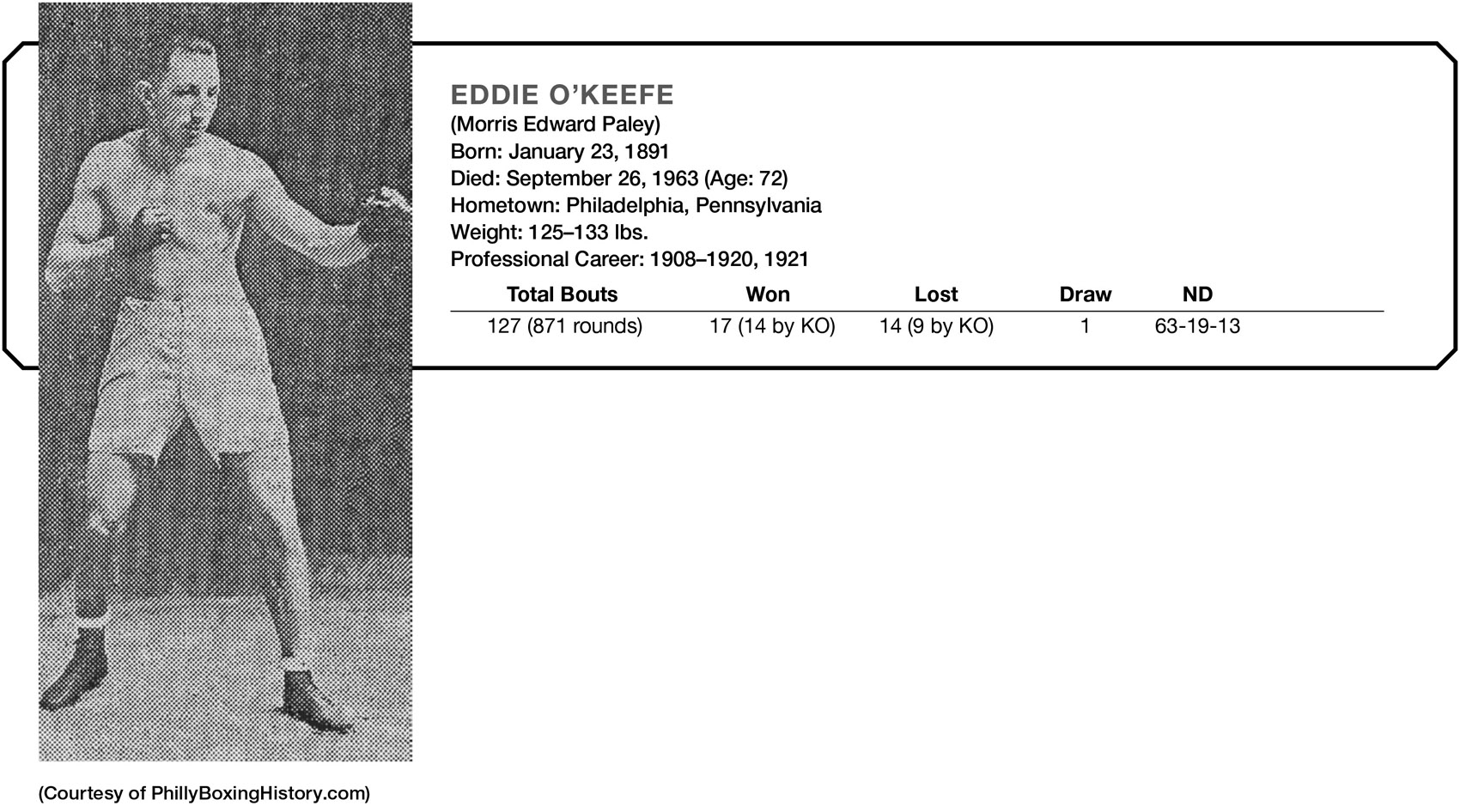
Eddie O’Keefe (né Morris Edward Paley) was one of several outstanding Philadelphia Jewish boxers who adopted Irish names. Brother Ben also fought professionally using the Irish pseudonym “Barney Ford.”
In 1911 Eddie fought a 10-round draw with the great bantamweight champion Johnny Coulon. That fight established his credentials as a serious contender. Showing that he was no flash in the pan, Eddie fought two subsequent non-title bouts with undisputed featherweight kingpin Johnny Kilbane. Both bouts—ten and 12 rounds—went the distance. In the rubber match a year later Kilbane won by a first-round knockout.
Other notable bouts for O’Keefe included newspaper decisions over contenders Harry Forbes, Lew Tendler, Dutch Brandt, Jackie “Kid” Wolfe, and former bantamweight champion Kid Williams. In the final bout of his career he was stopped by future featherweight champion Benny Bass.
After retiring Eddie took a job as a physical training instructor at Philadelphia’s Locust Club. He then served as a boxing coach at the fashionable Tome School at Port Deposit, Maryland. After several years Eddie left Maryland and returned to Philadelphia, where he opened a tavern.
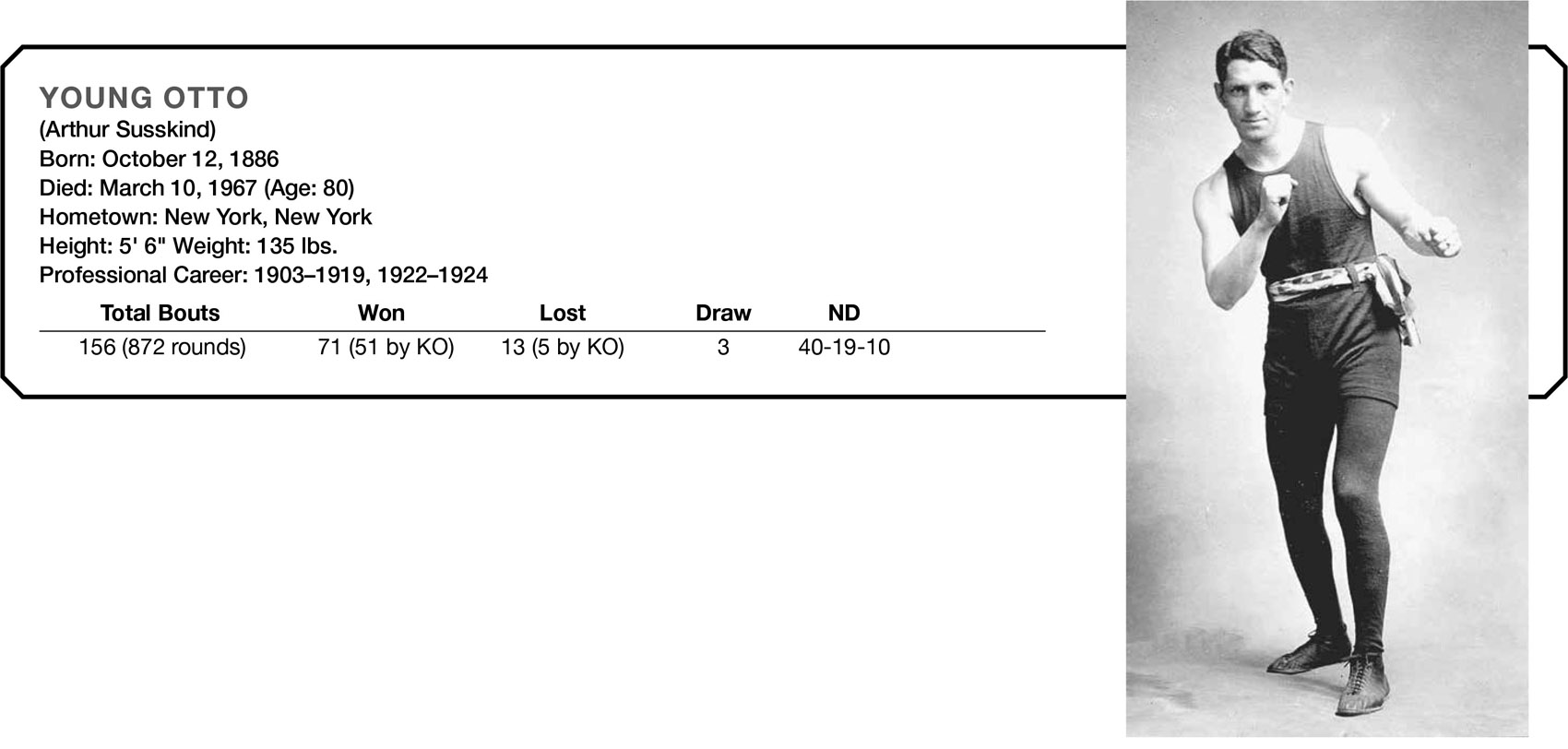
At the opening bell Young Otto would storm out of his corner intent on flattening his opponent before the first round ended. He was quite successful in this regard. In 171 career bouts Otto knocked out 42 opponents in the first round. But this amazing record is misleading. Most of his KO victims were obscure nonentities who were never heard from again. In 1908 Otto stepped up the level of his competition, which resulted in only three knockouts in 11 fights.
On January 21, 1909, a standing-room-only crowd of over 3,000 excited fans crammed into the Bronx’s Fairmont Athletic Club to watch the young KO artist take on top-ranked lightweight contender Leach Cross.
Otto entered the ring with a record of 48 knockouts (28 in the first round) in 85 bouts. Leach had 50 fights and only eight knockouts, but his level of competition was far superior to Otto’s.
Showing respect for his more-experienced opponent, Otto did not go for the quick kill. He boxed cautiously and kept the action at long range while looking for an opening to land his haymaker. In the fifth round Leach turned up the heat and dropped Otto with a right cross to the jaw. He staggered to his feet at the count of eight, but was dropped again by two more rights and took the full count.
Three months later Otto traveled to London where he lost a 20-round decision to Young Joseph, one of England’s top Jewish lightweights. Other quality boxers Otto faced were Leo Houck, Unk Russell, Westside Jimmy Duffy, Joe Fox, and future middleweight champion Al McCoy.
In the 1930s Otto was appointed head coach for New York’s Inter-City Golden Gloves squads. He was also a licensed referee and boxing judge in New York for over 20 years.
JEWISH OLYMPIANS
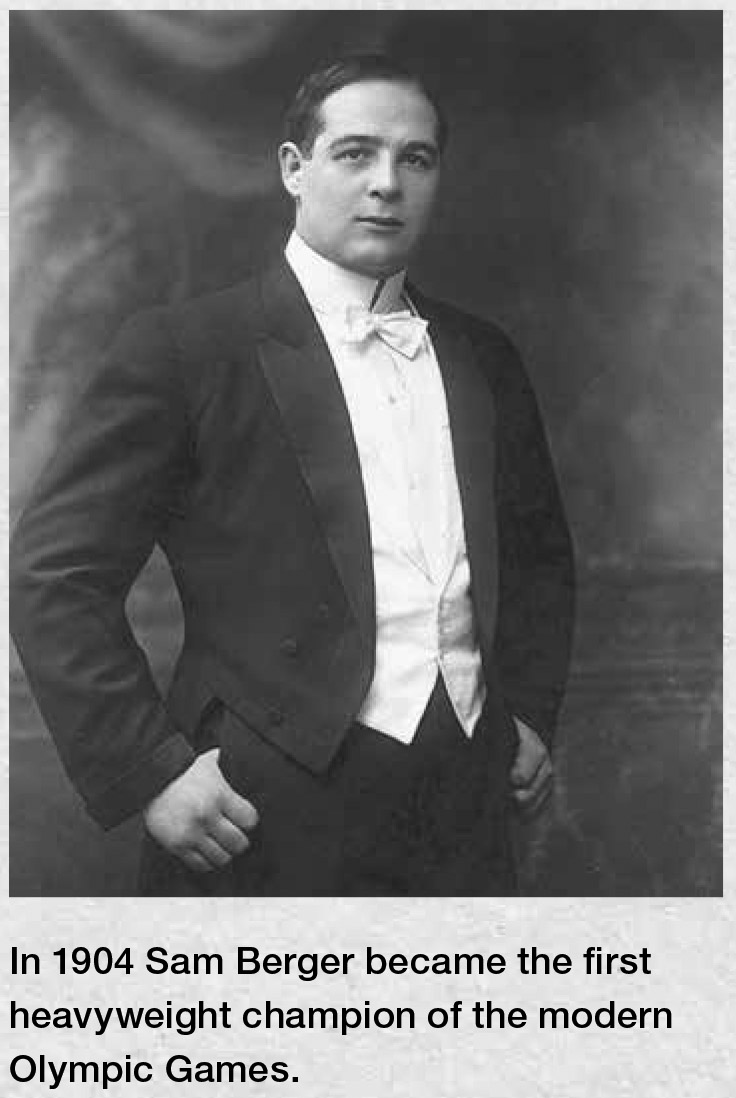
The modern Olympic Games were revived in 1896 after a 1,500-year-hiatus. Boxing, a staple of the ancient games, made its modern debut in 1904 as part of the St. Louis World’s Fair. Except for 1912, the sport has been featured in every Olympic Games since then. Sam Berger, a 6’ 3”, 200-pound amateur from San Francisco, won the gold medal in 1904, thus becoming the first heavyweight champion of the modern Games, and the first of seven Jewish boxers to win an Olympic gold medal. Sixteen-year-old Jackie Fields (Jacob Finkelstein), the 1924 champion, was the youngest boxer to ever win a gold medal, and is the only Jewish Olympic champion to later win a professional title.
The Olympic Games were not held during the war years of 1916, 1940, and 1944. Since 1948, the Games have been staged in different countries every four years.
Between 1960 and 1980, three Jewish gold medal winners hailed from Soviet Bloc countries. It is believed there may have been other Jewish medalists from the Soviet Union who purposely kept their religious background hidden because of the anti-Semitic policies of the Soviet government. (The names of thirteen Jewish boxers who won an Olympic medal appear in the appendix.)
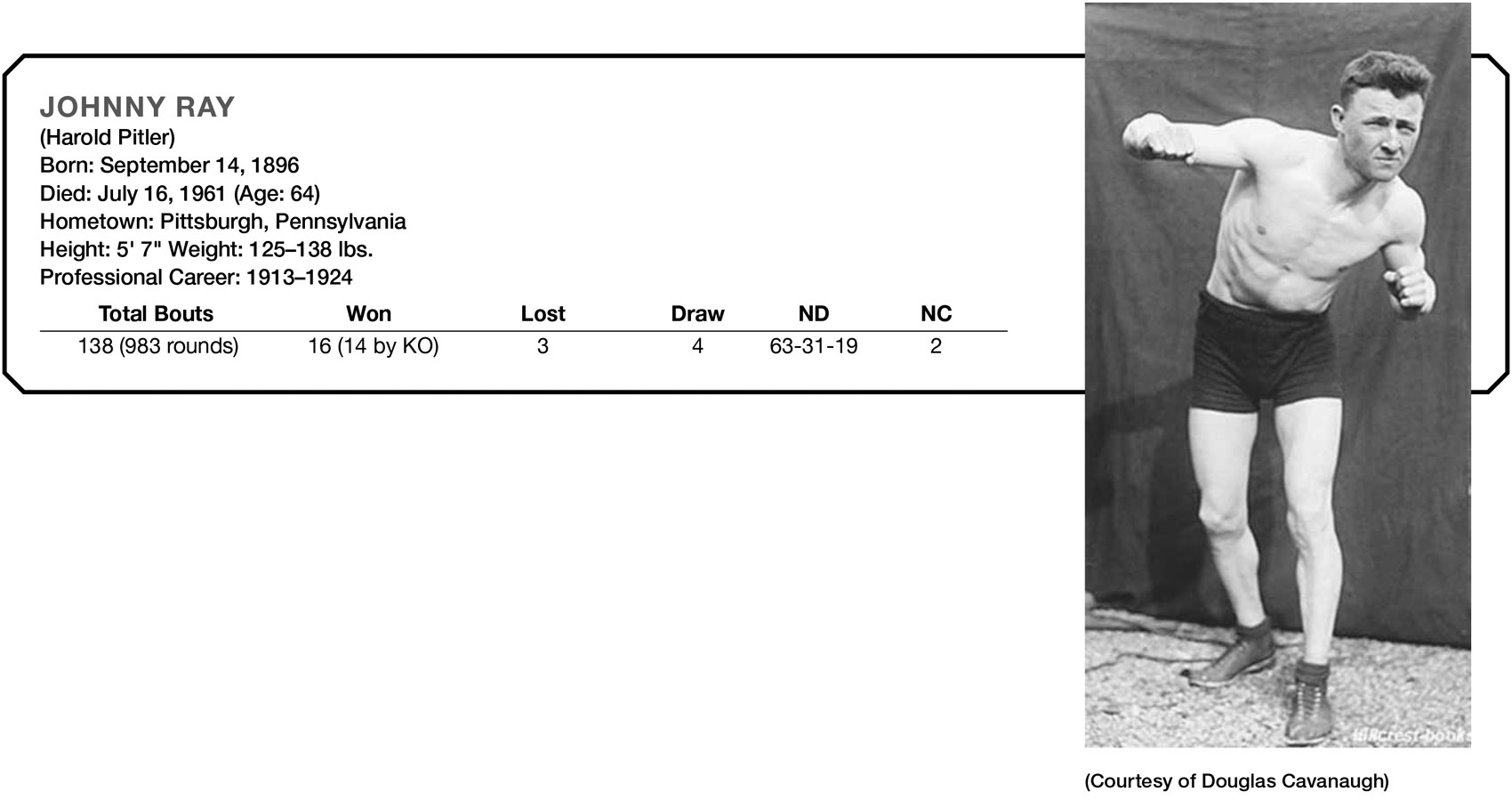
Before he turned pro in 1913, Harry Pitler’s manager, Red Mason, suggested he could improve his box-office appeal by adopting an Irish name. So young Harry decided to combine the names of a popular vaudeville team he enjoyed, Johnny and Emma Ray. He retained the name “Johnny Ray” for the rest of his life.
In the years following his service with the US Navy in World War I, Johnny Ray established a reputation as an outstanding contender and one of the best lightweight boxers to ever come out of Pittsburgh. He was a stablemate of the great middleweight champion Harry Greb (“The Pittsburgh Windmill”), and often fought on the same cards with Greb.
Ray had 138 documented bouts and was never knocked out. At five-foot-seven, he was taller than most of his opponents, and made good use of his height and reach advantages.
After he retired in 1924 Ray became a successful manager and trainer. His most famous pupil was the great light-heavyweight champion Billy Conn, who ruled the division from 1939 to 1941. Conn came very close to upsetting heavyweight champion Joe Louis before taking the count in the 13th round. Ahead on points after 12 rounds, Conn made the fatal mistake of trying to knock out Louis after hurting him in the previous round. Instead of playing it safe against the always-dangerous Louis and settling for a decision victory, he went on the offensive and was caught by a series of devastating punches, thus ending one of the greatest heavyweight championship contests of all time. In his dressing room after the fight Conn explained his audacious behavior: “What’s the use of being Irish if you can’t be thick?” His trainer’s quote: “If Billy had a Jewish head instead of an Irish one, he’d be the champ.”28
In the 1950s Ray became matchmaker at Detroit’s Motor Square Arena. His brother, Jake Pitler, was a former professional baseball player and a longtime member of the Brooklyn Dodgers’ coaching staff.

On April 24, 1916, Johnny Rosner became the first American to challenge for the world’s flyweight title when he traveled to Liverpool, England, for a 20-round bout with the great Jimmy Wilde. Nicknamed “The Mighty Atom” because of his explosive power (he scored 98 knockouts), Wilde is still considered by many experts to be the greatest flyweight champion of all time.
In a torrid seesaw battle Rosner suffered a cut to his eyelid in the 11th round. If the cut worsened he risked permanent damage to his sight. Eugene Corri, the most respected referee in Europe, correctly stopped the action and awarded the bout to Wilde. Although bitterly disappointed, Rosner was gracious in defeat. The British fans cheered his sportsmanship and gave him a rousing ovation. Rosner’s end of the purse came to $2,800, the largest of his career.
Following his return to America Rosner won a 12-round decision over Young Montreal (Morris Billingkoff). Six days later he appeared in Philadelphia for a six-round no-decision bout with Al Murray. The very next day Rosner faced Young Zulu Kid (Giuseppe Di Melfi) for the American flyweight title. It was the seventh meeting between these two miniature maulers. While all of their previous encounters had gone the distance, this time Rosner won by a seventh-round TKO.
In addition to Wilde, Rosner boxed the greatest flyweight and bantamweight boxers of his era, including Johnny Buff, Pete Herman, Young Montreal, Abe “Kid” Goodman, Young Zulu Kid, Frankie Mason, Battling Murray, and future flyweight champion Frankie Genaro. He retired in 1923 after losing a 10-round decision to Genaro.
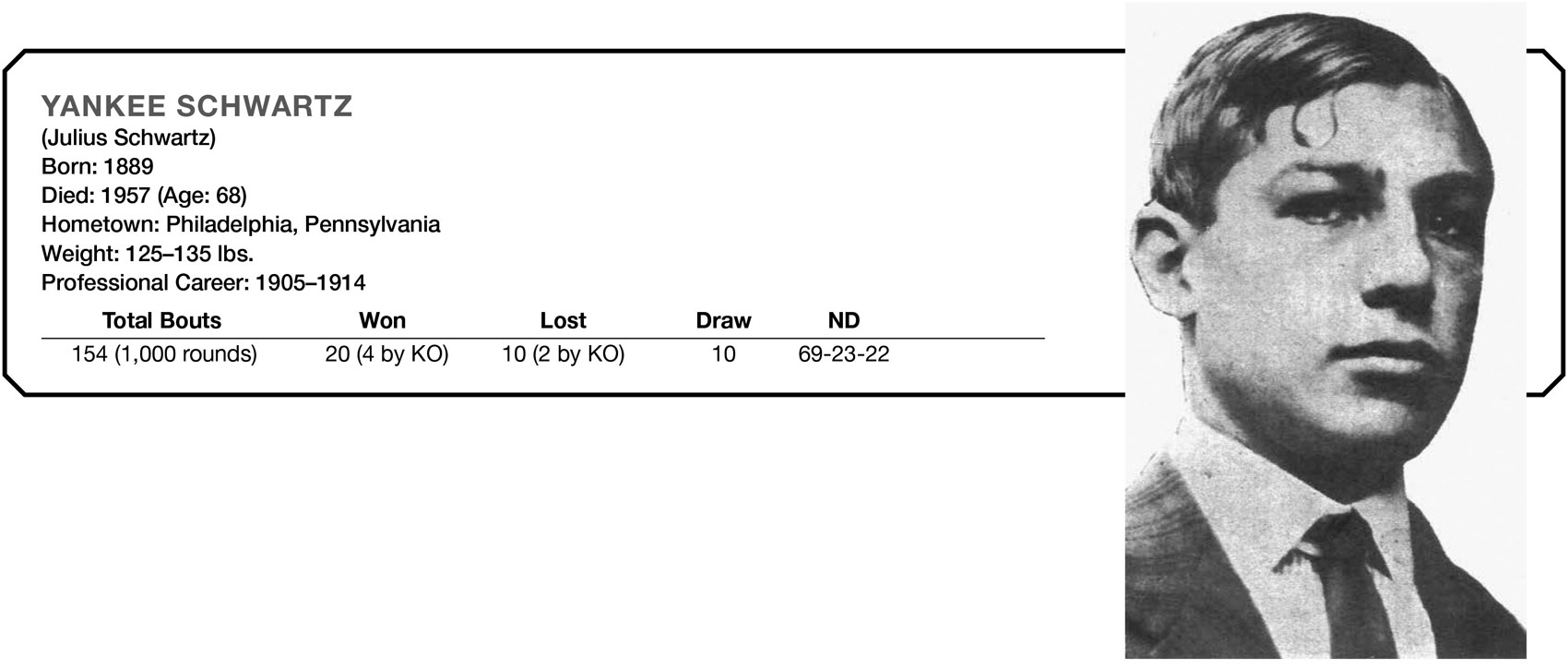
Julius “Yankee” Schwartz was born in Russia and emigrated to the United States with his family in the early 1890s. In 1905 he accompanied his father, a jewelry merchant, on a trip to South Africa’s diamond market. Julius stayed in South Africa for almost three years. At some point he began boxing in Cape Town, where he fought at least eight preliminary bouts. Locals dubbed him “Yankee,” and the nickname stuck.
In 1907 Yankee returned to Philadelphia and continued with his boxing career. He was mentored by future ring great Jack Britton, so it is not surprising that newspaper reports of his fights describe graceful footwork, clever feints, and an educated left jab—all hallmarks of the Britton style of boxing.
In only his 31st pro bout Yankee fought a sixround no-decision scrap with the great bantamweight champion Johnny Coulon. One of two newspapers covering the bout gave the decision to Schwartz. Yankee also won unofficial newspaper verdicts over Patsy Brannigan, Willie Houck, and future lightweight champion Freddie Welsh. He came away with mixed results in a series of bouts against Pal Moore, Joe Mandot, and Jake Abel—all top-rated boxers.
By 1912 Yankee had outgrown the 125- pound division and was now fighting as a lightweight. But his chance to fight for the 135-pound title was thwarted when future champion Willie Ritchie knocked him out in the second round. It was only Yankee’s second knockout loss in 153 professional bouts. He retired two years later.
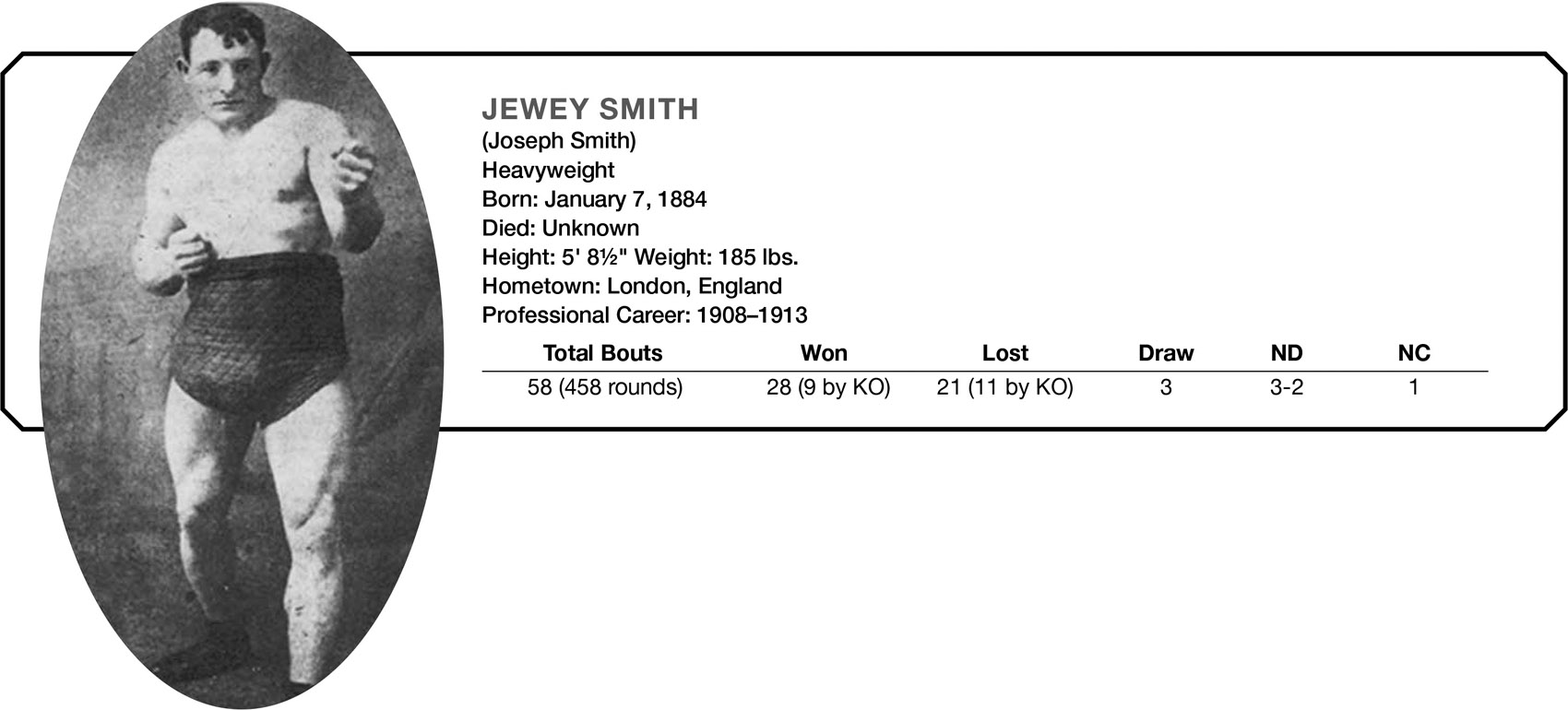
Jewey Smith, a former sailor in the Royal Navy, was the first Jewish boxer of the Queensberry era to challenge for the heavyweight championship. That historic distinction earns him a place in this compendium. On April 4, 1908, in London, Smith challenged heavyweight champion Tommy Burns and was knocked out in the fifth round.
Many of Smith’s early fights have not been documented. What is available shows that he did not have a winning record against the top fighters of his era (he was knocked out by Sam McVea, Joe Jeanette, and Willie Lewis), but performed credibly against second-tier competition. His best performance was a 20-round decision over England’s Iron Hague, after which he claimed the British heavyweight title. He subsequently lost to Hague in two return bouts. In 1911 Smith traveled to America and engaged in a series of bouts before returning to England, where he finished out his career.
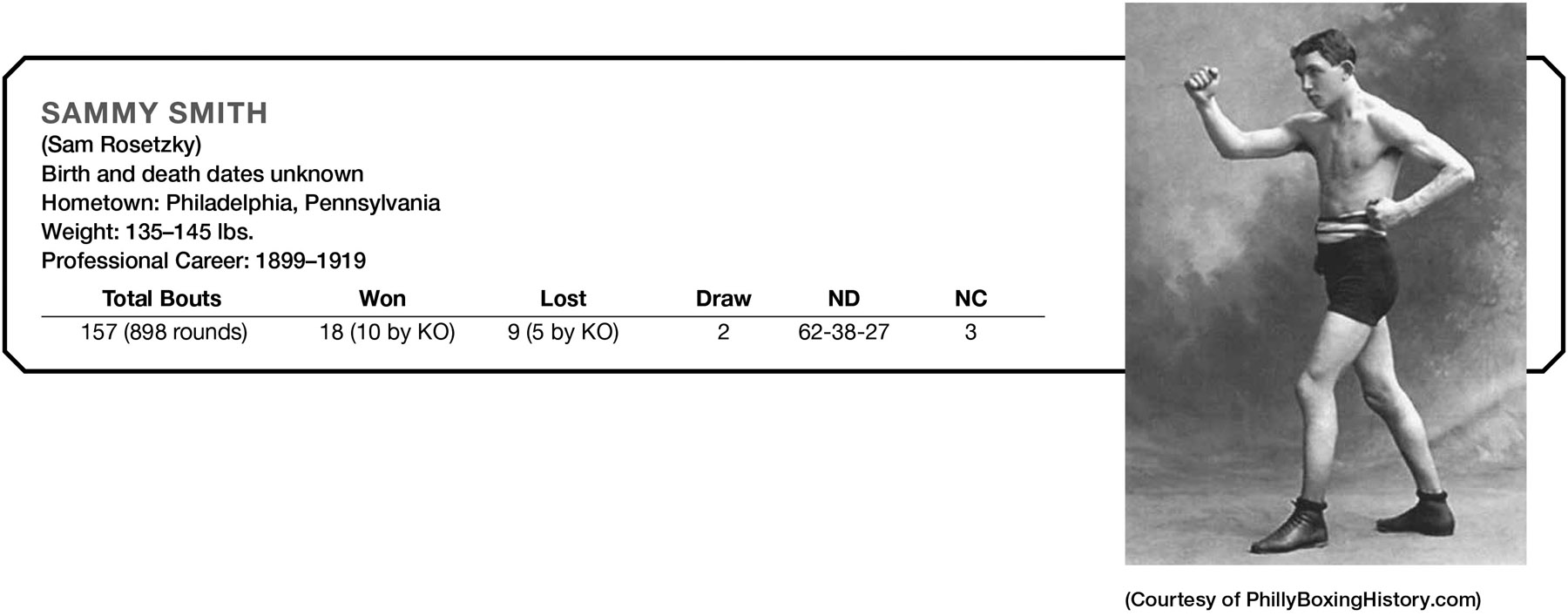
Over the course of his 20-year career Philadelphia’s Sammy Smith swapped punches with world champions Joe Gans, Harry Lewis, Young Corbett II, and Dave Rosenberg. He fought in both the lightweight and welterweight divisions. Joe Gans, one of the greatest lightweight fighters who ever lived, was one of only two fighters able to stop Smith during his prime. Other notable opponents included Joe Bernstein, Leach Cross, Harlem Tommy Murphy, Patsy Haley, and Young Otto.
Sammy is the older brother of “Young Sammy Smith” (Isaac Rosetzky), a popular welterweight contender who was active between 1908 and 1913. The Smith brothers were among Philadelphia’s first Jewish boxing stars.

In 1911, only two years after turning pro, Sid Smith won the British Empire flyweight title and successfully defended it twice. Two years later he won a 20-round decision over France’s Eugène Criqui to win the world flyweight championship (weight limit, 112 pounds) as recognized by Great Britain and the International Boxing Union. (At the time there was no flyweight division in the United States.) Less than seven weeks after defeating Criqui, Smith lost the title to Bill Ladbury via an 11th-round TKO.
Smith’s nemesis was the great “Mighty Atom,” Jimmy Wilde. Smith was stopped three times by the dynamic little Welshman. Their last fight occurred nine months before Wilde won the flyweight championship.
After he retired from boxing, Smith was plagued by health problems. For work he would go around guessing people’s weight for money.

Harry Stone belongs to a very exclusive club. He is one of only two boxers (the other is Benny Valgar) known to have fought over 200 documented bouts without ever being stopped. Stone is officially credited with 219 bouts, although the actual number is probably much higher. He can also lay claim to another first: Harry was the first boxer to wear a tallis (prayer shawl) into a boxing ring.
In 1909, barely three years into his pro career, Harry fought a competitive 10-round no-decision bout (non-title) with the great featherweight champion Abe Attell. Two months later he came up even after 15 rounds with top contender Leach Cross. But his most impressive victory occurred in Australia, where he won a 20-round decision over future welterweight champion Matt Wells.
Harry was tremedously popular with Aussie fans. According to British boxing historian Barry Hugman, Stone was a claimant to the Welterweight Championship of the World between 1914 and 1916. The claim was dismissed on March 1, 1916, after Stone dropped a 20-round decision to the widely recognized welterweight champion Ted “Kid” Lewis in New Orleans. Harry was an experienced boxer and almost impossible to hurt, but he was out of his league against the great Lewis.
After he failed in his bid to win the welterweight championship, Harry returned to Australia. He remained Down Under for the next 10 years, and had over 100 fights, most of 20 rounds’ duration. Harry was a true iron man of the ring. His record shows that he once fought three 20-rounders in one week. In the last two months of his hectic career, at age 40, he fought two 15-round battles just five weeks apart.
After he retired in 1929, Harry decided to make his home in Australia. He married a local girl and remained there for the rest of his life. For many years he owned and operated a garage in Sydney.
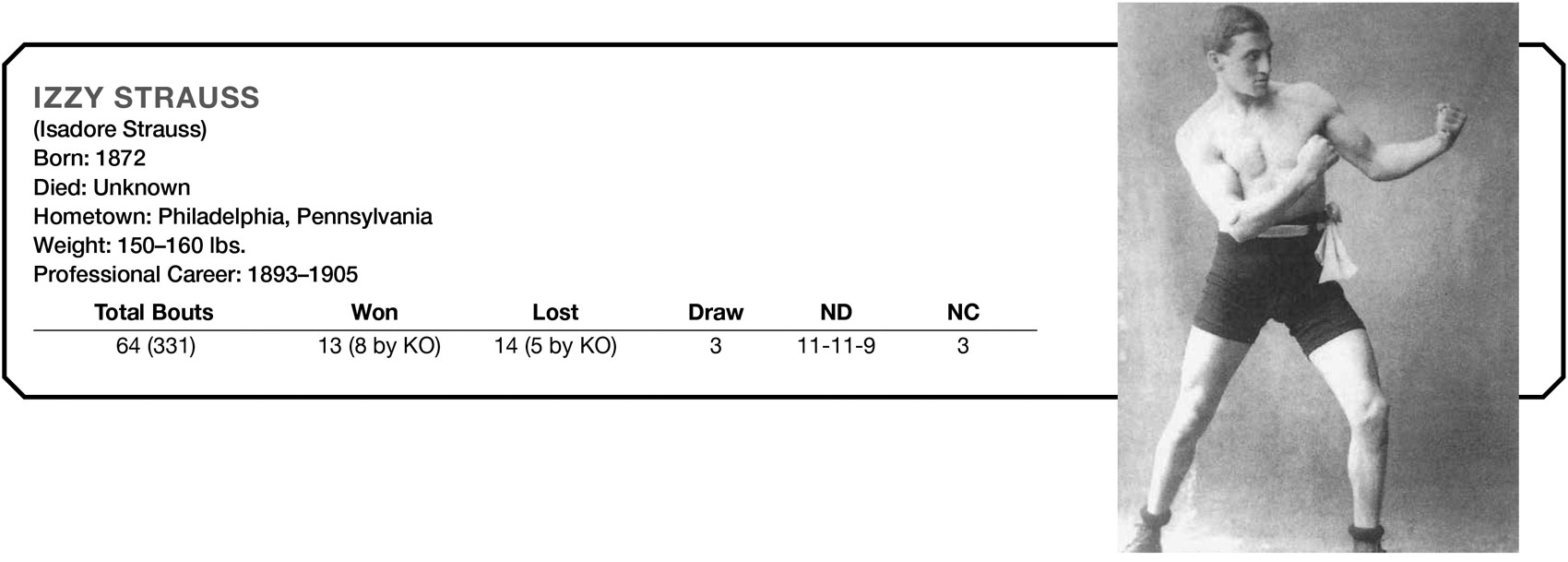
Izzy Strauss was Philadelphia’s first Jewish boxing star. He turned pro in the early 1890s, and is officially credited with 64 bouts. Izzy fought in both the welterweight and middleweight divisions. He crossed gloves with four future world champions: Philadelphia Jack O’Brien (four times), Joe Gans, Rube Ferns, and Matty Mathews (twice). Other top opponents included Kid Carter, Owen Ziegler, and Jack Bennett.
Except for an occasional out-of-town appearance, virtually all of Izzy’s fights took place in Philadelphia, where he remained a popular attraction until his retirement in 1905.
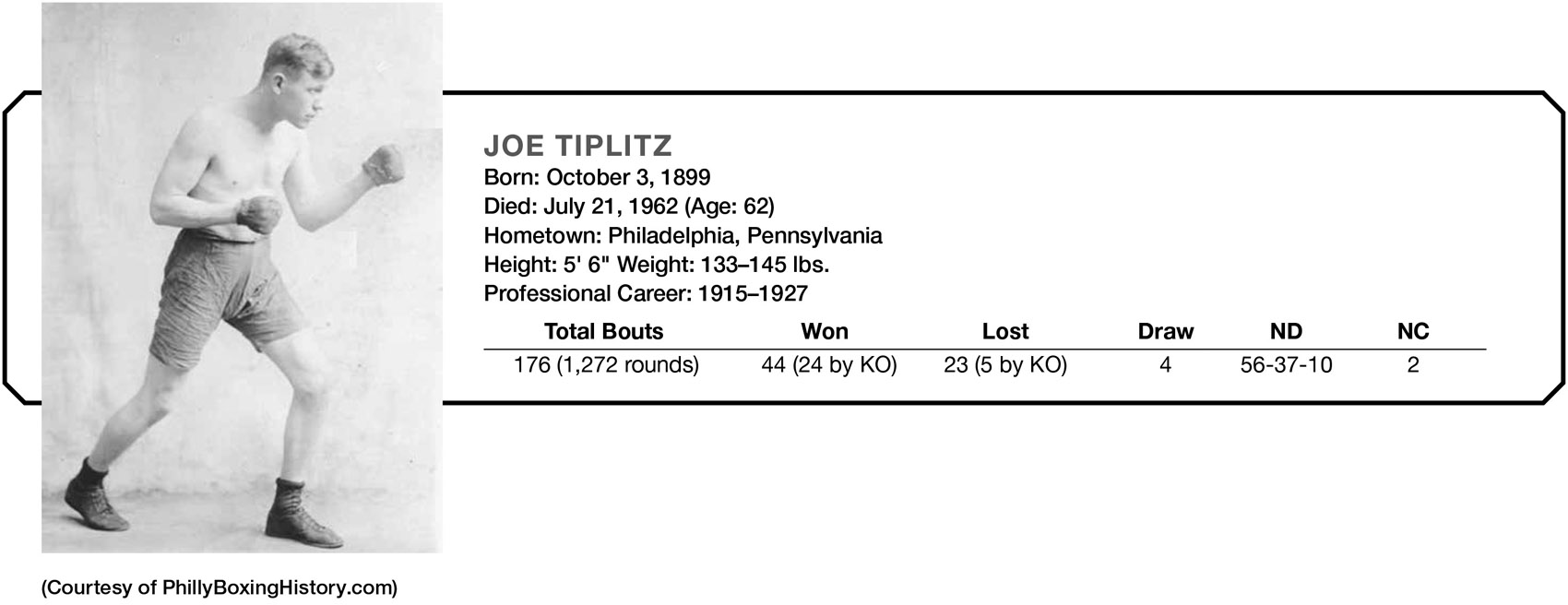
In the vernacular of the boxing trade, Philadelphia’s Joe Tiplitz “fought ’em all.” Numbered among his 177 opponents were world champions Johnny Dundee, Willie Ritchie, Rocky Kansas, Joe Dundee, and top contenders Lew Tendler, Benny Valgar, George KO Chaney, Packy Hommey, and Ritchie Mitchell.
The Russian-born Tiplitz averaged over 15 bouts a year, and went through his first 161 bouts without ever being stopped. But like so many fighters he overstayed his welcome and paid the price for fighting well beyond his prime. In the last few months of his busy career, Tiplitz suffered five knockout losses, the last four in a row.
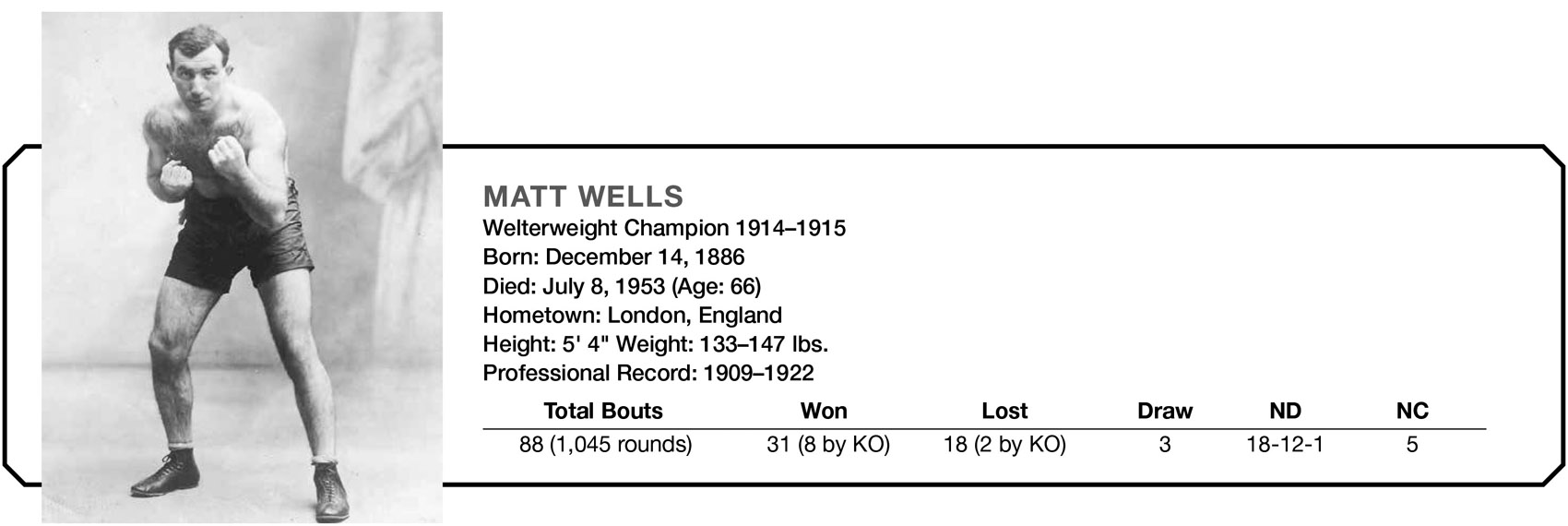
Before Matt Wells turned pro he was one of England’s finest amateur boxers, winning three consecutive British lightweight titles. He also represented his country in the 1908 Olympic Games, losing a close decision in the lightweight class to the eventual gold medal winner, fellow Englishman Fred Grace.
Wells won 32 of his first 34 pro fights, including 20-round decisions over Owen Moran and Freddie Welsh, two of England’s greatest fighters. By defeating Welsh he won both the British and European lightweight title and became the first Jewish fighter to win the prestigious Lonsdale Belt.
Wells made frequent trips to New York where he faced, among others, Leach Cross, Knockout Brown, Packey McFarland, Pal Moore, Charley White, Johnny Dundee, Ted “Kid” Lewis, Johnny Basham, and Phil Bloom. In 1911 he fought the great featherweight champion Abe Attell in a 10-round no decision bout. The following day most newspapers reported Wells the clear winner.
During a tour of Australia in 1914, Wells outpointed welterweight champion Tom McCormick in 20 rounds, thus becoming the second English-born Jewish fighter to win a world title in the twentieth century. (The first was Sid Smith.) 15 months later Wells lost the title on a 12-round decision to Mike Glover in the challenger’s hometown of Boston.
Ted “Kid” Lewis and Charley White were the only opponents able to stop him. Both fights occurred near the end of Matt’s career. His low knockout ratio (eight KOs in 88 fights) is misleading. It says less about his punching power than it does about the quality of opponents he faced. Matt Wells consistently fought men who were rarely knocked out by anyone.
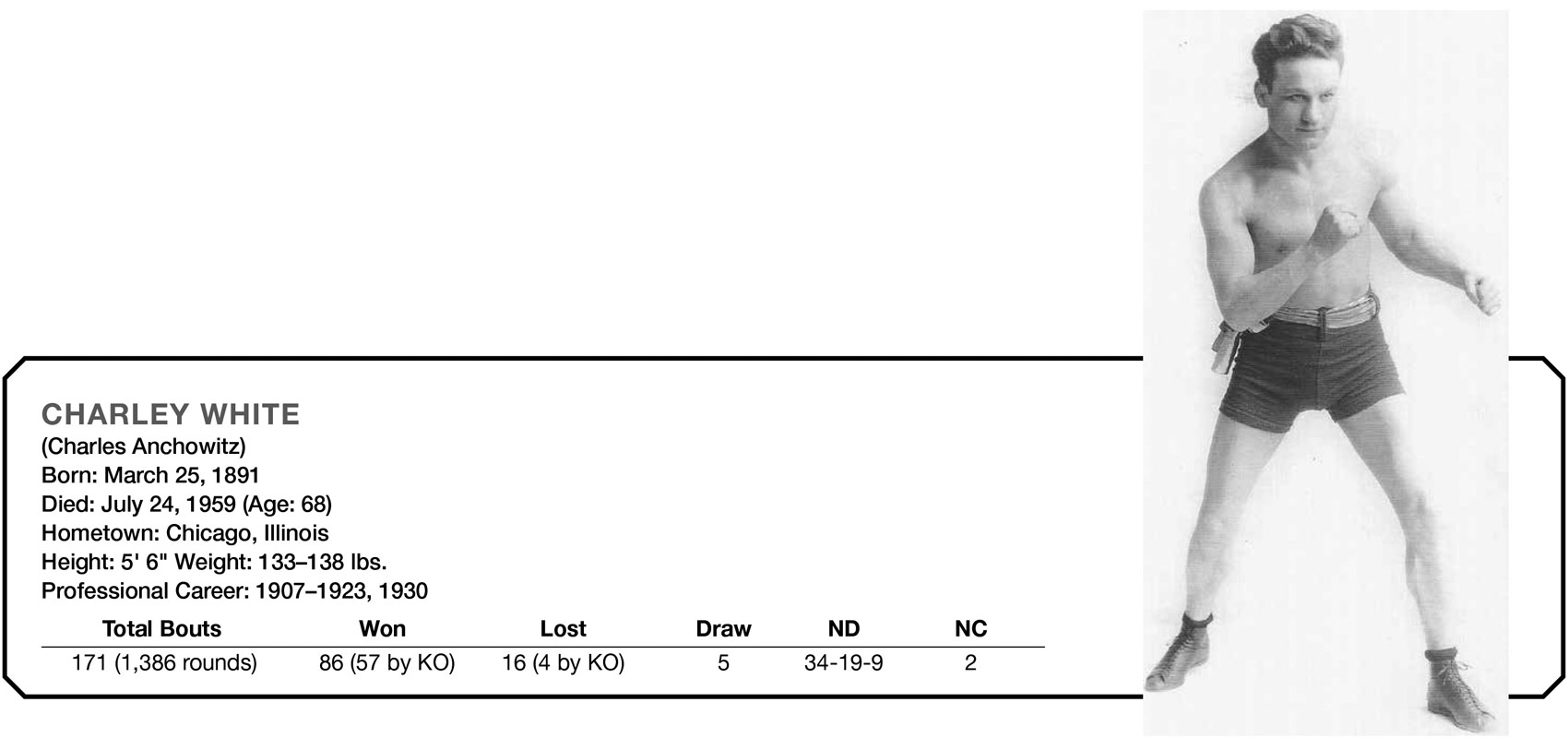
If anyone deserves the title of “uncrowned champion,” it is Charley White. In 1914 White dominated lightweight champion Willie Ritchie in a 10-round no-decision bout. Two years later he clearly outpointed Ritchie’s successor, Freddie Welsh, in a 20-round bout. Charley’s misfortune was to have fought both men in states that adhered to the no-decision rule requiring a knockout to dethrone a world champion.
Charles Anchowitz was born in Liverpool, England, and came to the Jewish ghetto on Chicago’s West Side at an early age. In 1906 the 15-year-old changed his last name to White and began a professional boxing career. His brothers, Jack White and Billy Wagner, were also professional fighters.
White’s trademark punch, a devastating left hook, knocked out 58 opponents. After sampling his portside wallop, lightweight champion Benny Leonard was nearly blasted out of the ring in the fifth round of their 1920 title bout. But Leonard recovered and flattened White in the ninth round.
The record books reveal that White fought 13 world champions a total of 22 times. Among his 174 opponents were legendary fighters Abe Attell, Freddie Welsh, Johnny Kilbane, Johnny Dundee, Owen Moran, Jack Britton, Ad Wolgast, Ted “Kid” Lewis, Leach Cross, and Benny Leonard—a breathtaking array of all-time greats.
White retired in 1923, but seven years later, at the age of 39, made an ill-advised comeback and was stopped in the second round by Chicago rival Herman Perlick.
After hanging up his gloves White operated a successful gym in Chicago’s Loop district, which catered to wealthy women. He subsequently relocated to Los Angeles, where he trained movie stars. In his sixties, the countless punches of 171 professional fights caught up with him. White was diagnosed with dementia pugilistica and committed to a sanitarium.
In 1958 Nat Fleischer, publisher of The Ring, ranked Charley White the 10th-greatest lightweight of all time.
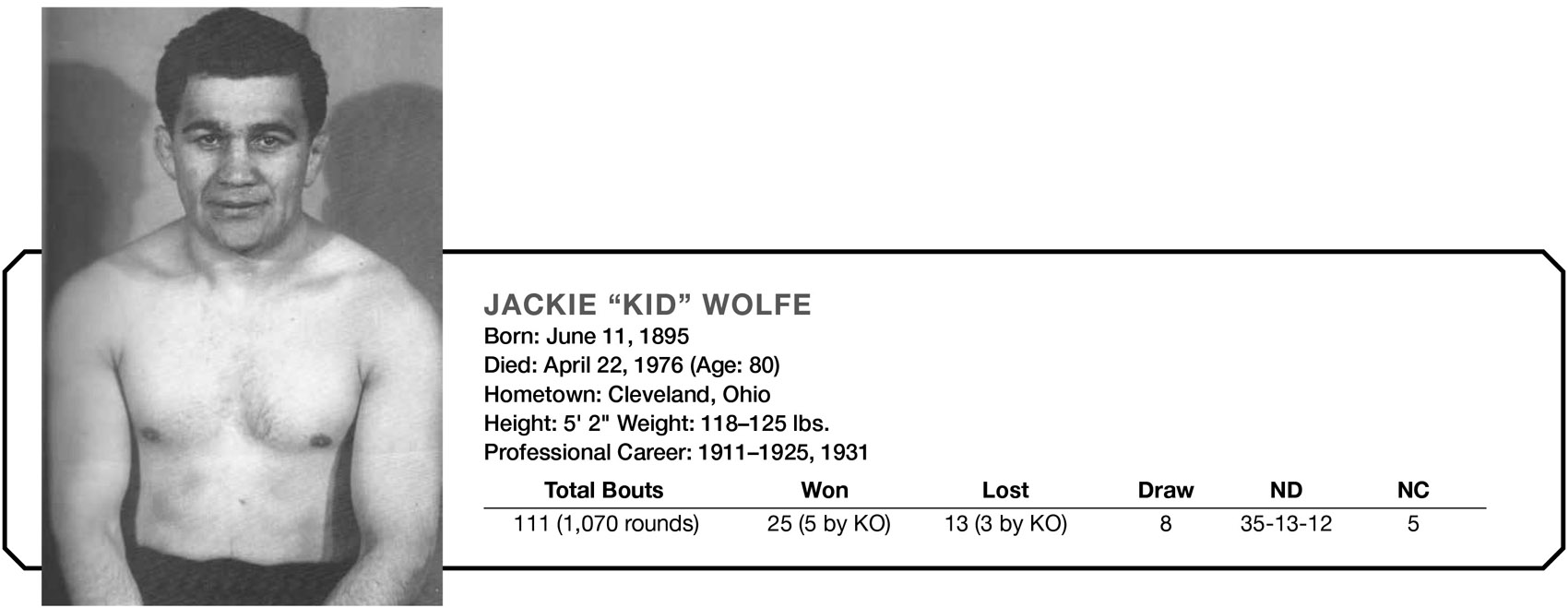
The problem for Jackie “Kid” Wolfe—as with so many other small boxers of his era—was the huge number of similarly talented bantamweights and featherweights. Jackie fought during a time of fierce competition in the lighter weight divisions. Nevertheless, he was good enough to defeat the likes of Frankie Jerome, Young Montreal, and former bantamweight champion Kid Williams. He is also credited with newspaper decisions over Johnny Ertle, Joe Burman, and bantamweight champion Pete Herman (non-title).
In 1922 Jackie fought former bantamweight champion Joe Lynch for the fourth time. Three previous encounters were closely contested nodecisions bouts. Newspaper verdicts had Wolfe leading the series, two to one. Their final bout was a 15-rounder in New York’s Madison Square Garden. This time the contest would be officially scored. The promoter tried to generate interest by advertising the fight as a competition for the “junior featherweight championship of the world”—a new weight division with a limit of 122 pounds.
Jackie won a hard-fought 15-round decision over one of the best bantamweight boxers of the decade, but his title was not recognized by the New York boxing commission, or any other governing body, for that matter. Most fans did not consider the new weight division as legitimate or necessary, since it was only four pounds below featherweight (126 pounds) and four pounds above bantamweight (118 pounds). The “junior featherweight” championship never took off and was soon discarded. But with or without a title, Jackie “Kid” Wolfe’s impressive record proved beyond a doubt that he was a championship-caliber boxer.*
Footnotes
* Not to be confused with non-Jewish boxer Frankie Callahan, who fought out of Columbus, Ohio.
* A “club fighter” was a boxer active in the many “fight clubs,” or smaller boxing arenas, that were common at the time. A good club fighter was not quite good enough to beat the best, but always gave a performance that pleased the fans.
* Some 50 years later, the “junior featherweight” title would be revived (along with five other unnecessary weight divisions) by a group of corrupt quasi-official boxing organizations in order to extort “sanctioning fees” from boxers competing for the newly manufactured titles.